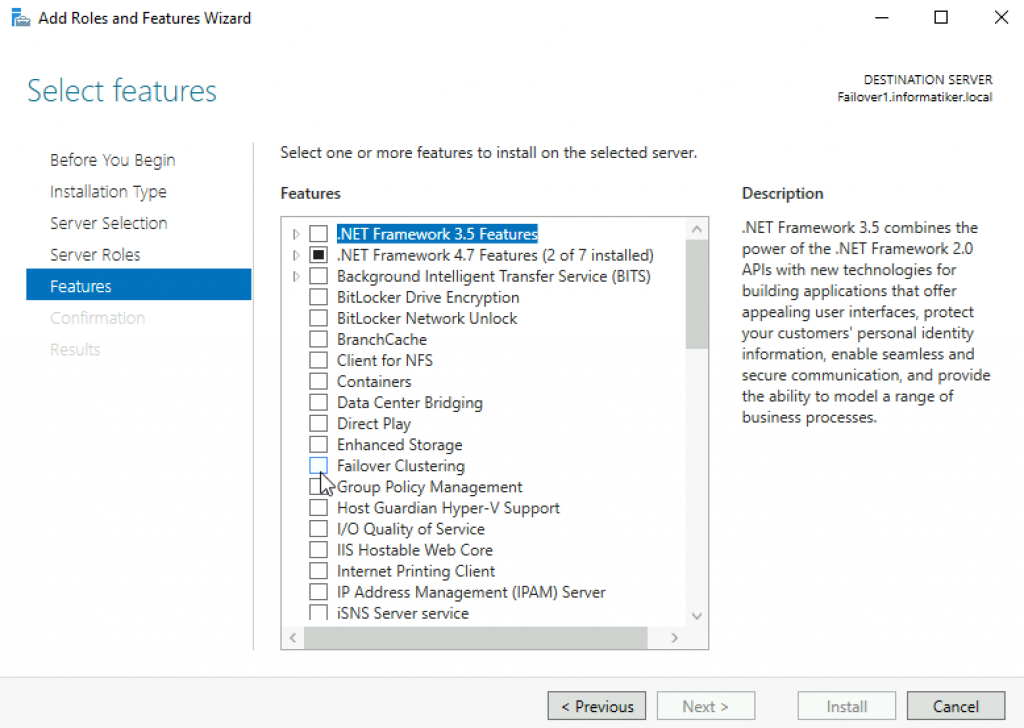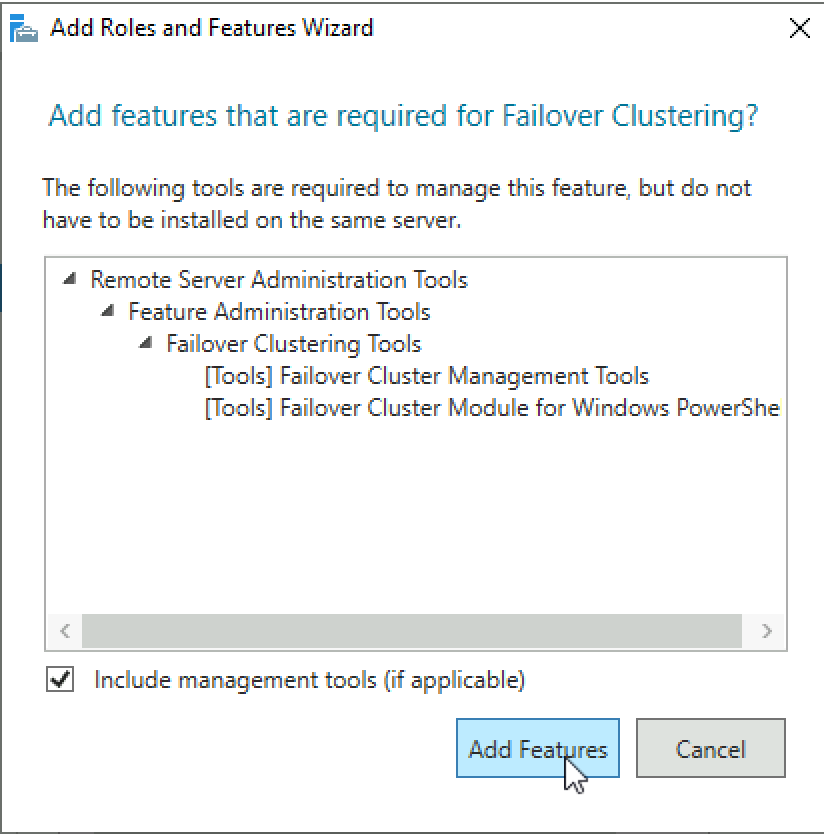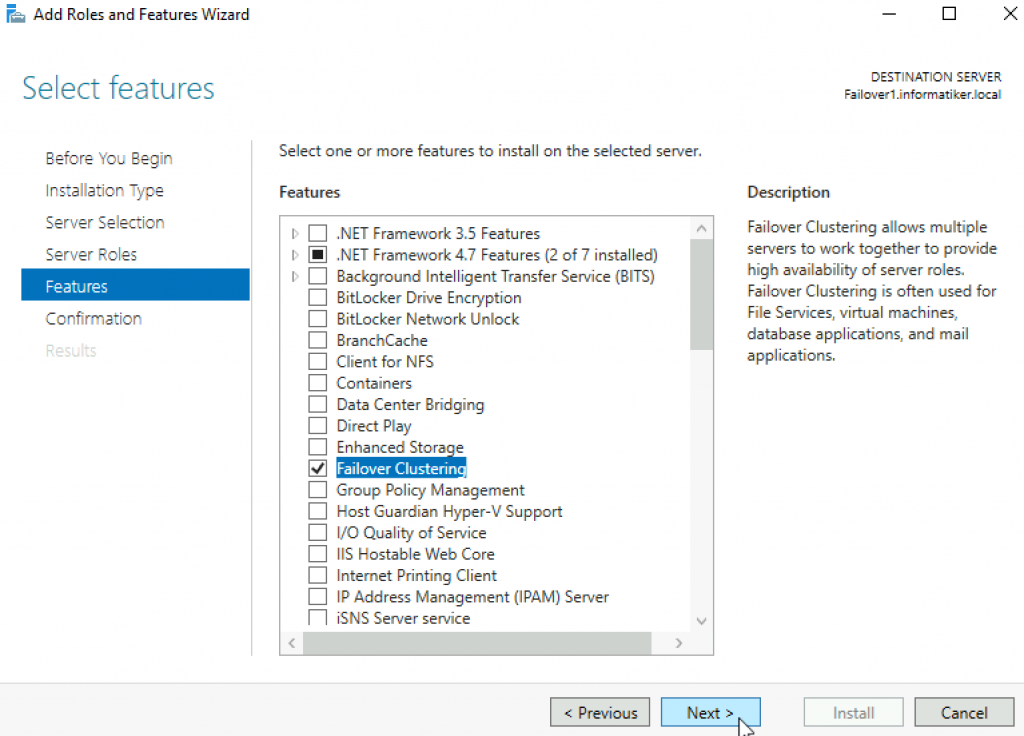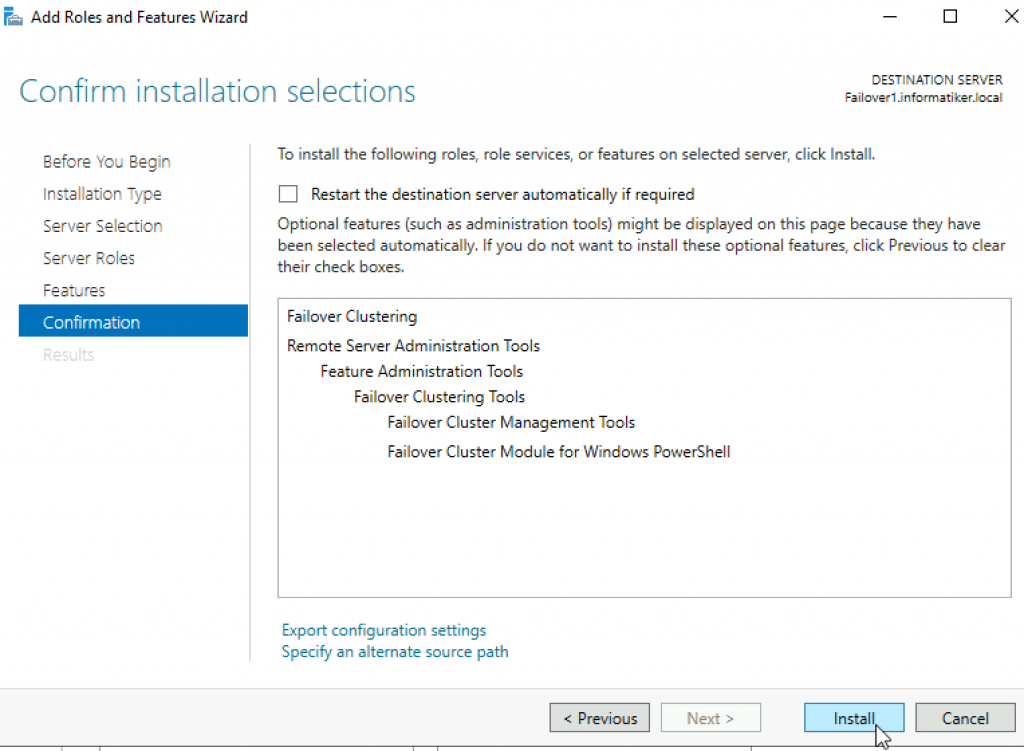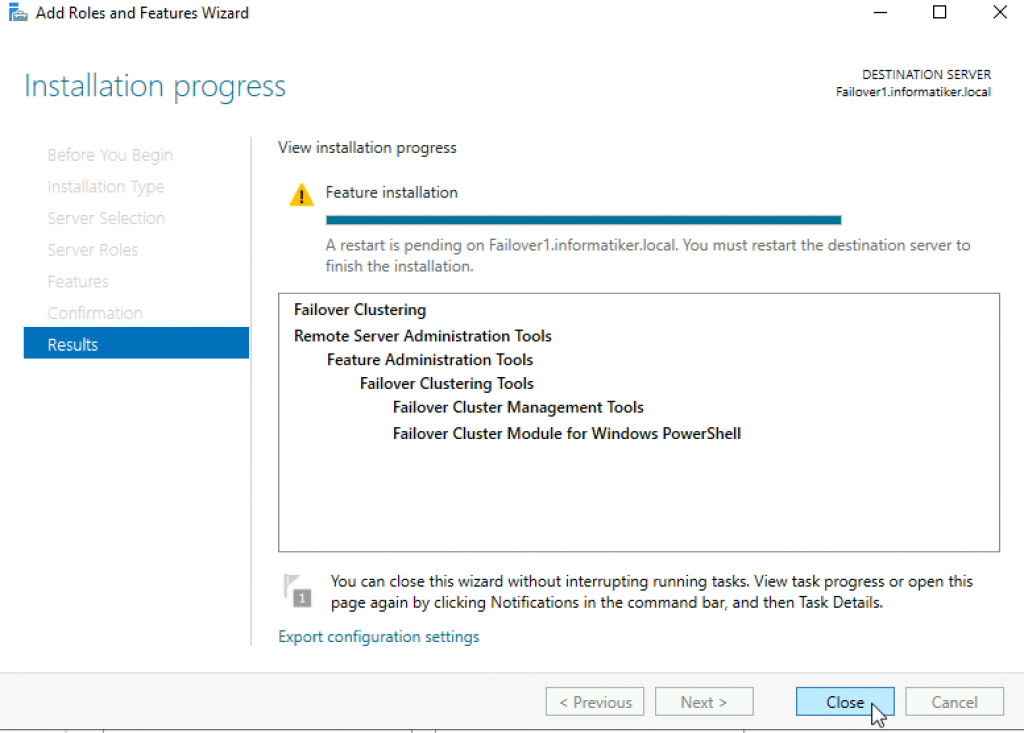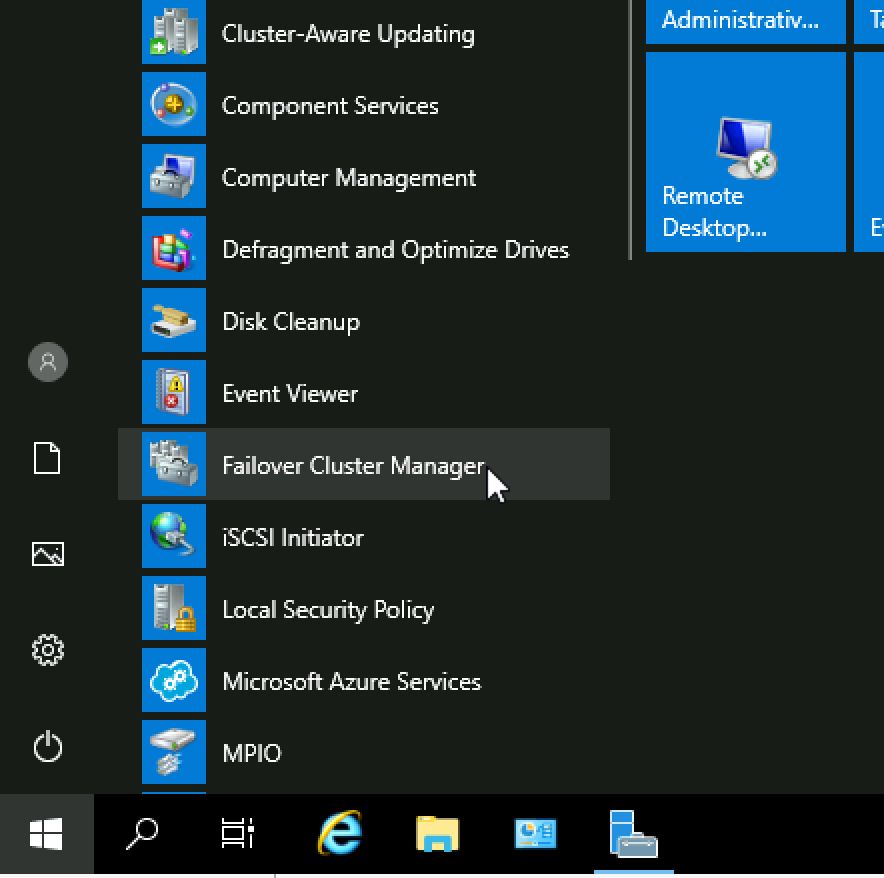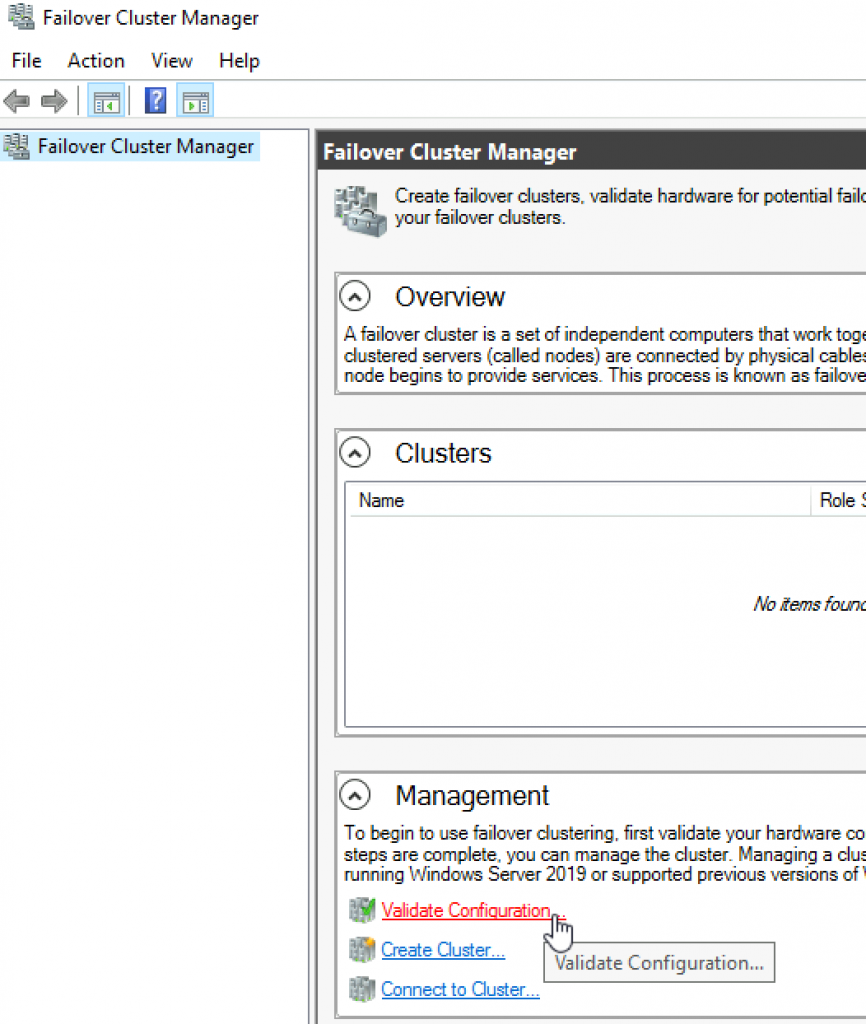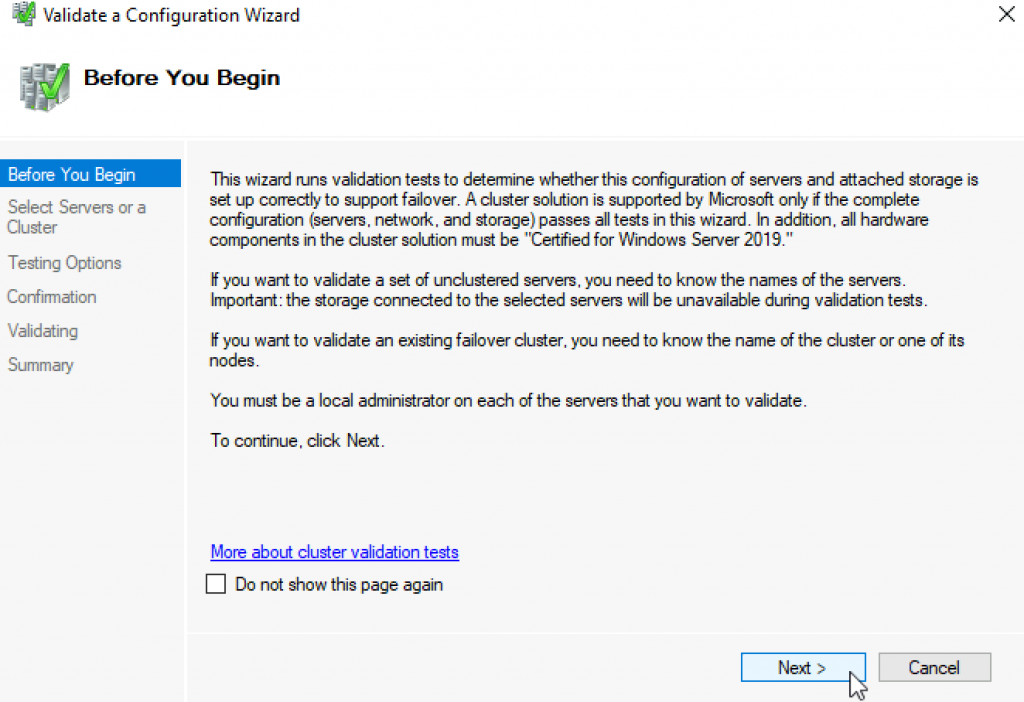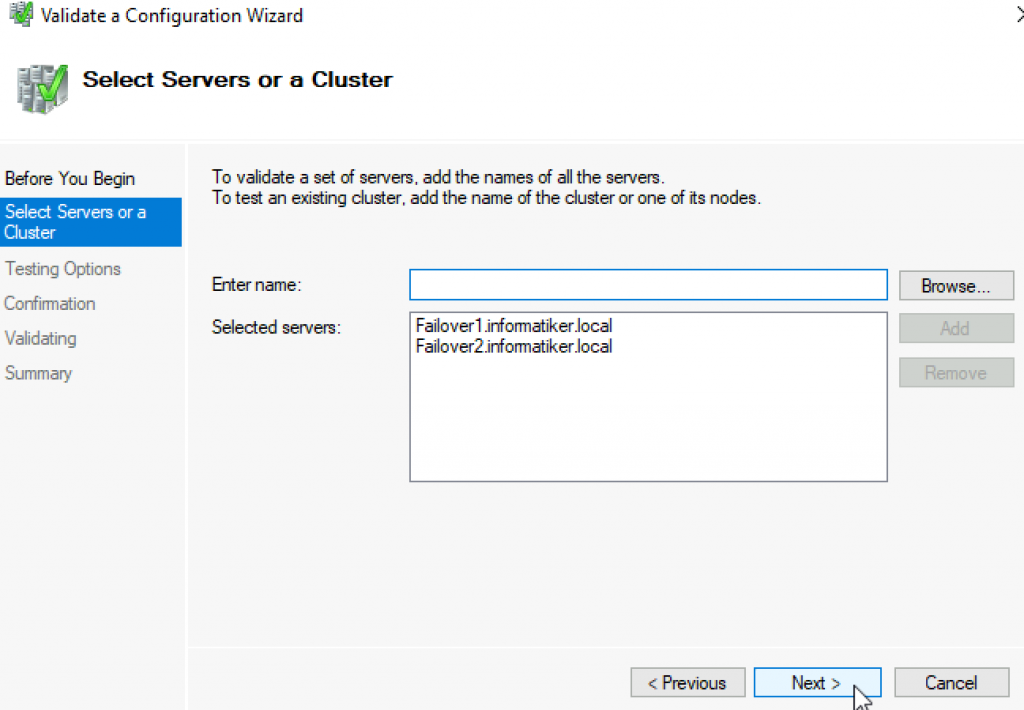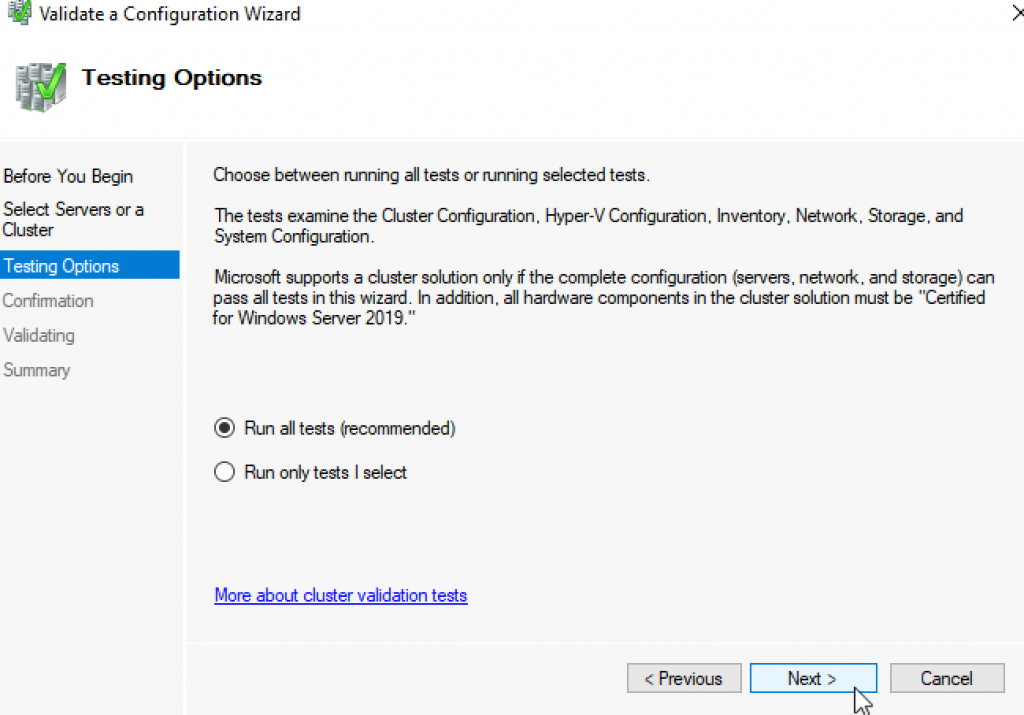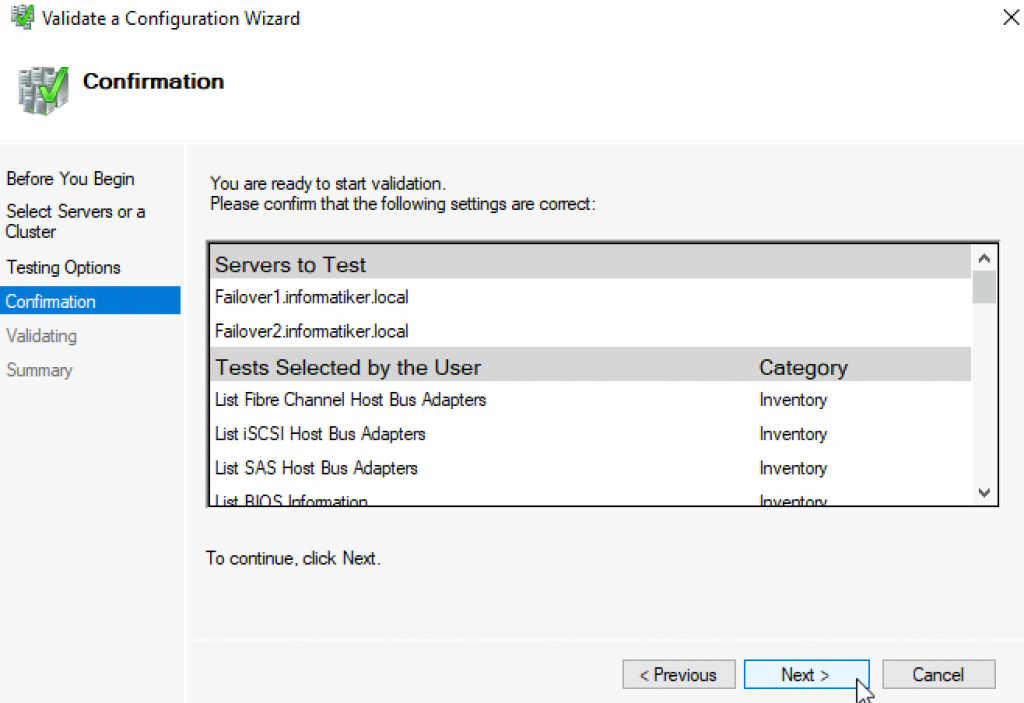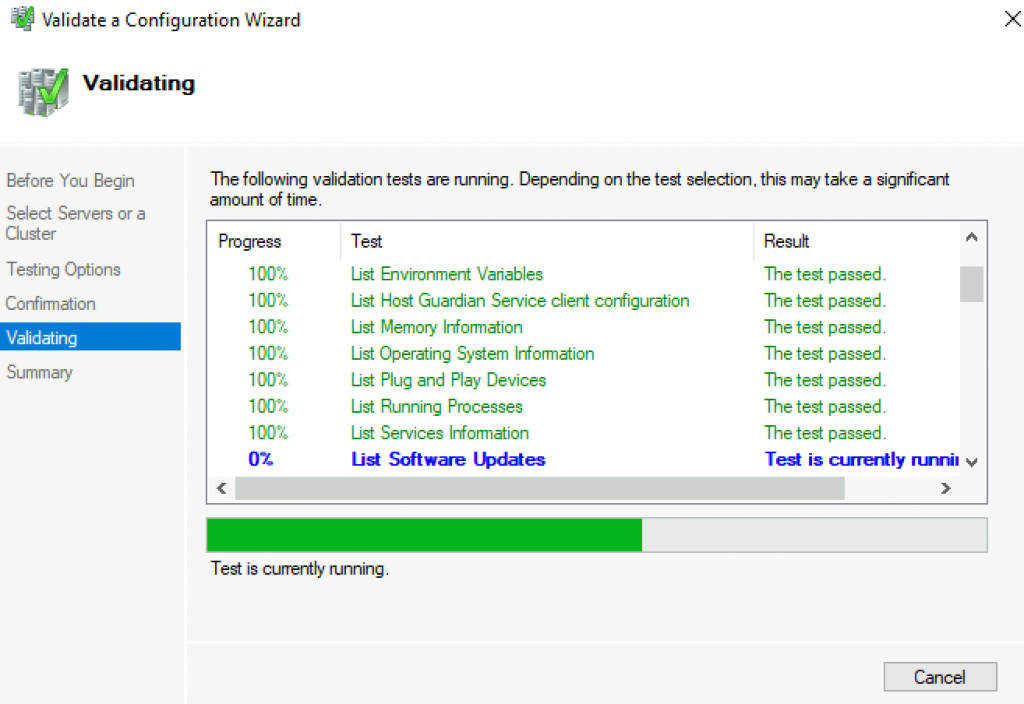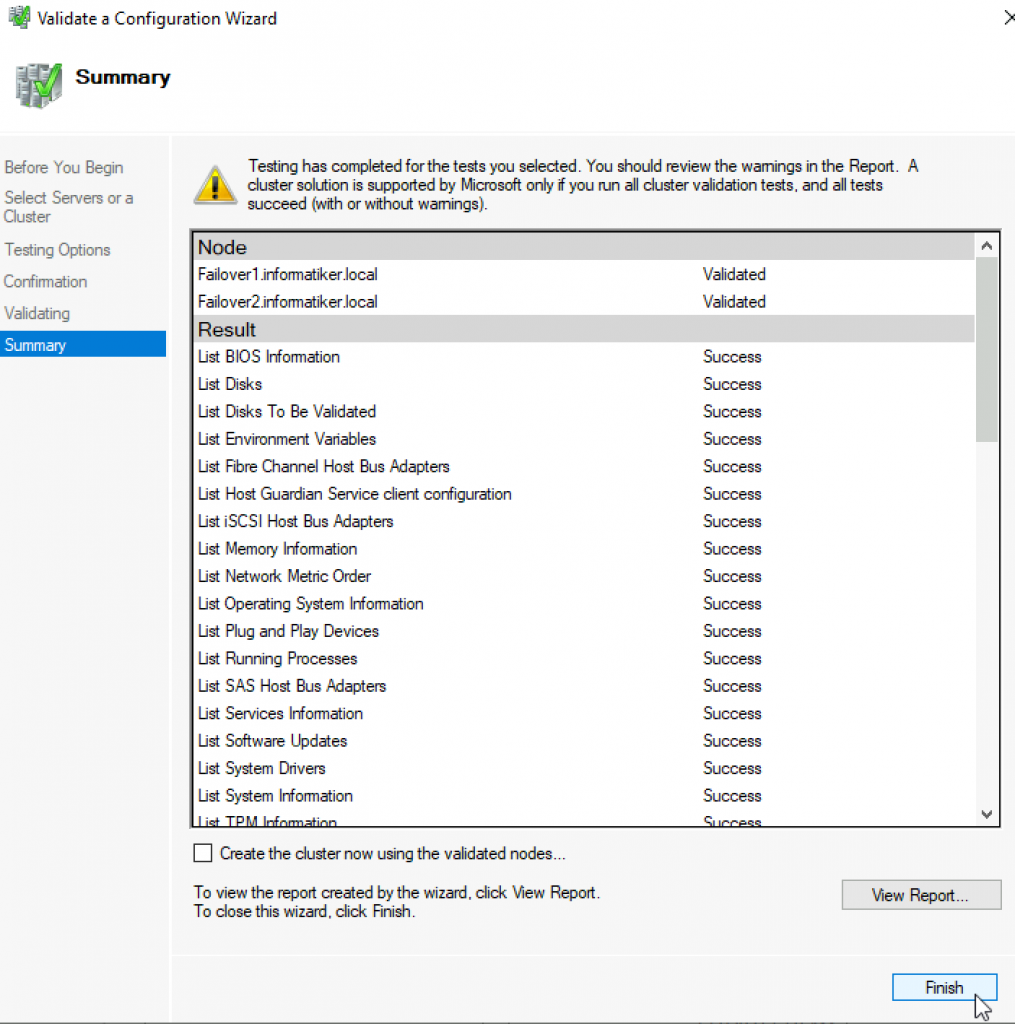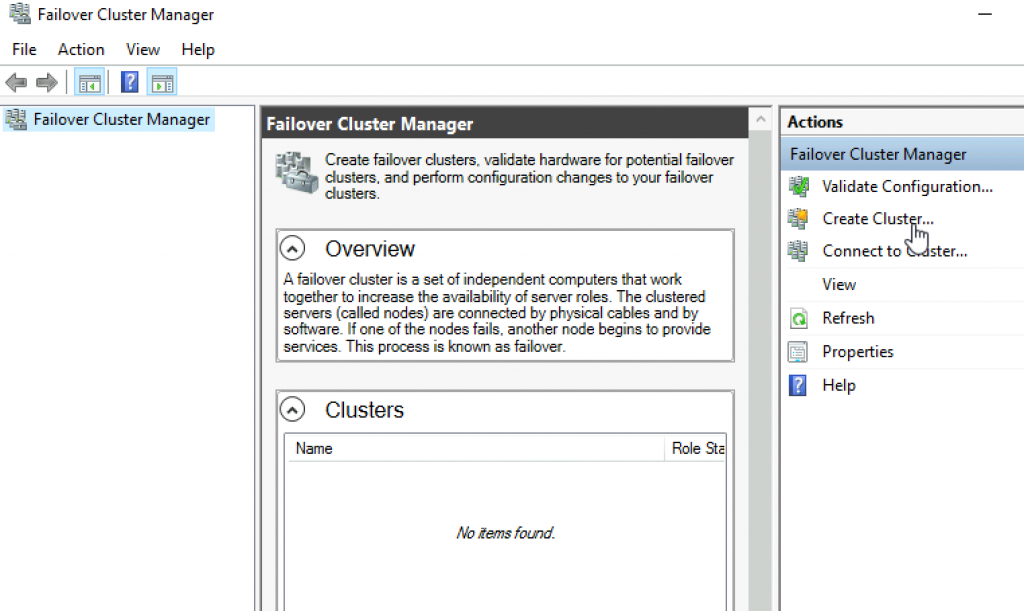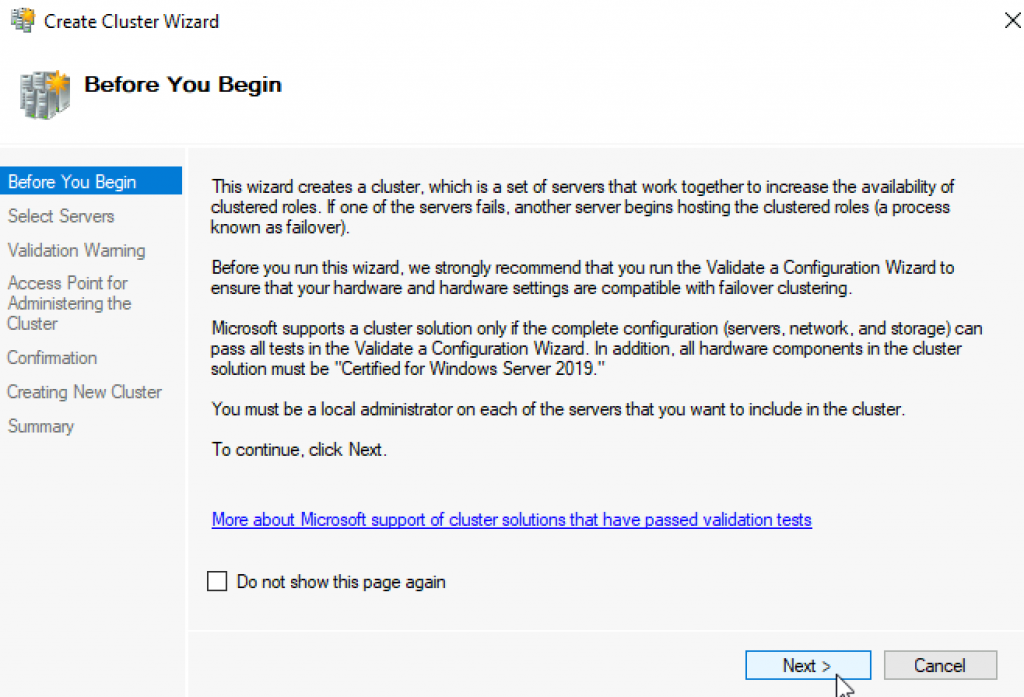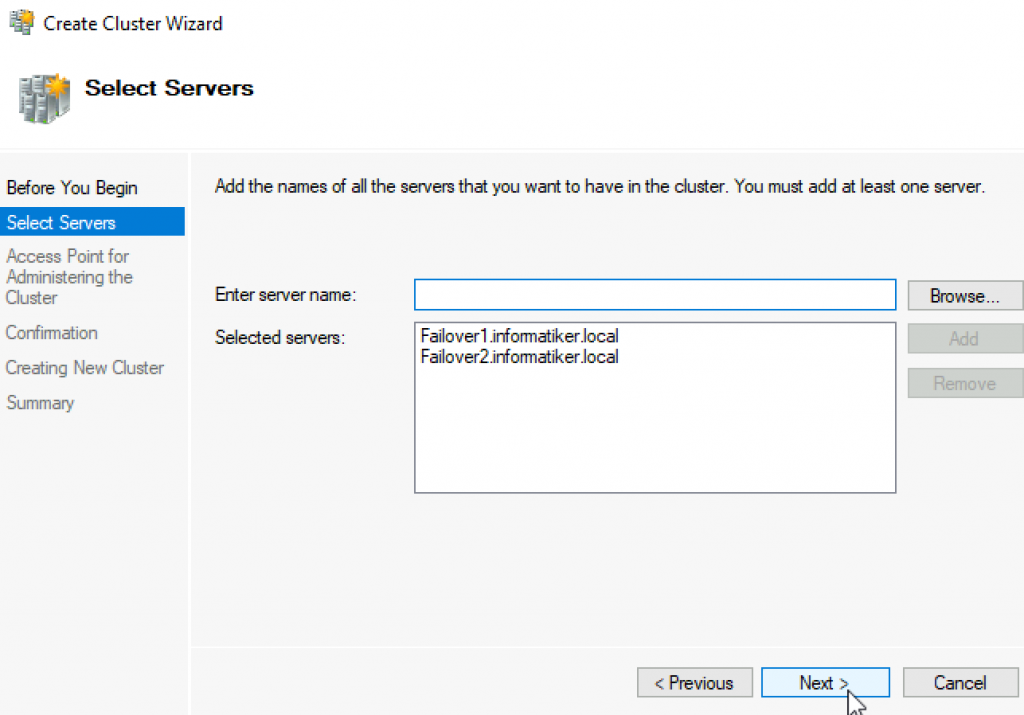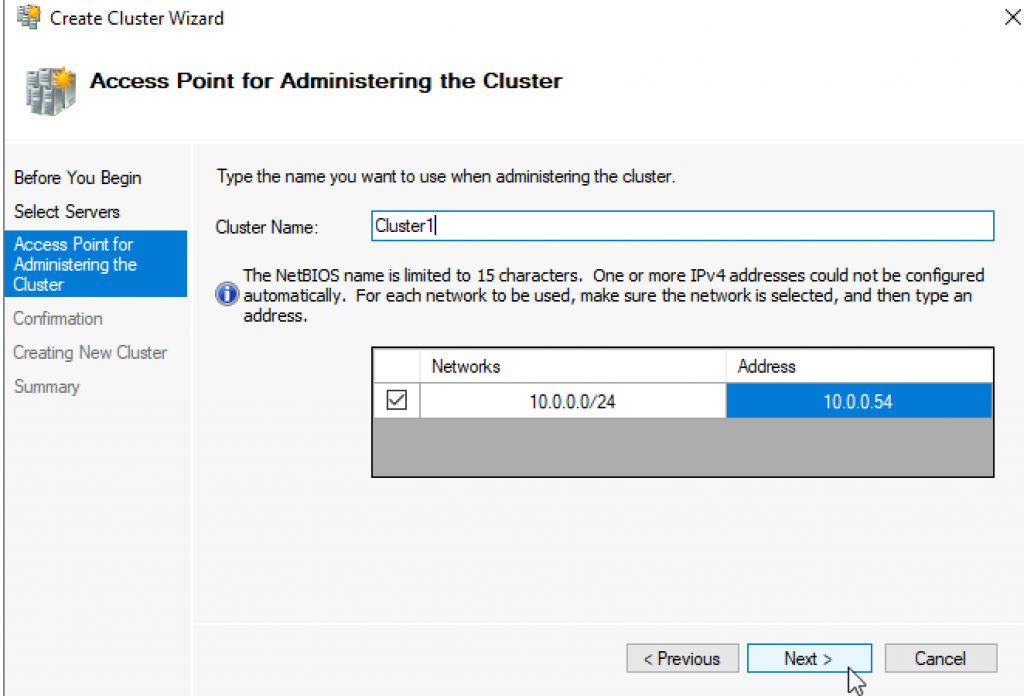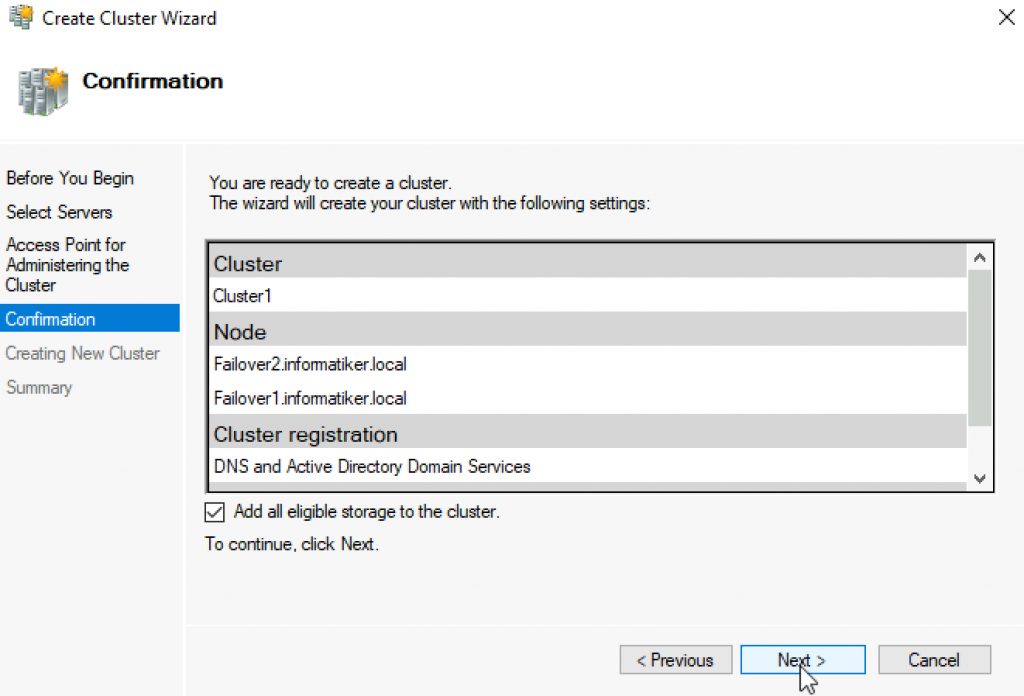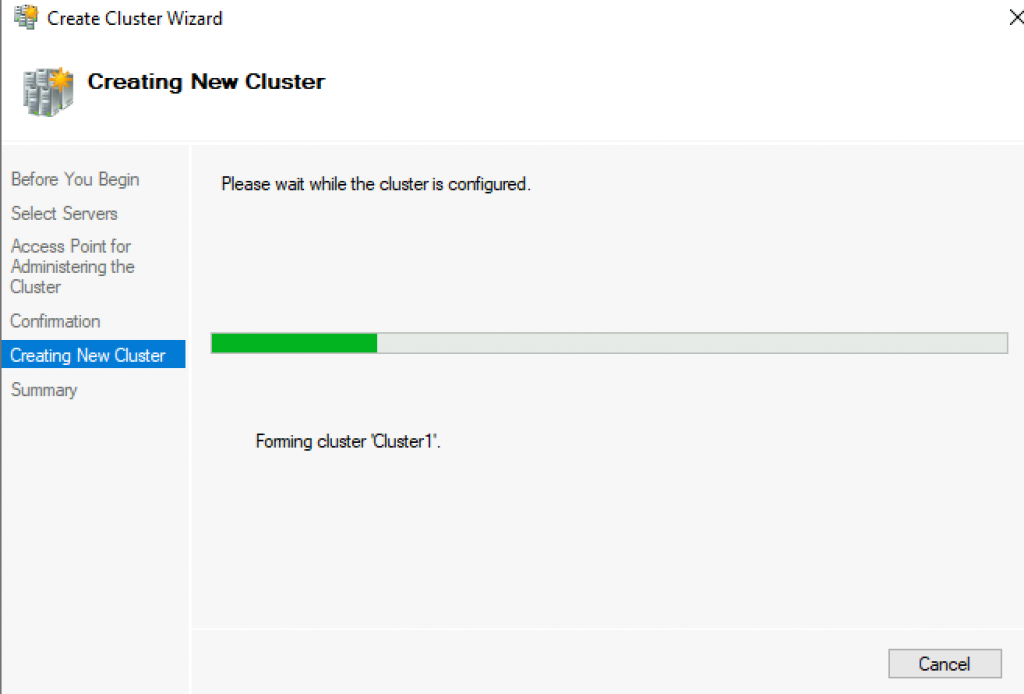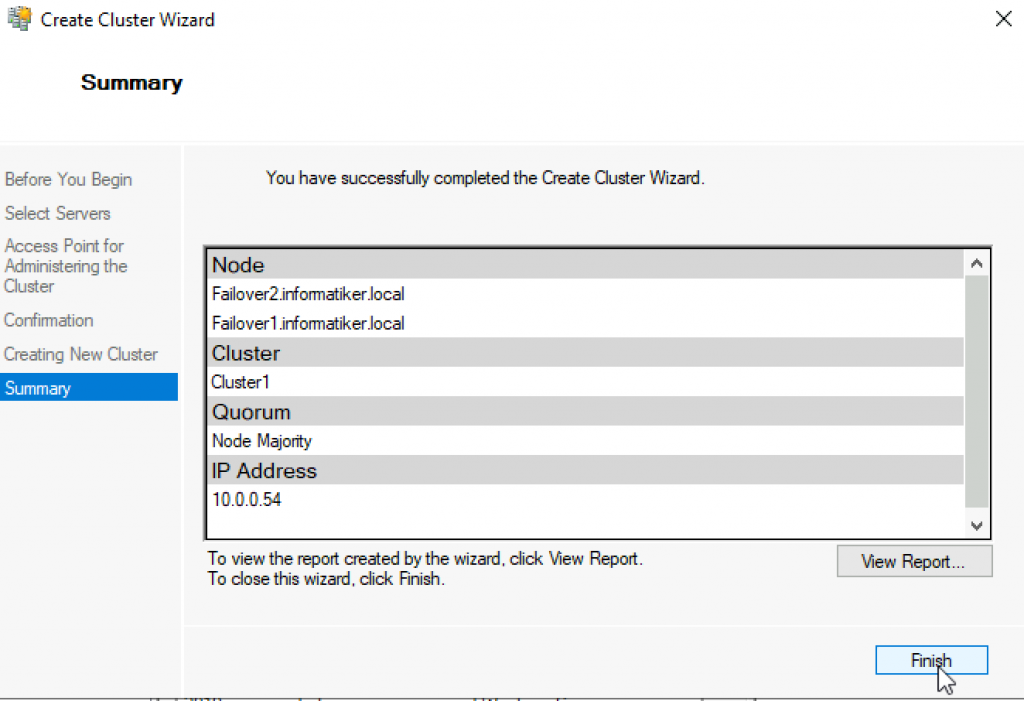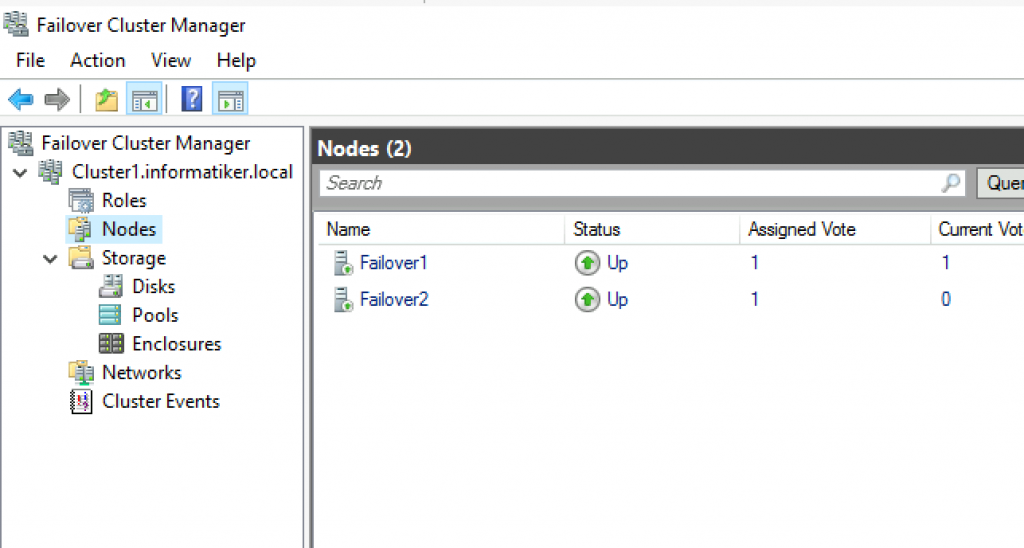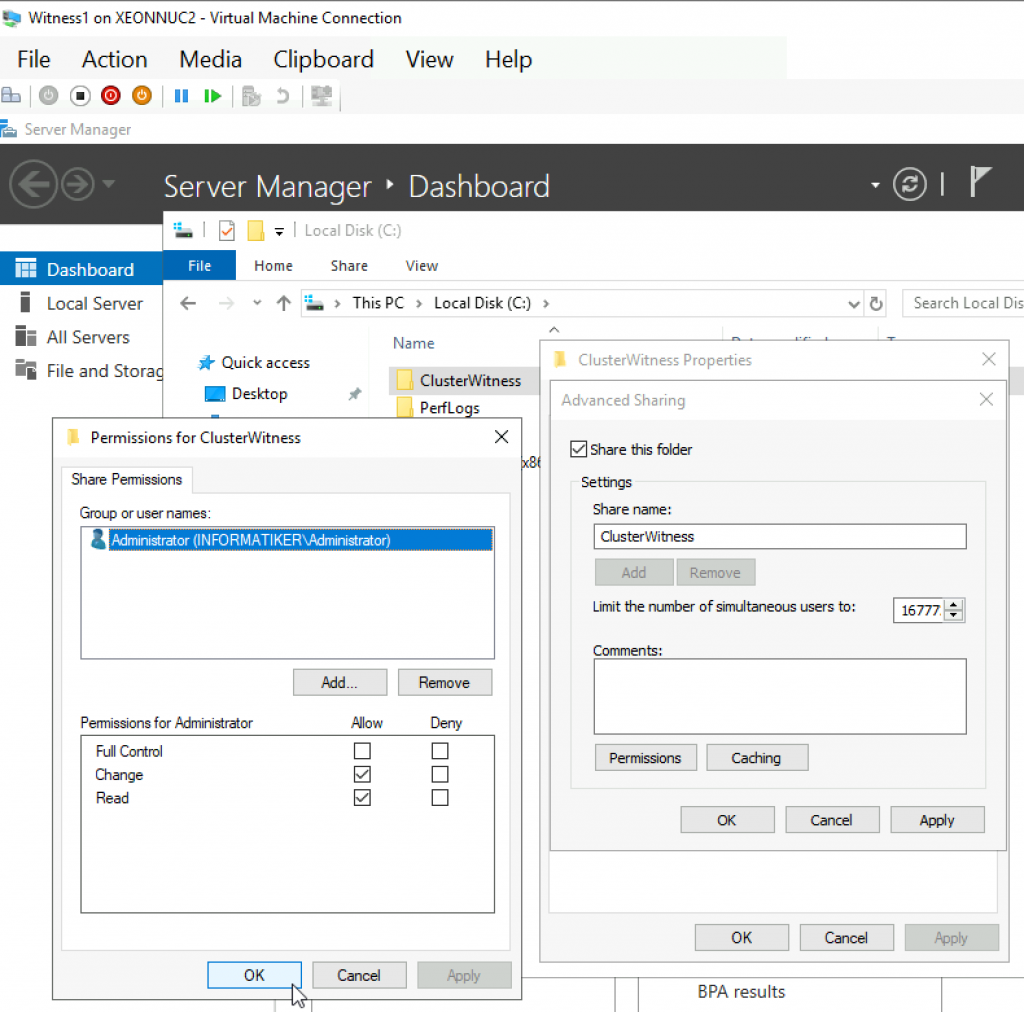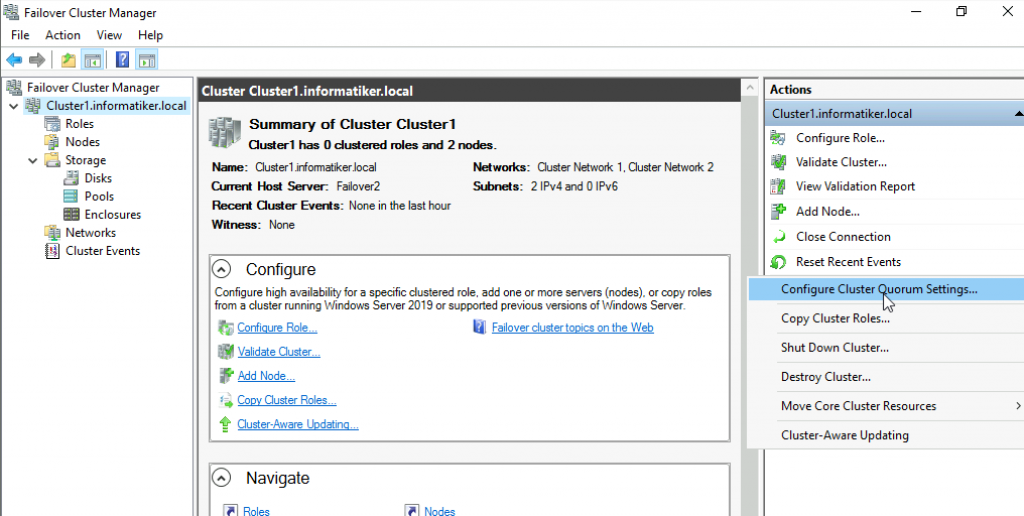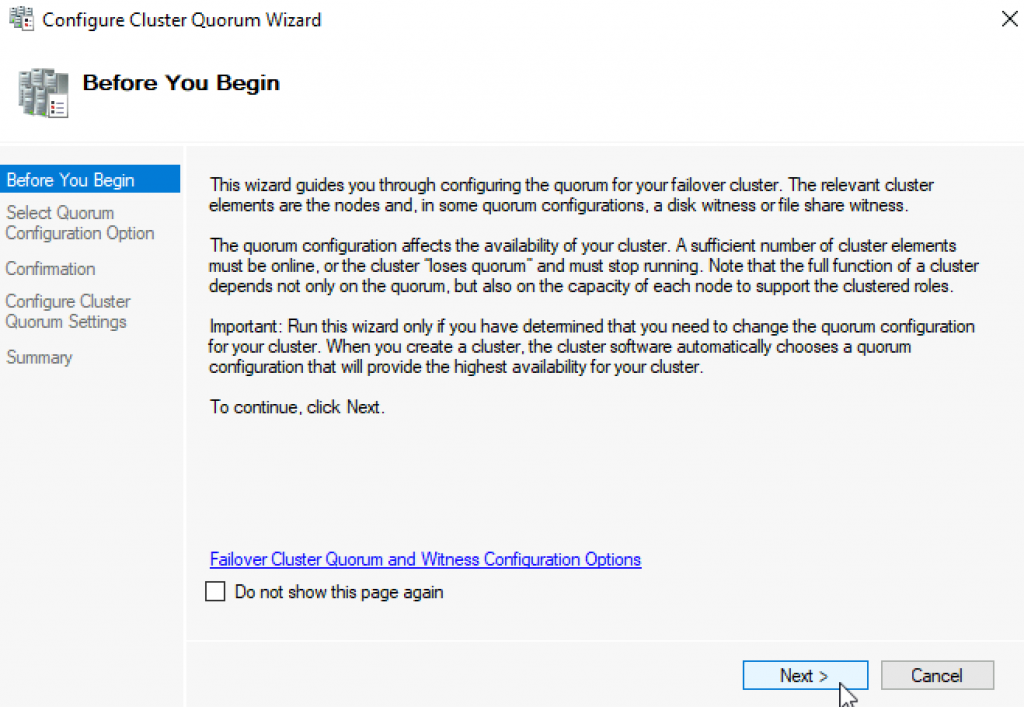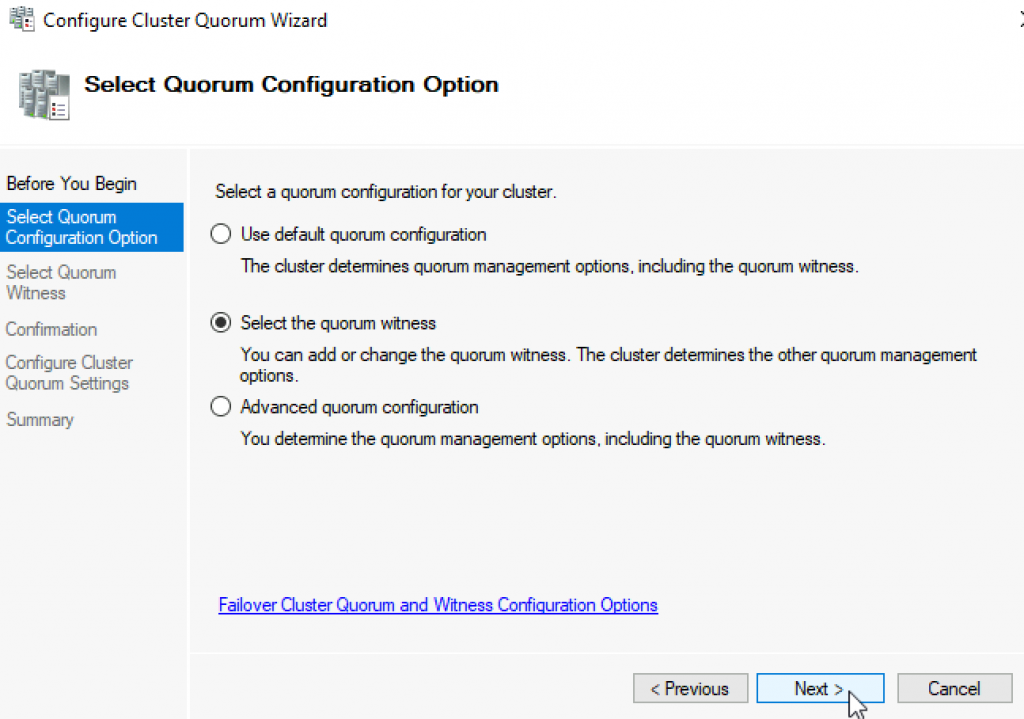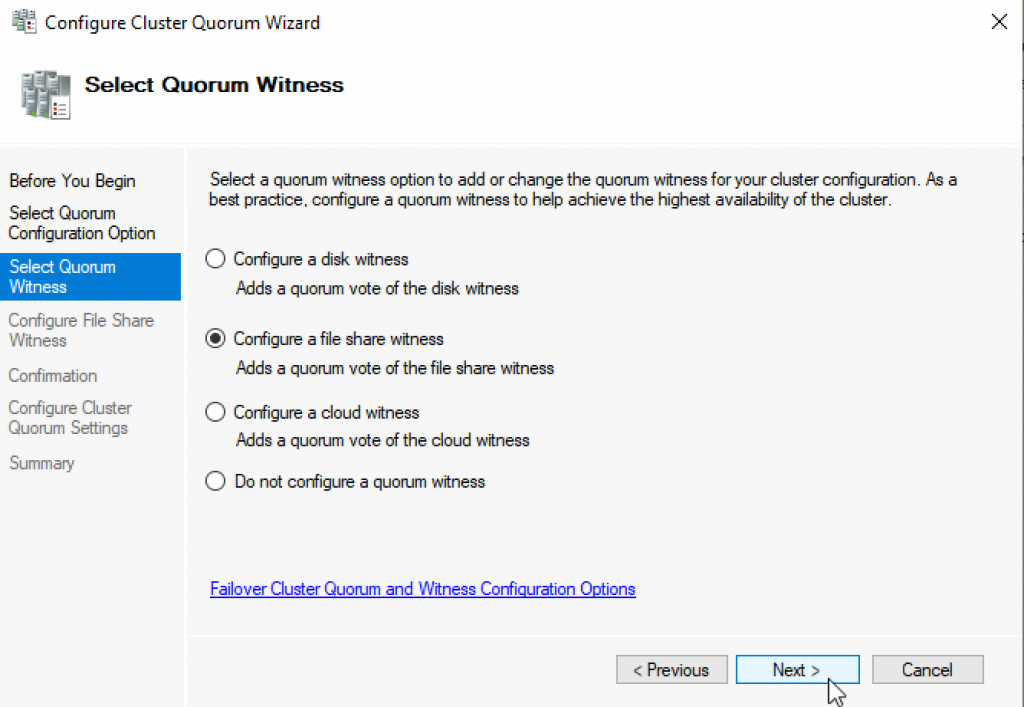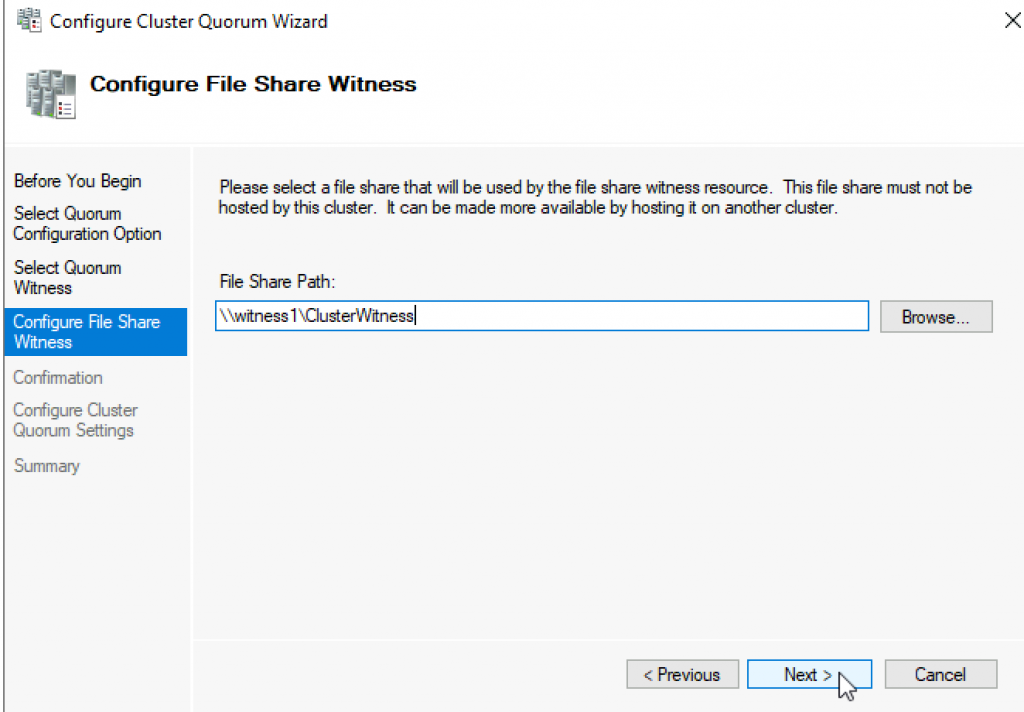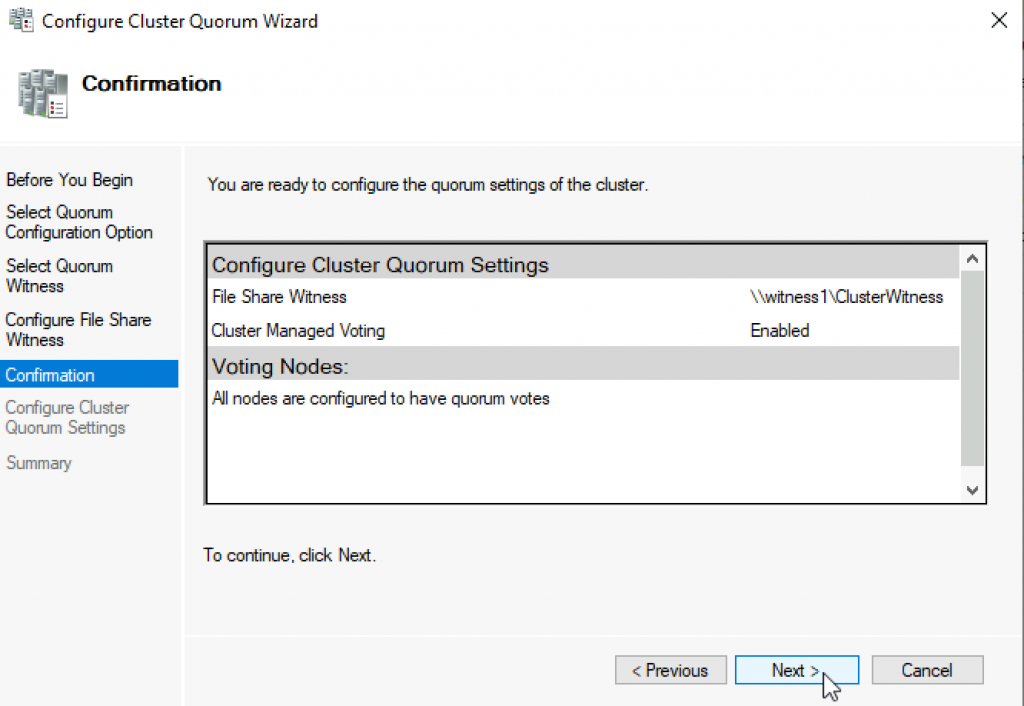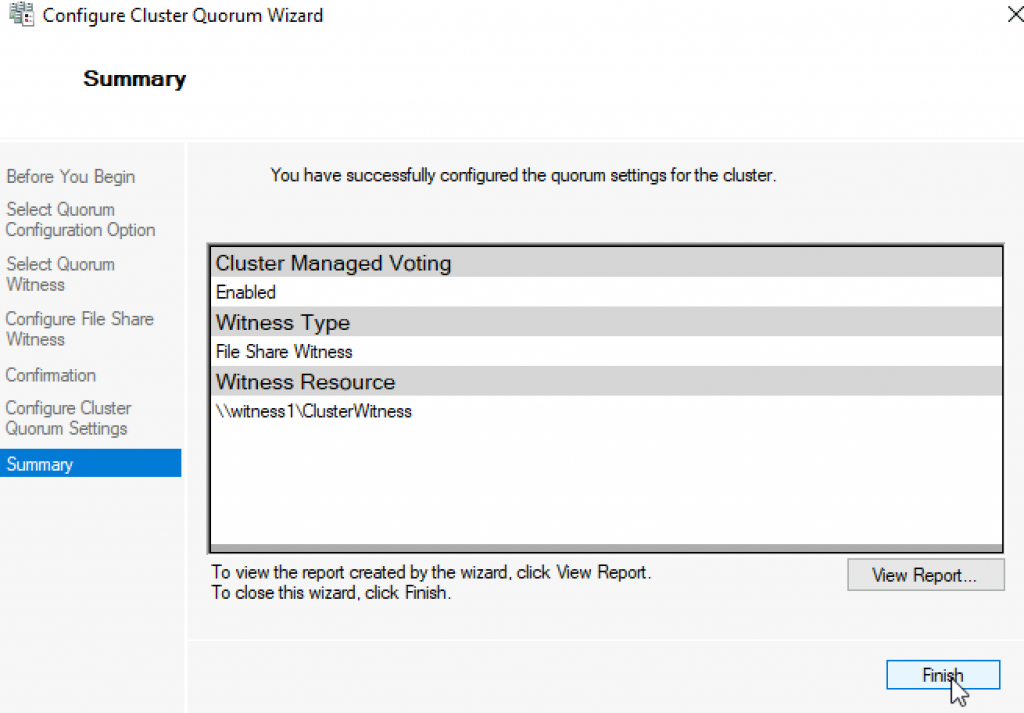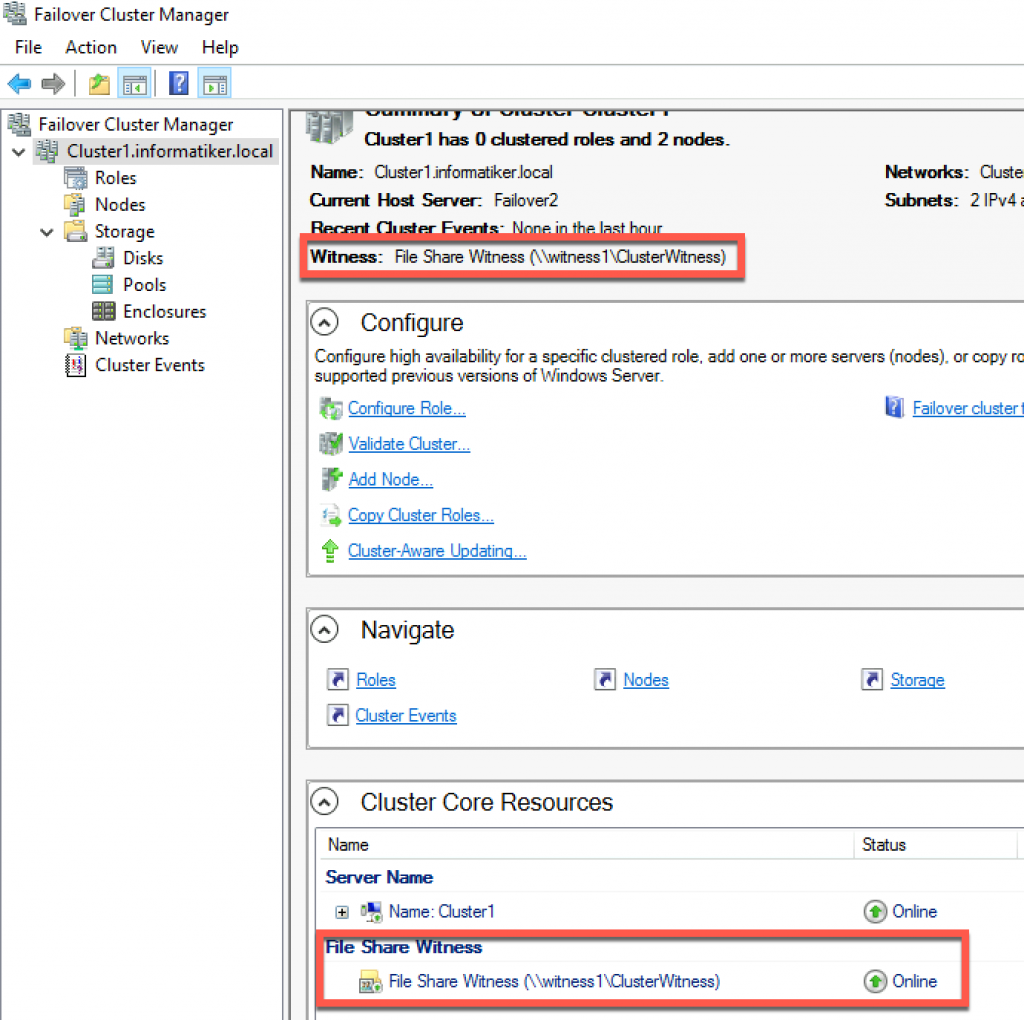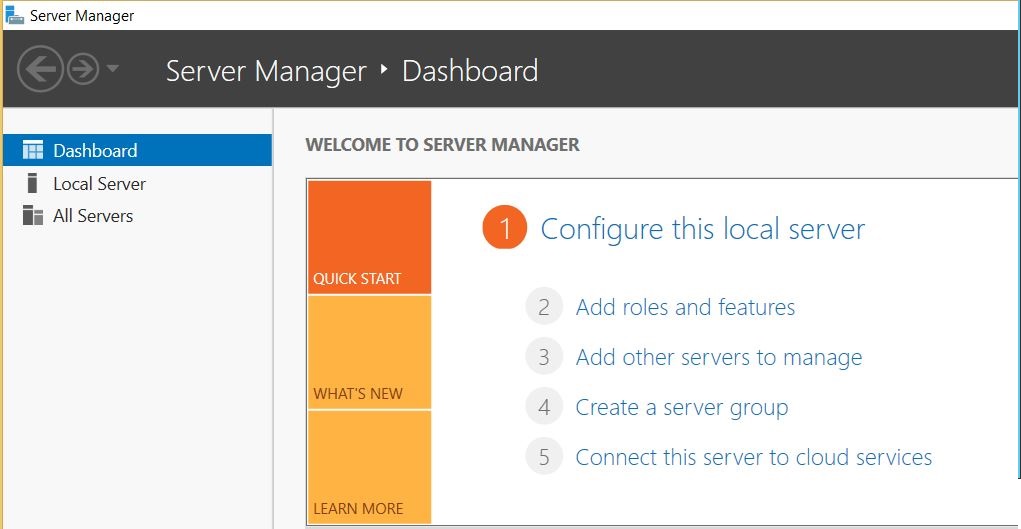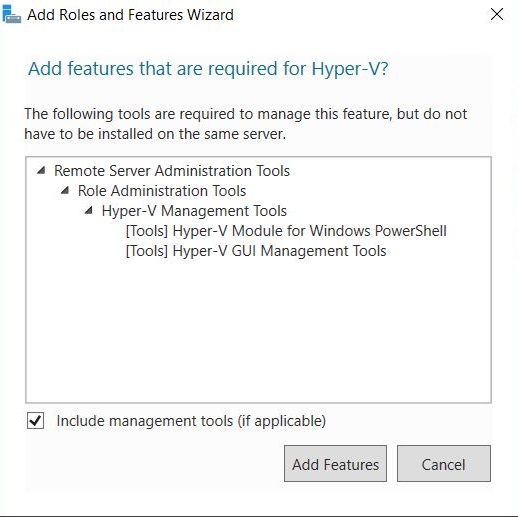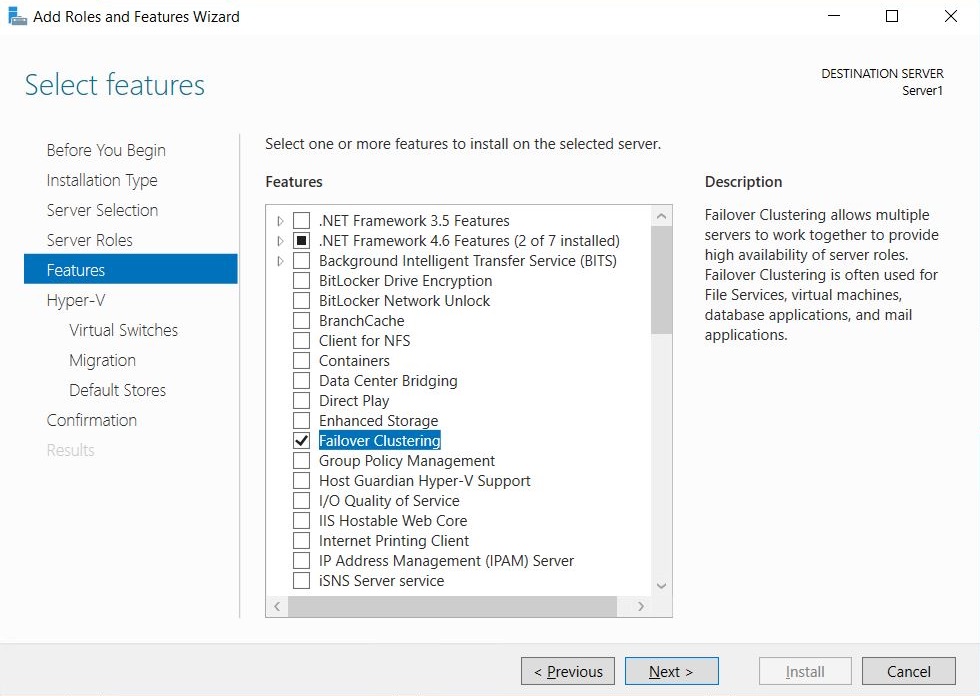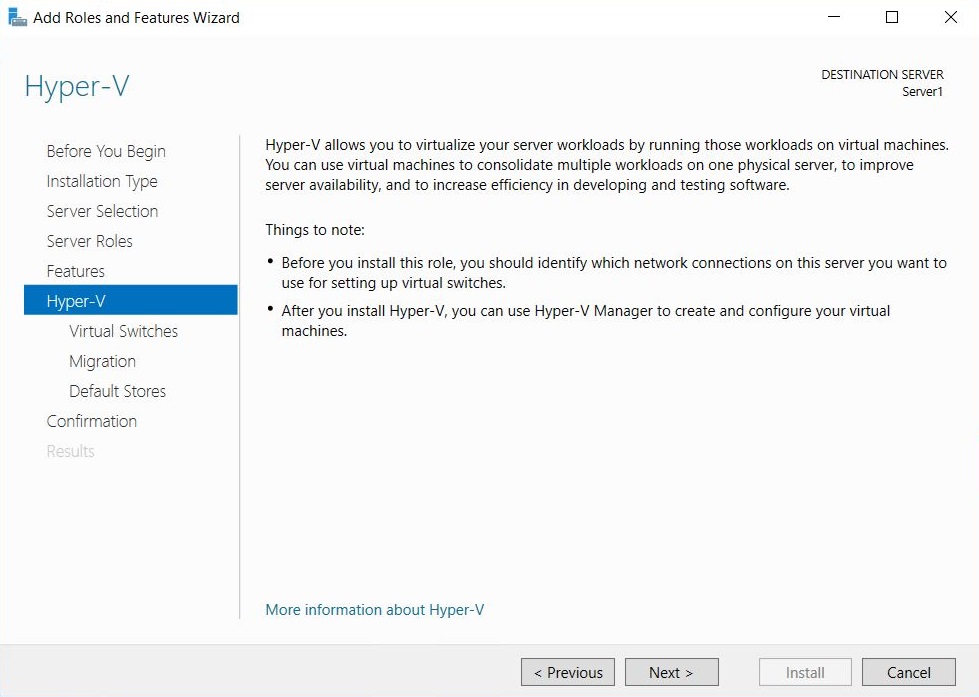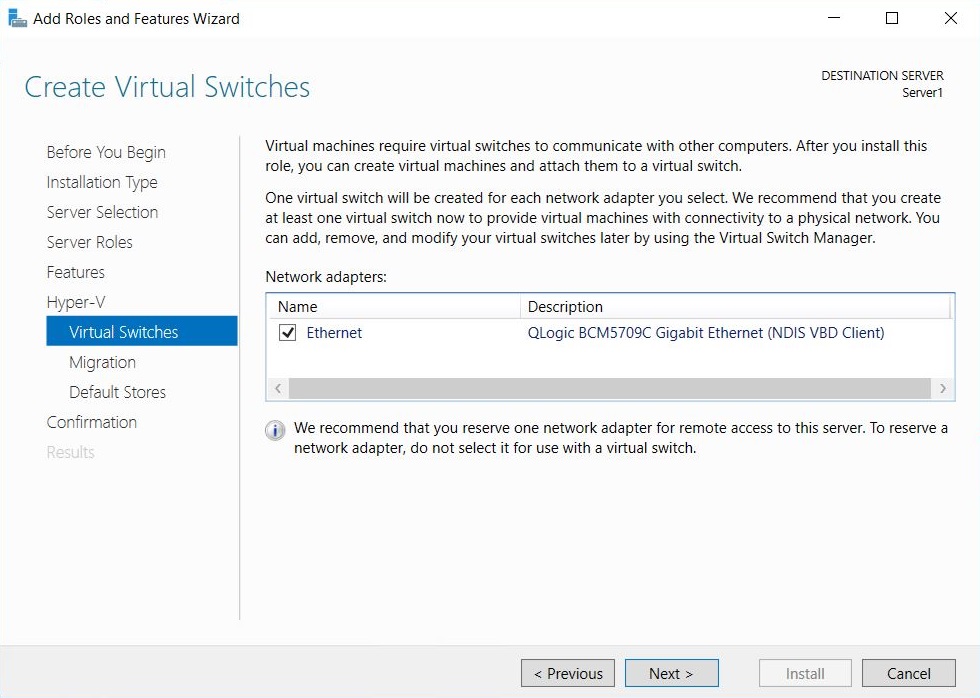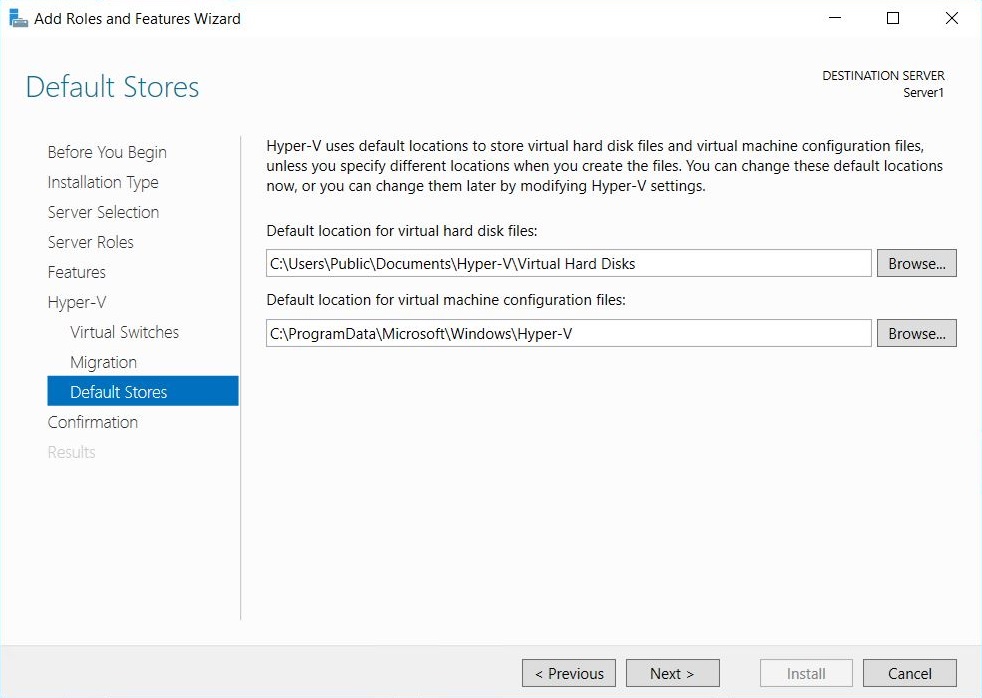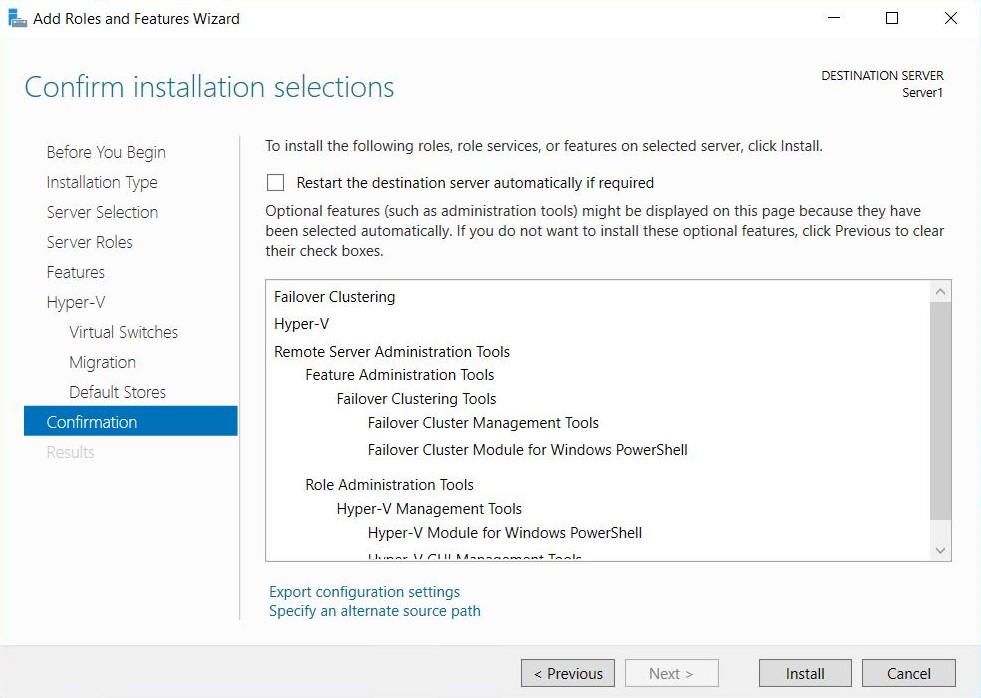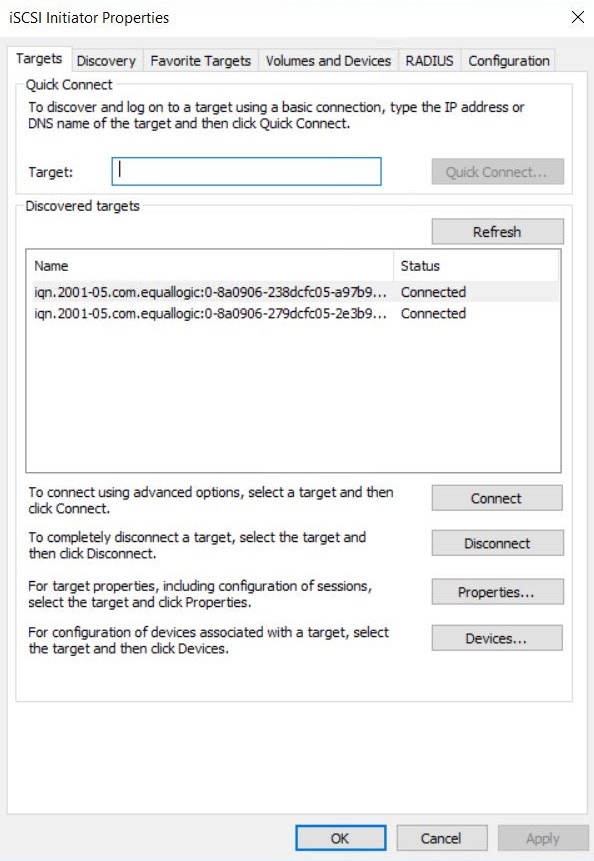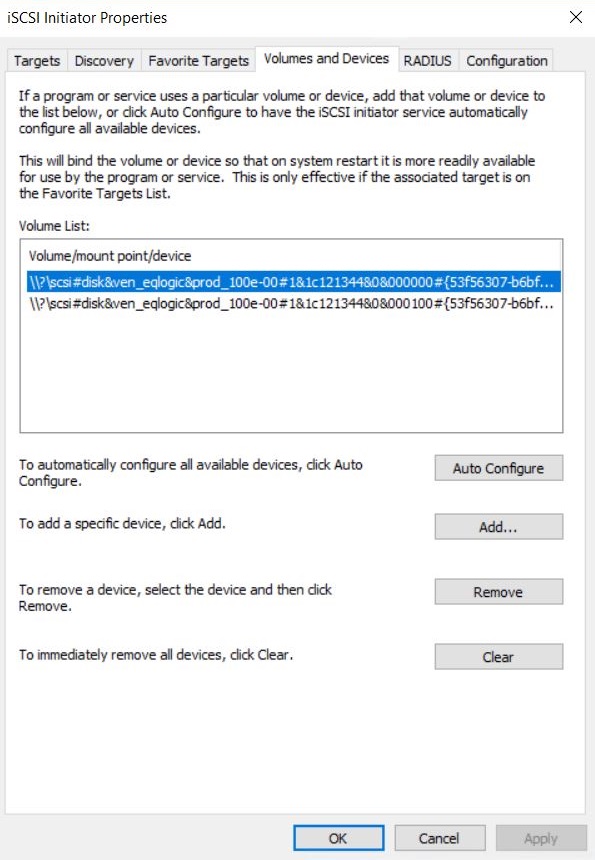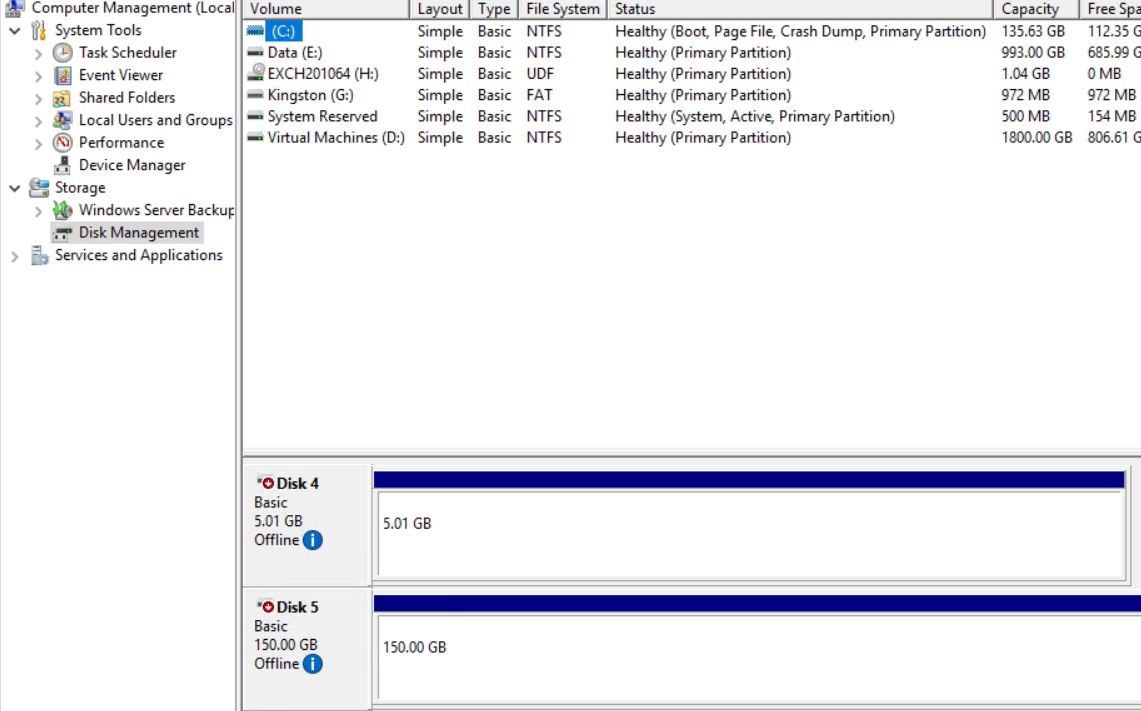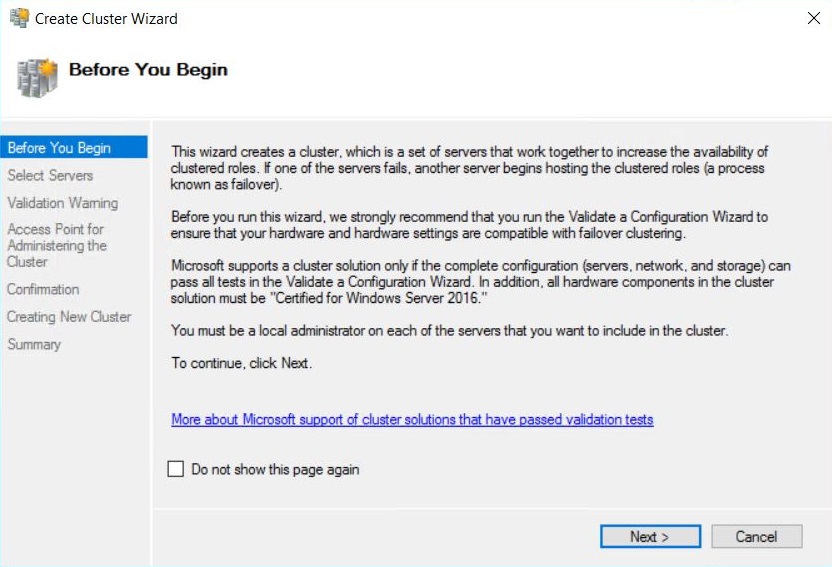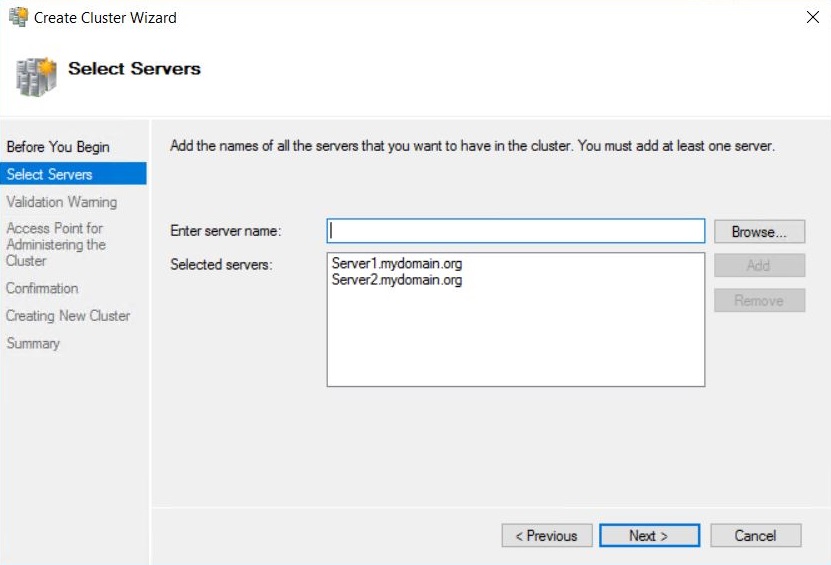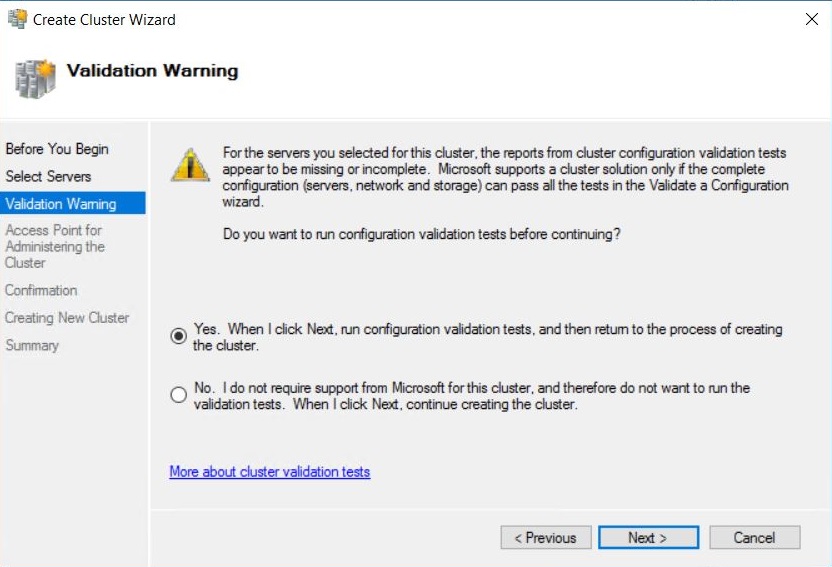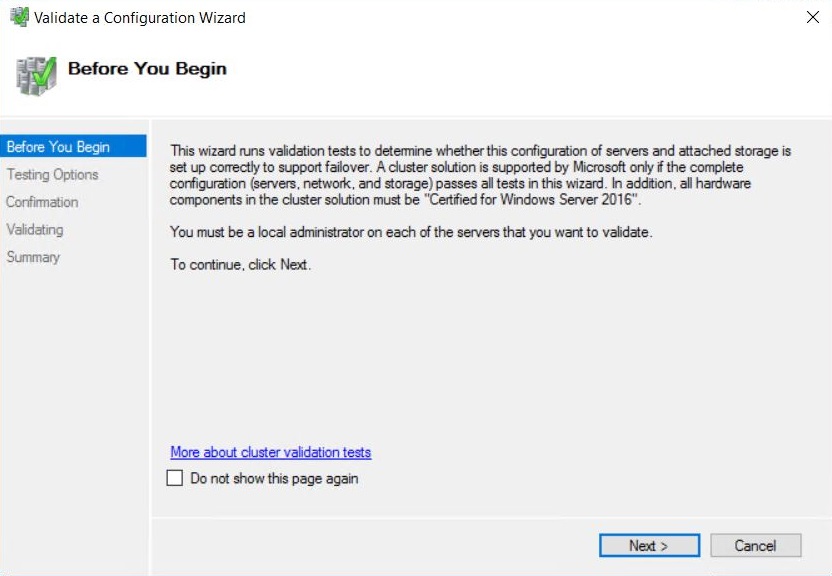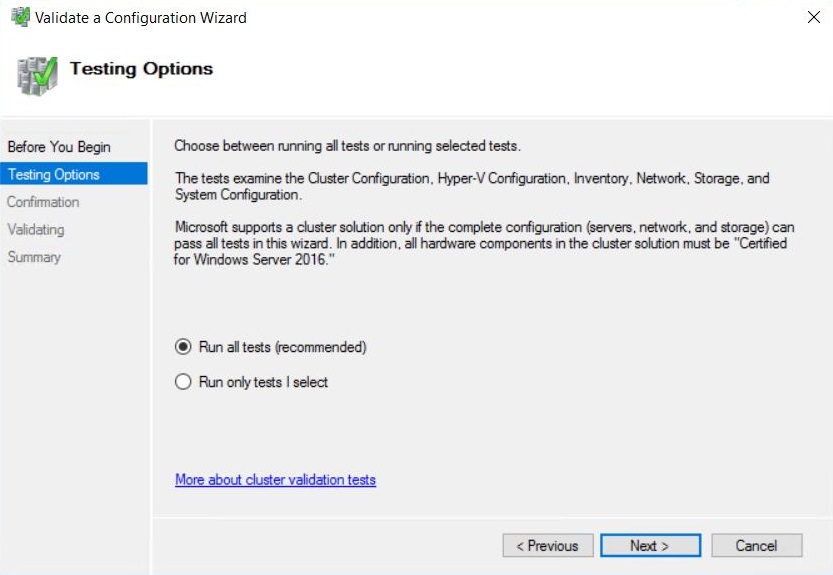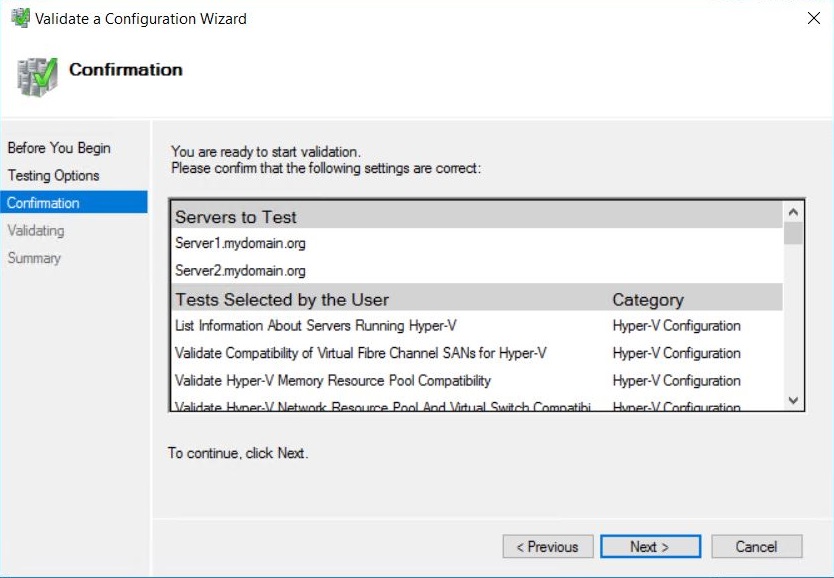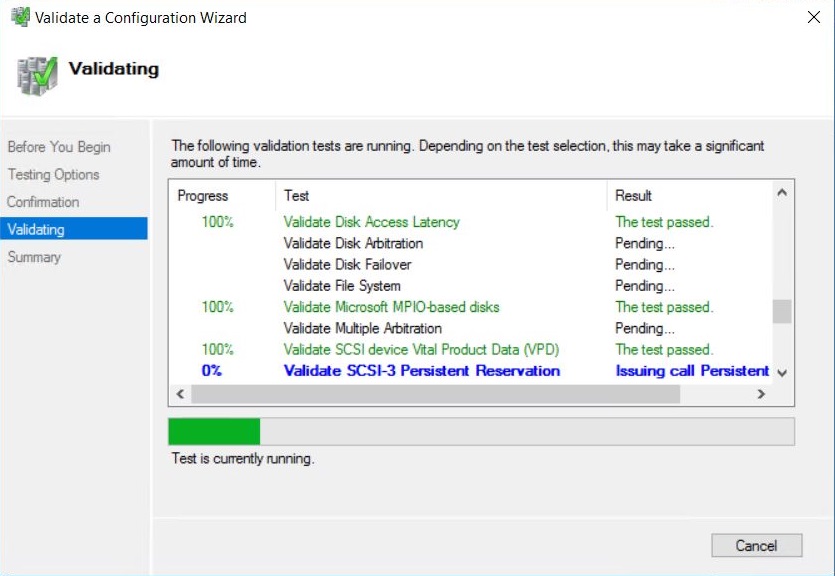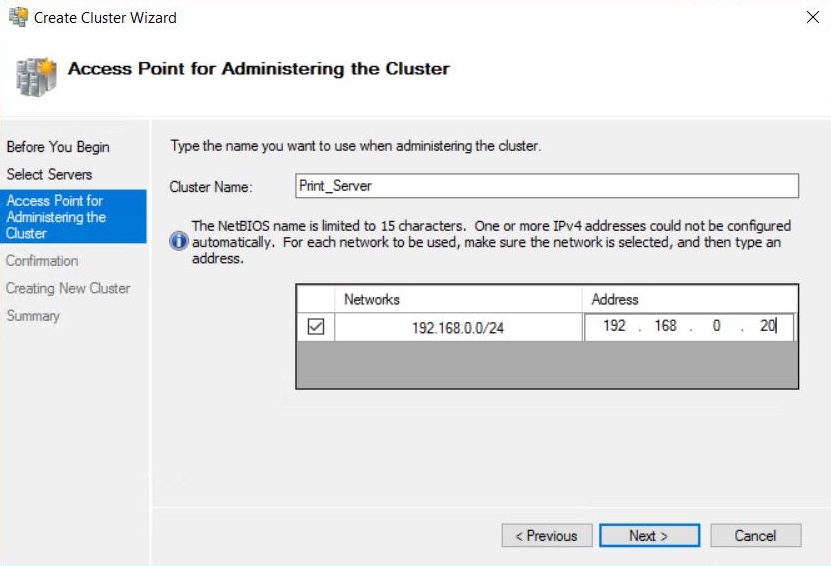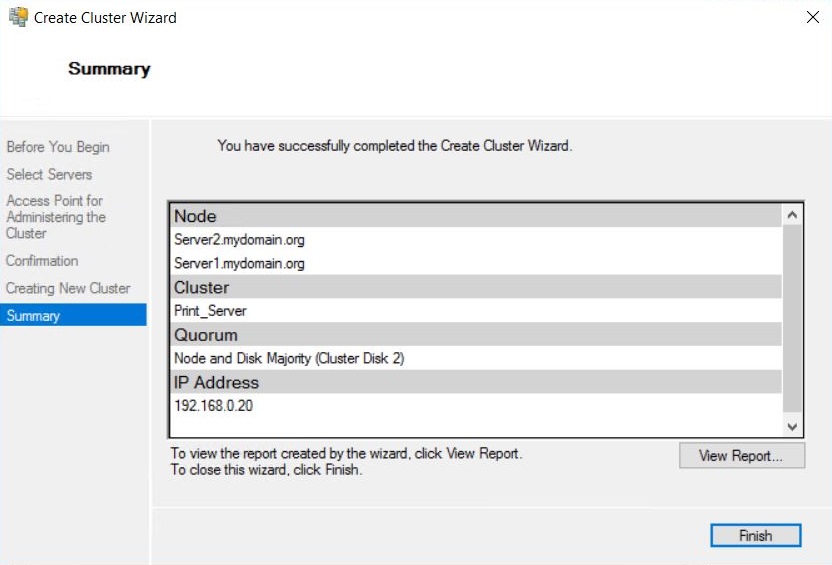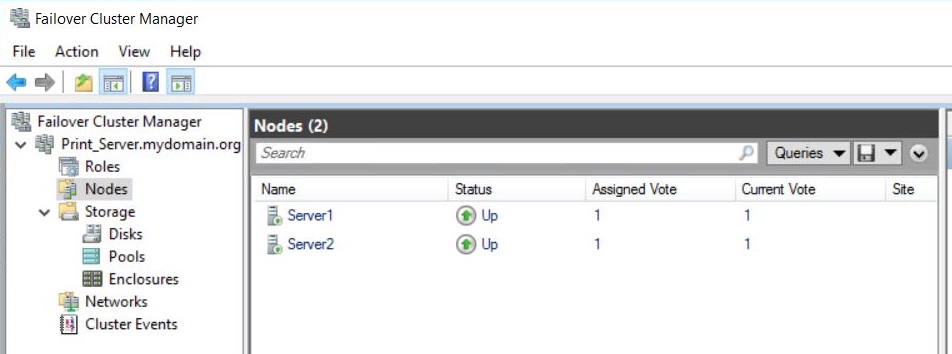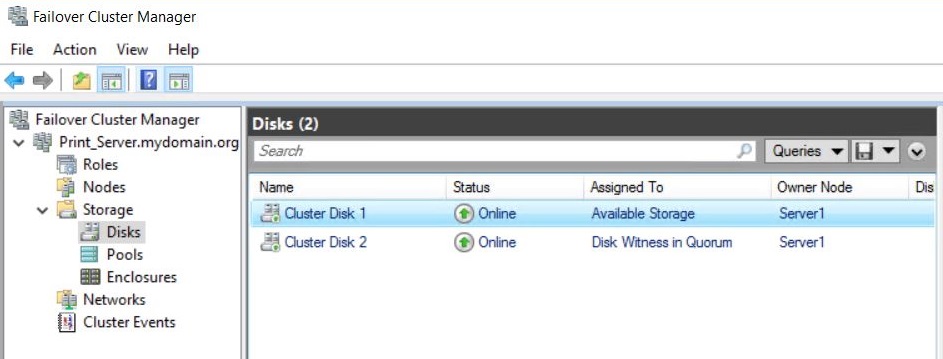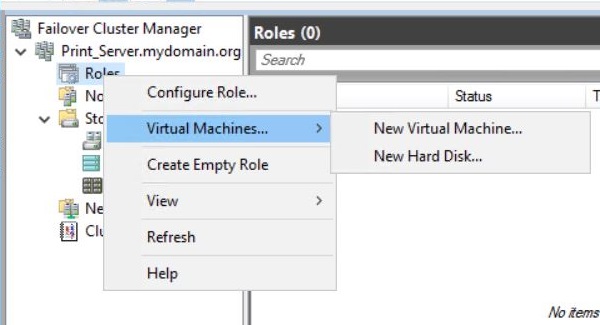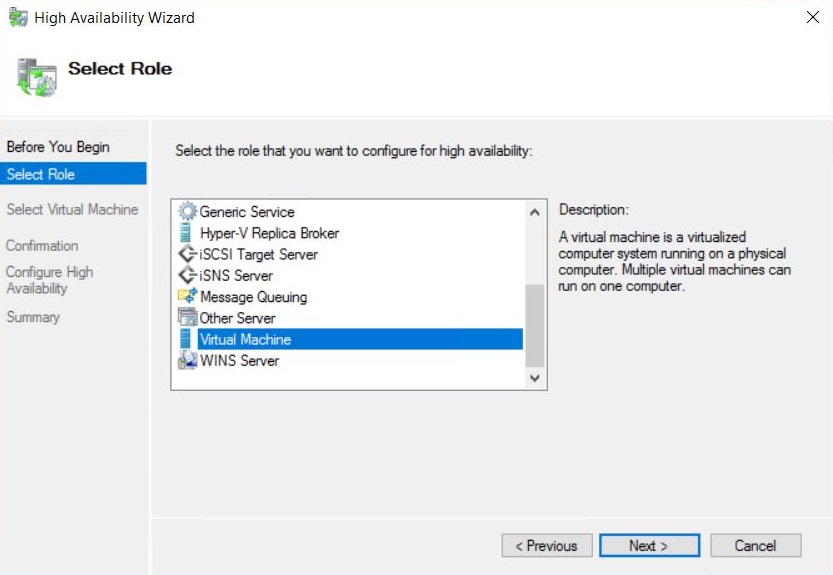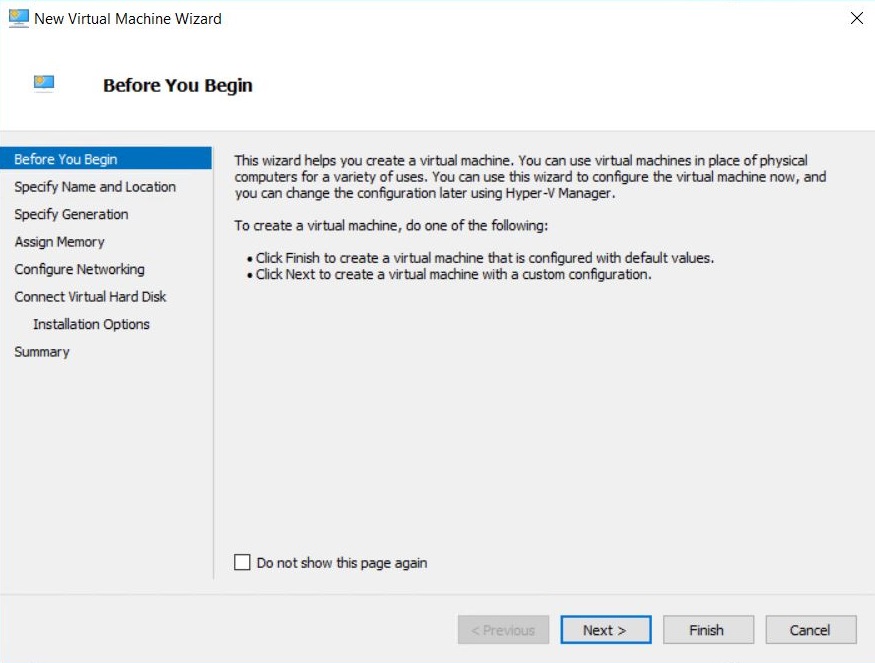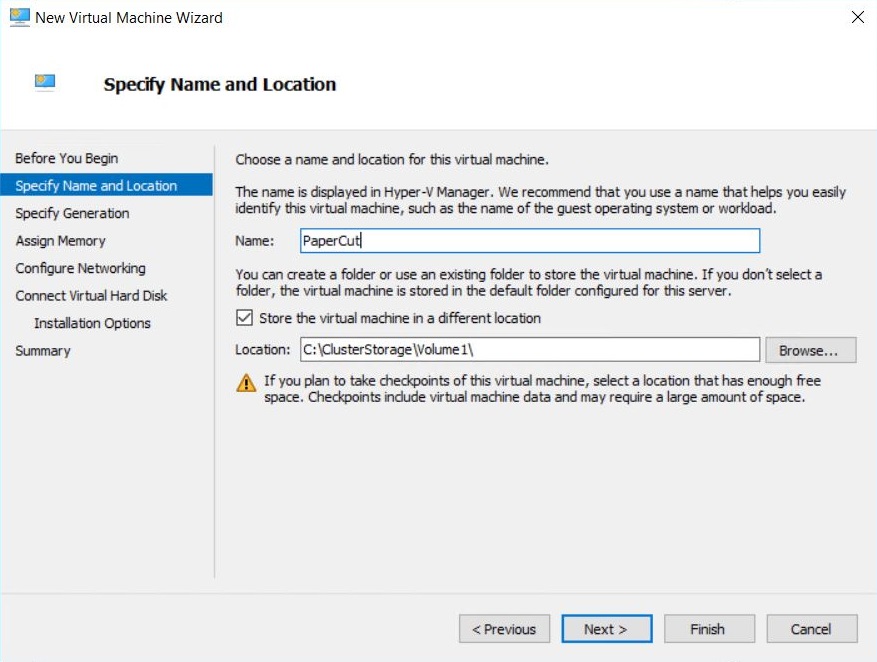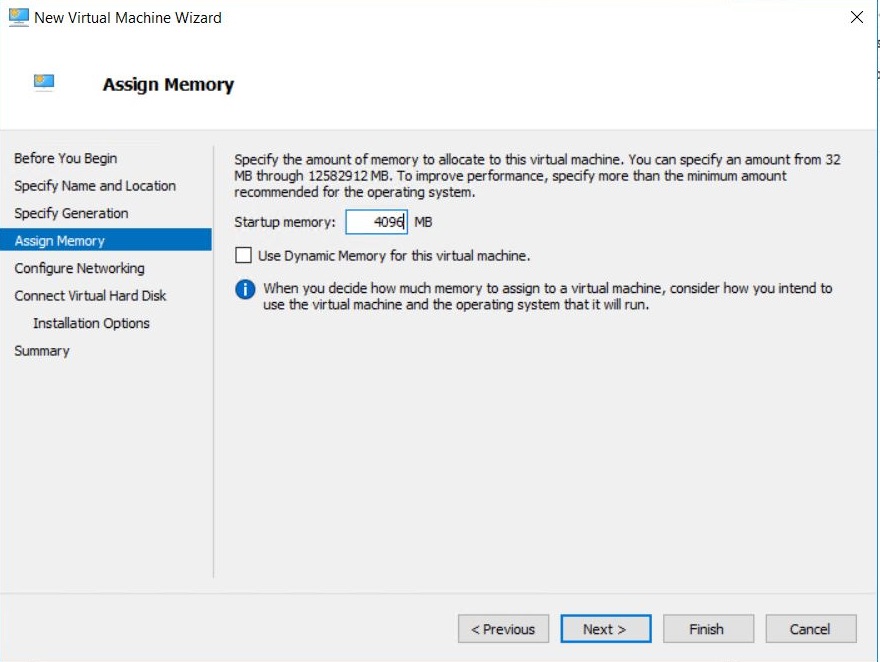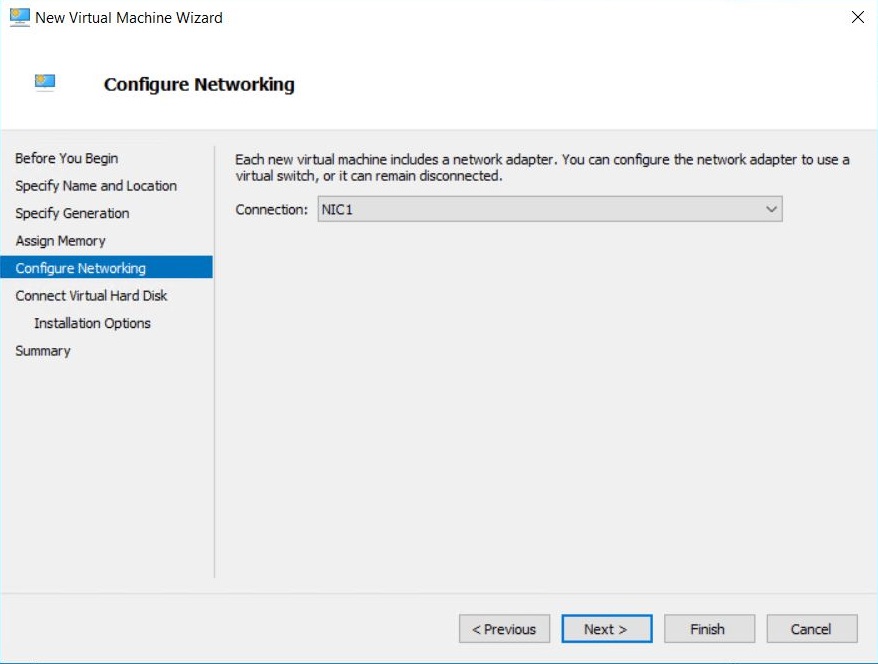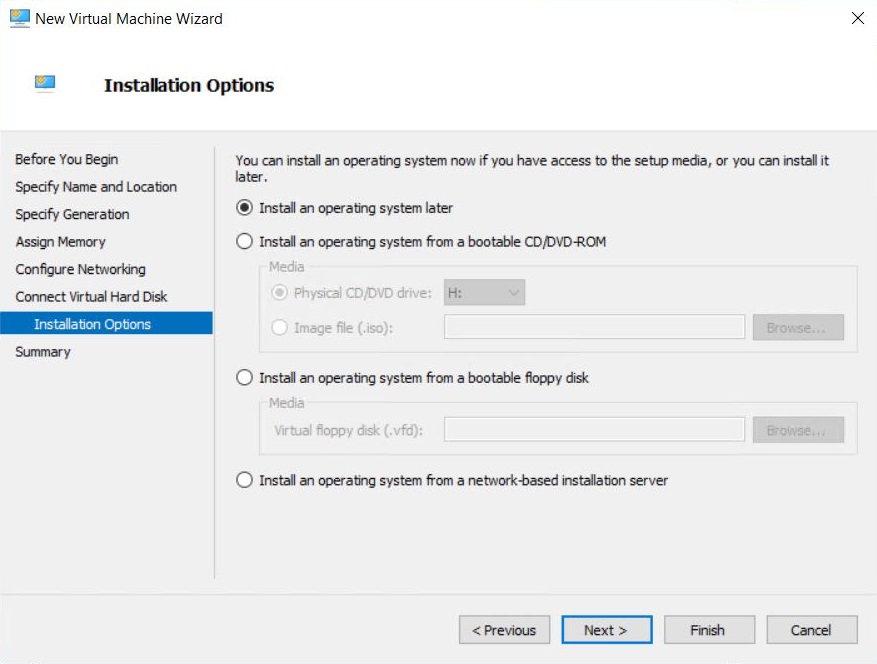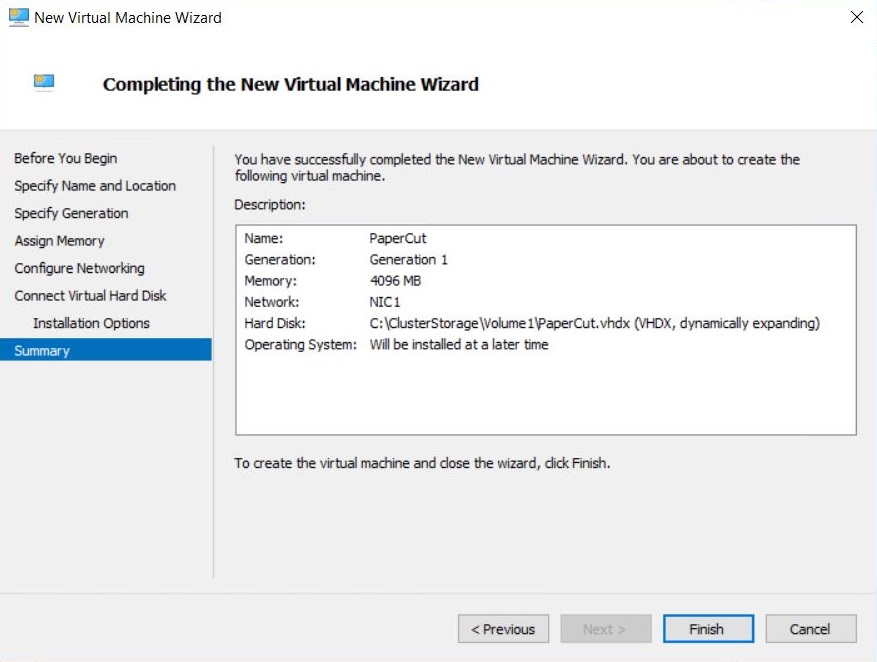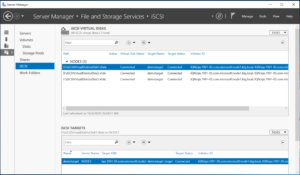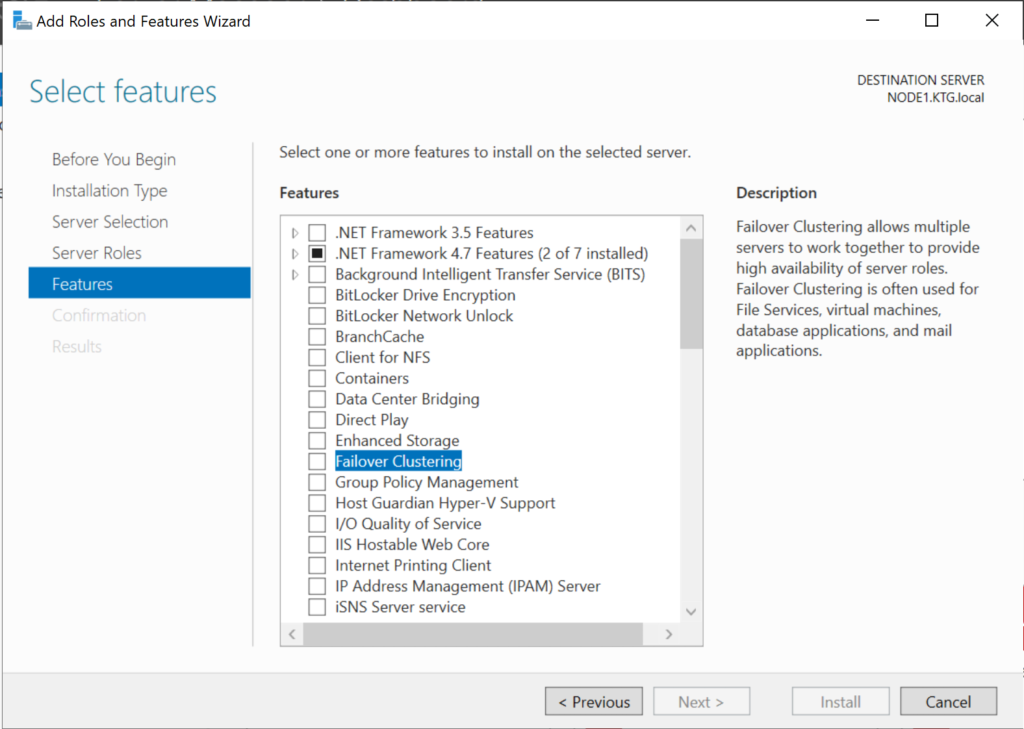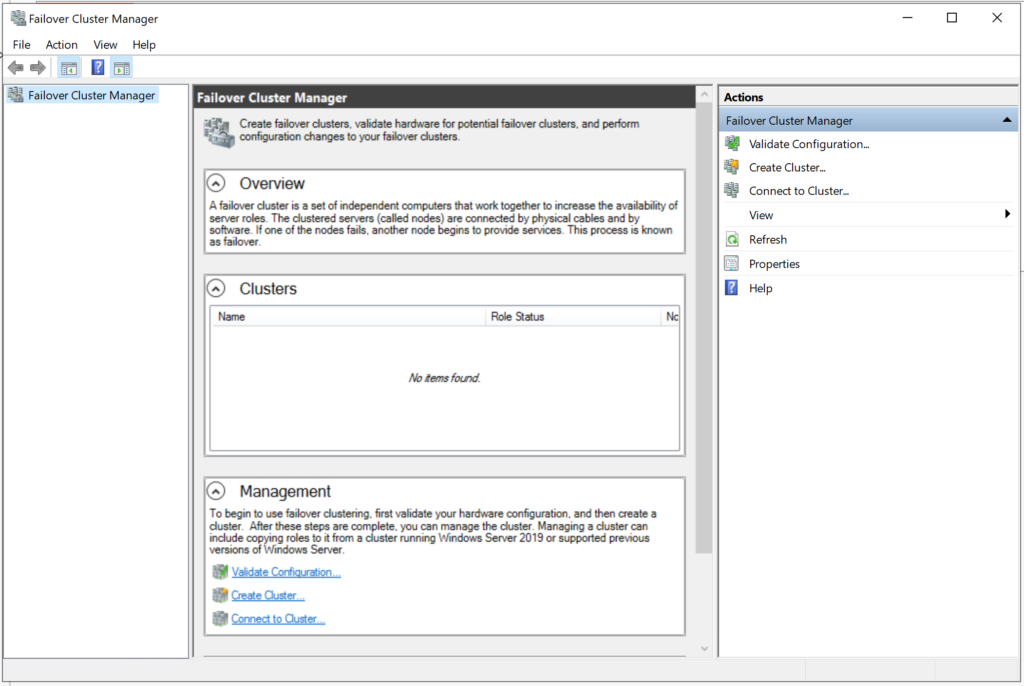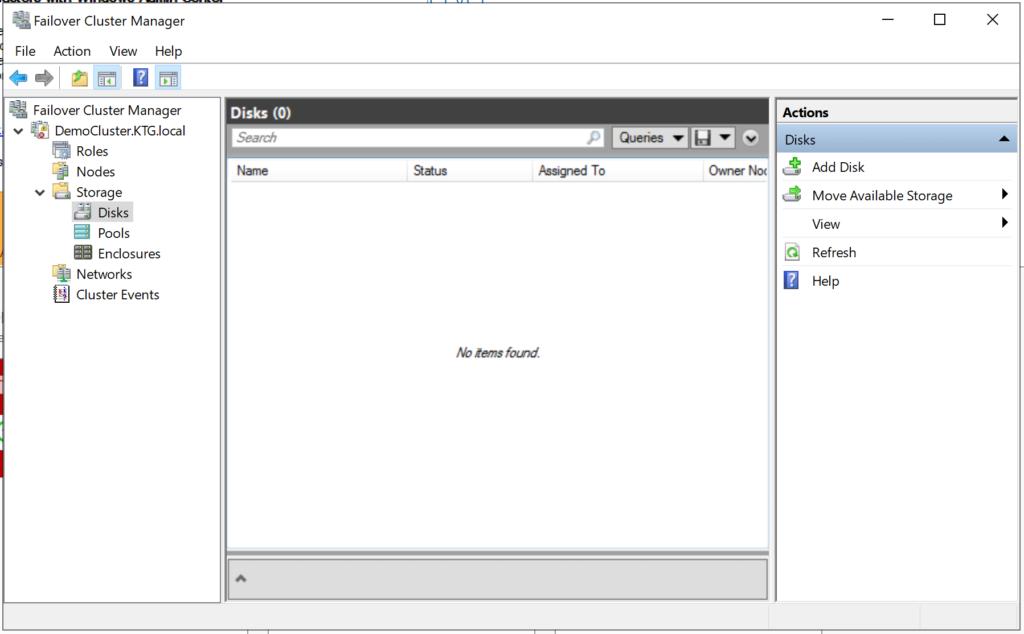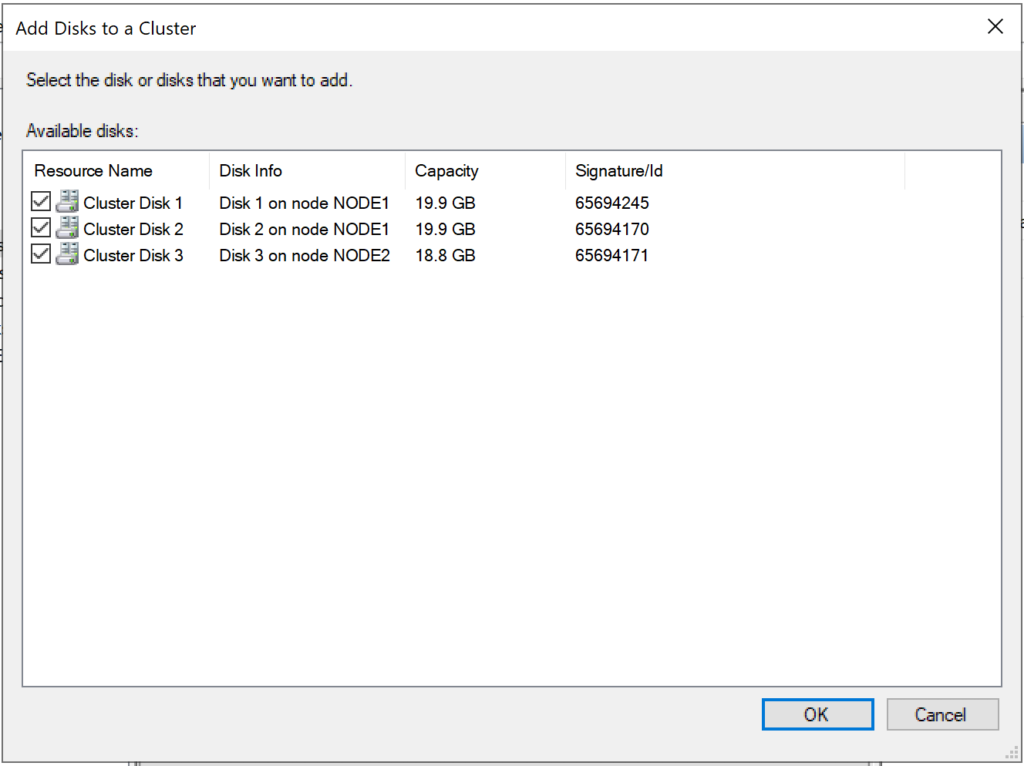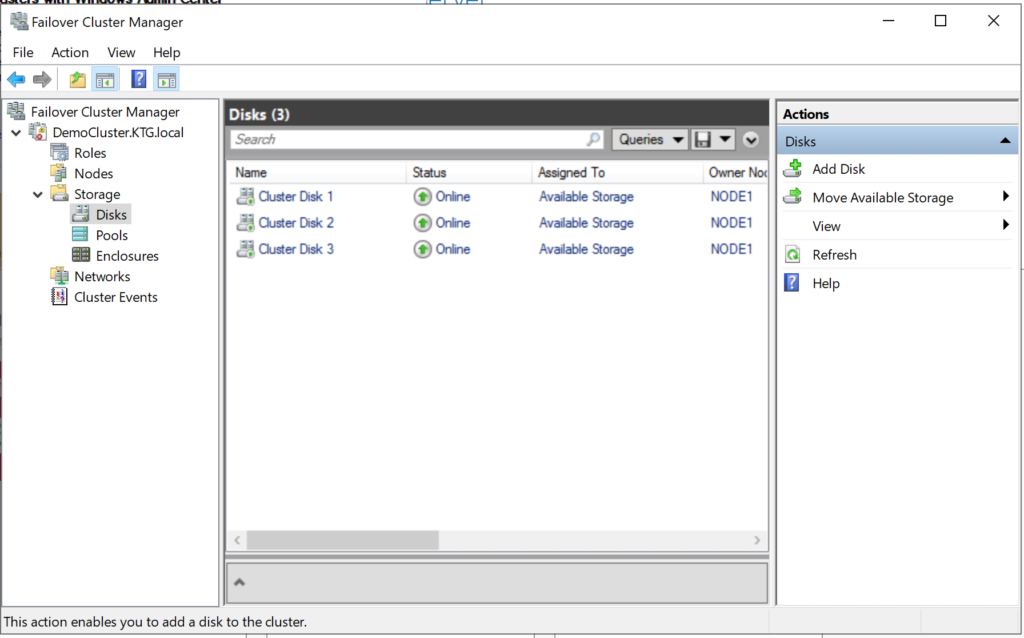This article gives a short overview of how to create a Microsoft Windows Failover Cluster (WFC) with Windows Server 2019 or 2016. The result will be a two-node cluster with one shared disk and a cluster compute resource (computer object in Active Directory).
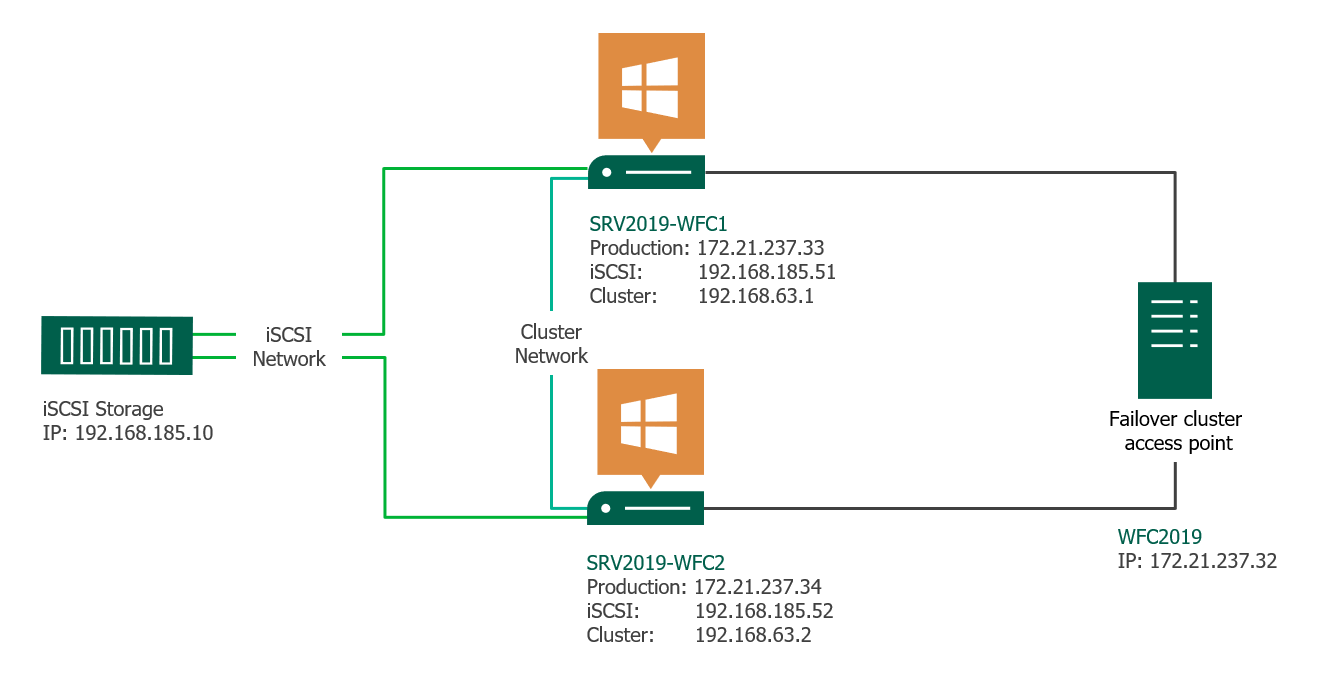
Preparation
It does not matter whether you use physical or virtual machines, just make sure your technology is suitable for Windows clusters. Before you start, make sure you meet the following prerequisites:
Two Windows 2019 machines with the latest updates installed. The machines have at least two network interfaces: one for production traffic, one for cluster traffic. In my example, there are three network interfaces (one additional for iSCSI traffic). I prefer static IP addresses, but you can also use DHCP.
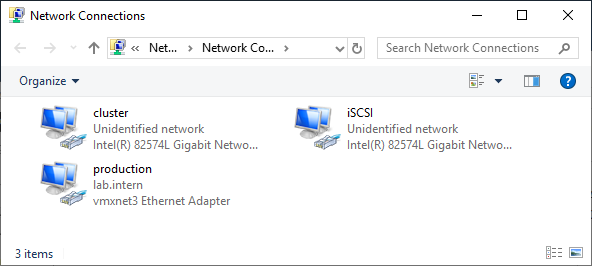
Join both servers to your Microsoft Active Directory domain and make sure that both servers see the shared storage device available in disk management. Don’t bring the disk online yet.
The next step before we can really start is to add the Failover clustering feature (Server Manager > add roles and features).
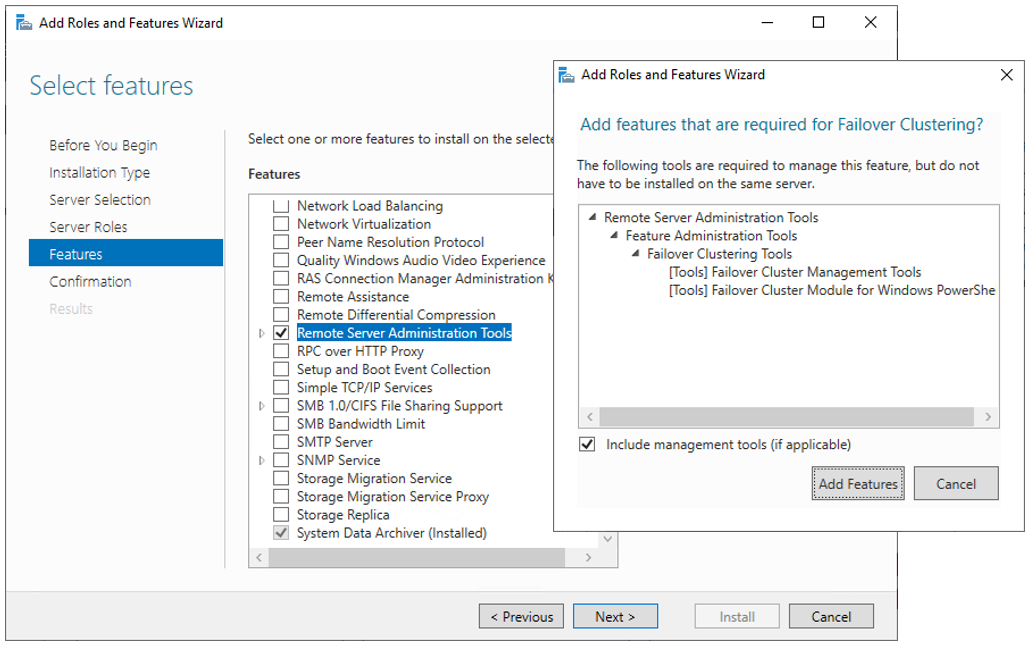
Reboot your server if required. As an alternative, you can also use the following PowerShell command:
Install-WindowsFeature -Name Failover-Clustering –IncludeManagementTools
After a successful installation, the Failover Cluster Manager appears in the start menu in the Windows Administrative Tools.
After you installed the Failover-Clustering feature, you can bring the shared disk online and format it on one of the servers. Don’t change anything on the second server. On the second server, the disk stays offline.
After a refresh of the disk management, you can see something similar to this:
Server 1 Disk Management (disk status online)

Server 2 Disk Management (disk status offline)
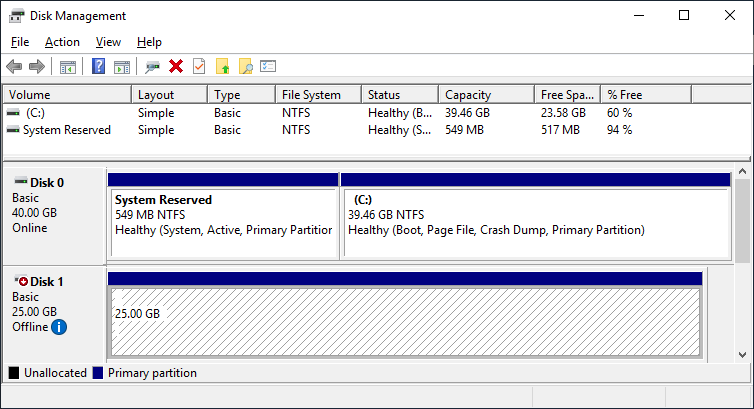
Failover Cluster readiness check
Before we create the cluster, we need to make sure that everything is set up properly. Start the Failover Cluster Manager from the start menu and scroll down to the management section and click Validate Configuration.
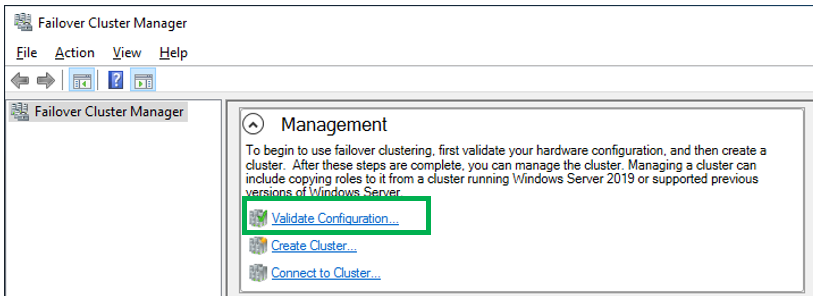
Select the two servers for validation.

Run all tests. There is also a description of which solutions Microsoft supports.
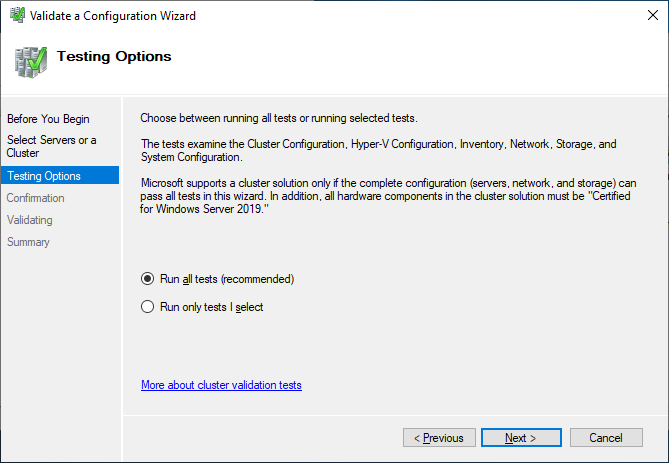
After you made sure that every applicable test passed with the status “successful,” you can create the cluster by using the checkbox Create the cluster now using the validated nodes, or you can do that later. If you have errors or warnings, you can use the detailed report by clicking on View Report.
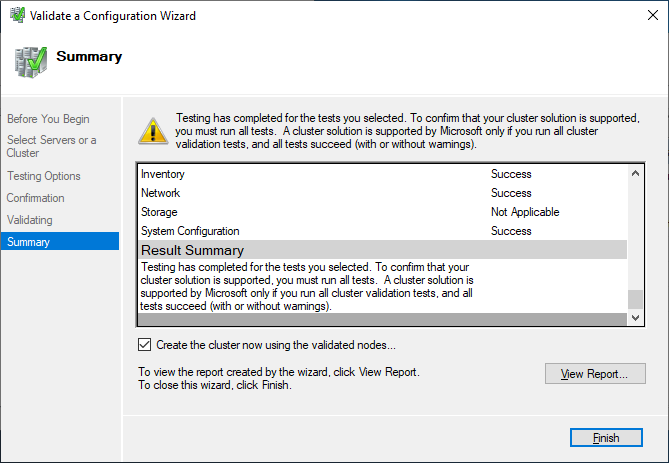
If you choose to create the cluster by clicking on Create Cluster in the Failover Cluster Manager, you will be prompted again to select the cluster nodes. If you use the Create the cluster now using the validated nodes checkbox from the cluster validation wizard, then you will skip that step. The next relevant step is to create the Access Point for Administering the Cluster. This will be the virtual object that clients will communicate with later. It is a computer object in Active Directory.
The wizard asks for the Cluster Name and IP address configuration.
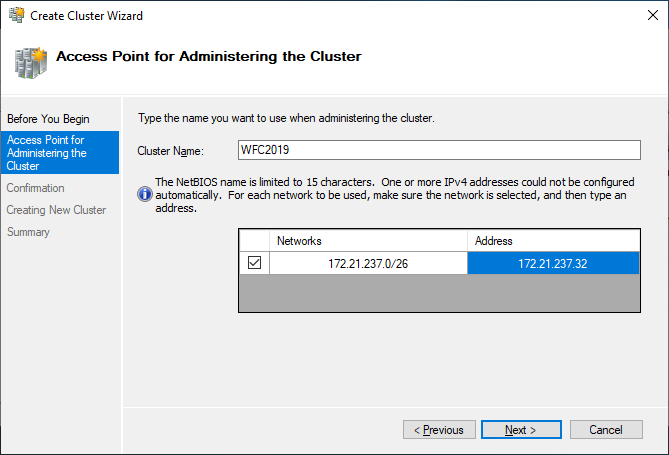
As a last step, confirm everything and wait for the cluster to be created.
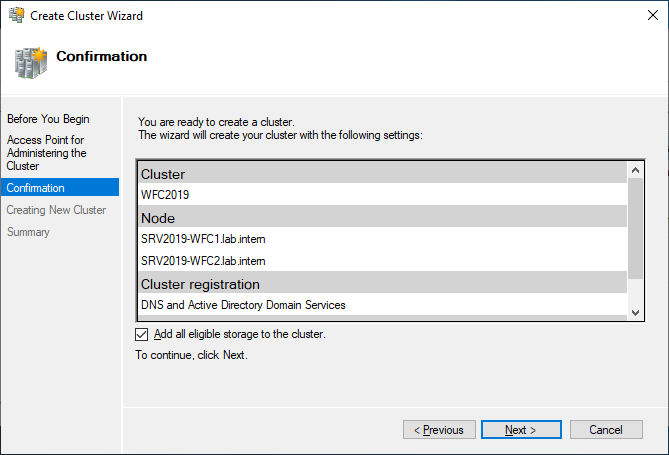
The wizard will add the shared disk automatically to the cluster per default. If you did not configure it yet, then it is also possible afterwards.
As a result, you can see a new Active Directory computer object named WFC2019.

You can ping the new computer to check whether it is online (if you allow ping on the Windows firewall).

As an alternative, you can create the cluster also with PowerShell. The following command will also add all eligible storage automatically:
New-Cluster -Name WFC2019 -Node SRV2019-WFC1, SRV2019-WFC2 -StaticAddress 172.21.237.32
You can see the result in the Failover Cluster Manager in the Nodes and Storage > Disks sections.
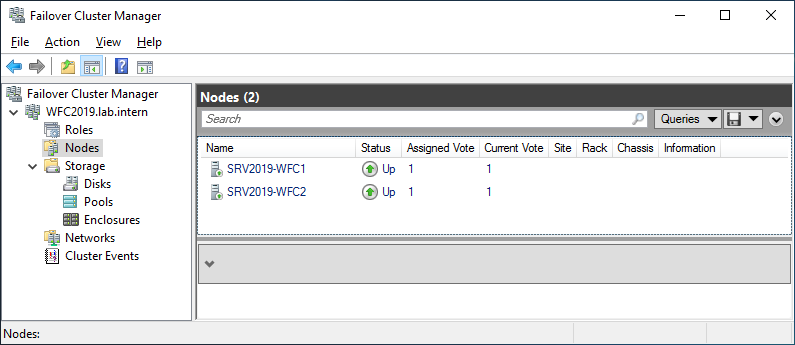
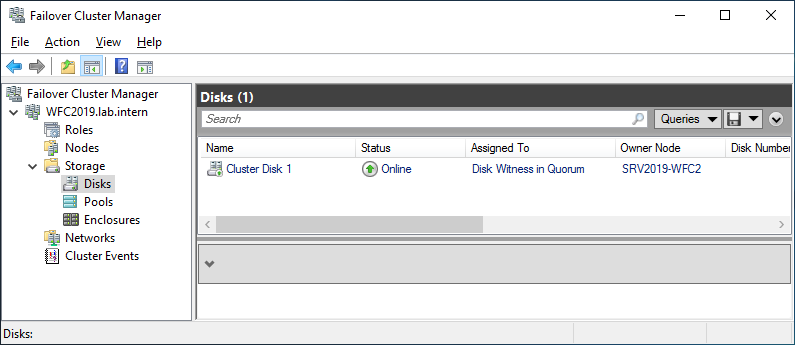
The picture shows that the disk is currently used as a quorum. As we want to use that disk for data, we need to configure the quorum manually. From the cluster context menu, choose More Actions > Configure Cluster Quorum Settings.
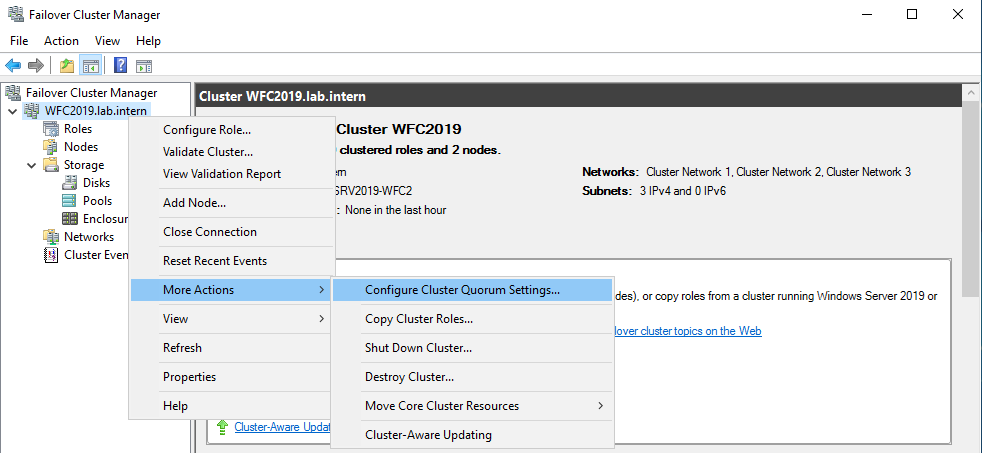
Here, we want to select the quorum witness manually.
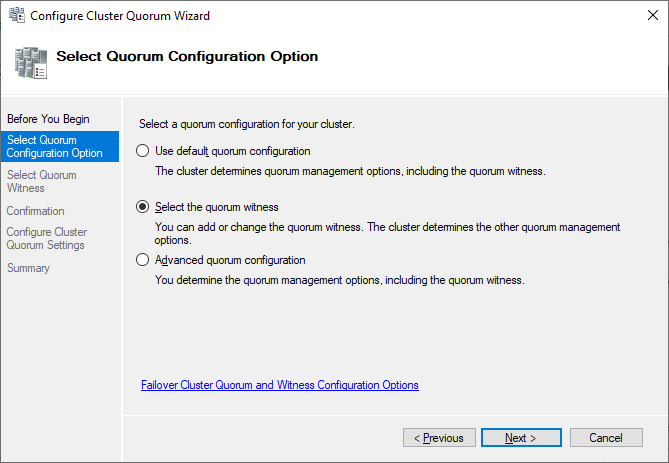
Currently, the cluster is using the disk configured earlier as a disk witness. Alternative options are the file share witness or an Azure storage account as witness. We will use the file share witness in this example. There is a step-by-step how-to on the Microsoft website for the cloud witness. I always recommend configuring a quorum witness for proper operations. So, the last option is not really an option for production.
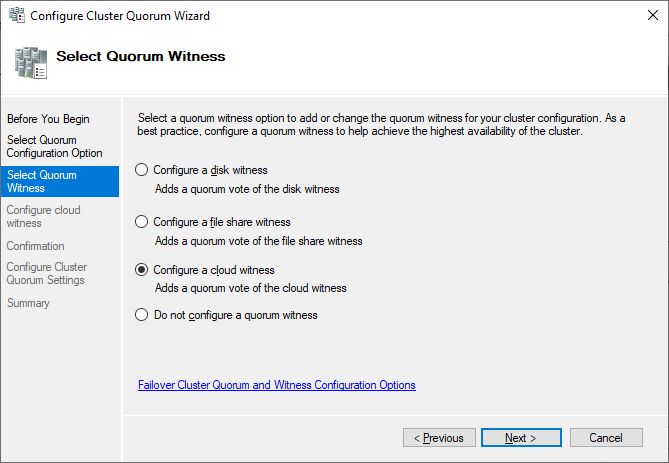
Just point to the path and finish the wizard.
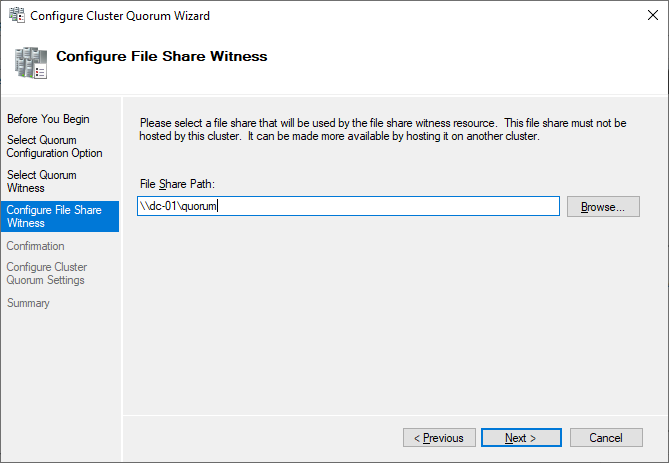
After that, the shared disk is available for use for data.

Congratulations, you have set up a Microsoft failover cluster with one shared disk.
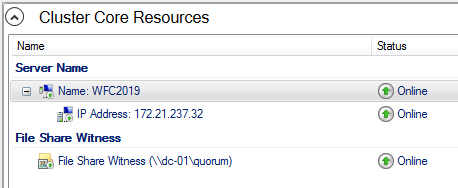
Next steps and backup
One of the next steps would be to add a role to the cluster, which is out of scope of this article. As soon as the cluster contains data, it is also time to think about backing up the cluster. Veeam Agent for Microsoft Windows can back up Windows failover clusters with shared disks. We also recommend doing backups of the “entire system” of the cluster. This also backs up the operating systems of the cluster members. This helps to speed up restore of a failed cluster node, as you don’t need to search for drivers, etc. in case of a restore.
See More:
- On-Demand Sessions from VeeamON Virtual
Failover clustering will enable you to make you Windows Server services highly available. In this guide we will go just through simple setup of failover clustering on Windows Server 2019 without setting up any services.
Before we begin
These are the resources you will need if you are completely new to Failover Clustering – https://docs.microsoft.com/en-us/windows-server/failover-clustering/create-failover-cluster
Prerequisites
I assume you know basic things about Windows Server before you attempt to do this.
DC
LAB for this guide consists of following:
Domain: informatiker.local
Domain Controller named DC1 – 10.0.0.31
ISCSI
One Windows Server ISCSI Target server named ISCSI1 (if you don’t know how to make ISCSI target server, here is the guide)
ISCSI1 – 10.0.0.50
That machine has one additional disk of 40GBs that will be assigned to ISCSI Target.
Optionally, you don’t have to bring up iscsi target server and configure iscsi for failover cluster – you can also bring up failover cluster without storage.
Failover cluster
We will have two nodes that will have failover clustering installed. These machines will have two network cards – one for communication with network, and another one for clustering communication.
Failover1 – NIC1 10.0.0.52 NIC2 192.168.4.2
Failover2 – NIC1 10.0.0.53 NIC2 192.168.4.3
192.168.4.xx network is only for internal cluster configuration (heartbeat). On netowrk cards that will serve you as heartbeat and internal cluster communication – Control Panel | Network and Sharing Center | Change Adapter Settings | right click on network adapter that will serve for cluster communication – Properties | under Networking tab select IPv4 – Properties | click on Advanced button | under DNS tab deselect Register this connection’s addresses in DNS | WINS tab – select Disable NetBIOS over TCP/IP. Do this ONLY ON network adapters that will server for internal cluster communication!
All of these machines should be part of domain.
Be sure to enable MPIO Feature and iSCSI Initiator on both Failover1 and Failover2 machines. Be sure to follow my guide I posted above for creating ISCSI target, it has all the details in it.
MPIO is very important when you use shared storage.
Connect one 40GB disk you defined as ISCSI target to both Failover1 and Failover2, leave it offline at failover2 node.
Cluster is going to be named Cluster1
Cluster1 – 10.0.0.54
Cluster Witness. We need additional VM that will hold file share that ill be available to our cluster – Witness1
Witness1 – 10.0.0.55
Install Failover Clustering
We will go through the process on Failover1 node, you will repeat the process on Failover2 node. I will show you only important parts, I assume you know how to use Server Manager.
Open Server Manager | click on Manage | Add Roles And Features | on Features screen select Failover Clustering
Additional pop-up will appear, click on Add Features
Next
Install
Close wizard and reboot server.
Repeat this process on Failover2 node.
Validate Cluster Configuration
After you installed Failover Clustering on both nodes, login to Failover1 node, click on Start | Windows Administrative Tools | select Failover Cluster Manager
Click on Failover Cluster Manager, and from the middle screen select Validate Configuration…
Next
Select both servers (in my case Failover1 and Failover2) and select Next
Run all tests | Next
Next
…
All test were success | Finish
We can proceed to creating cluster
Failover Cluster Manager | from Action screen, select Create Cluster
Next
Again select both servers that will be part of the cluster | Next
I will name cluster – Cluster1 and give it IP 10.0.54 | Next
Next
…
Success! Finish
We can now see created cluster1 and two nodes as part of it.
Add Cluster Quorum Witness
Cluster Quorum Witness will enhance your Failover Cluster Availability. I will not go into detail about witness role, you can find many more details here – https://docs.microsoft.com/en-us/windows-server/failover-clustering/manage-cluster-quorum
In our scenario, we will add File Share as Witness. since we have only two nodes, witness and one node will always have to be up, for cluster to be valid. So, make sure you plan you outages and patching so that you always have two nodes up.
On Witness1 machine, I added folder named ClusterWitness and shared it. In the screenshot below – three things are MISSING – you should also add Failover1, Failover2 and Cluster1 computers to this fileshare with full rights. Also, visit security tab of the shared folder and repeat procedure there!!
Back to Failover1 node – Open Failover Cluster Manager | select Actions | More Actions | Configure Cluster Quorum Settings
Next
Select the quorum witness | Next
You have many options, today we will select “Configure a file share witness” Next
Enter FQDN to your file share on witness1. In my case it is \witness1\ClusterWitness | Next
Review and click Next
Success! Finish
Now, we can see in Failover Cluster Manager that Witness is available.
That is it, we covered the basics and we can now start deploying various services in our clustered scenario.
Disclaimer
PRODUCT MANUALS
PaperCut NG & PaperCut MF Manual
PRODUCTS FEATURED
Since Microsoft Windows 2012, Microsoft have reconfigured the way in which you can manage High Availability with print services. They introduced the ability to use Hyper-V and failover clustering to make your print server a highly available virtual machine. This solution provides full server failover options and can be implemented with the PaperCut NG/MF Application Server, Secondary Server, and/or Site Server.
There are several steps involved in the setup of this failover solution:
-
Before you Begin
-
Step 1: Configure roles / features on nodes for high availability
-
Step 2: Connecting to iSCI network drives
-
Step 3: Create the failover cluster
-
Step 4: Create a high availability virtual machine
-
Step 5: Set up your print server
Before you Begin
Systems Requirements:
-
2+ physical servers
-
MS Server 2012/2016 with Hyper-V capabilities
-
iSCI SAN with 2 drives configured
-
Drive 1: 5GB (to be used for the Quorum if using only 2 nodes)
-
Drive 2: VM server storage
You will also require the following:
-
Administrative rights to be able to join machines to the domain
-
IP address to connect to your SAN
-
IP Addresses for the following:
-
2 x IP addresses for the Physical Servers
-
1 x IP address for the Cluster
-
1 x IP address for the VM
-
Step 1: Configure roles / features on nodes for high availability
-
Install MS Windows Server 2012 or MS Server 2016 onto your two server nodes.
-
In the Server Manager > Dashboard, click Add roles and features.
The Before you begin window is displayed.
-
Click Next.
The Select installation type window is displayed.
-
Select Role-based or feature-based installation.
-
Click Next.
The Select destination server window is displayed.
-
Select the server that you are logged in on.
-
Click Next.
The Select server roles window is displayed.
-
In the Roles list, select Hyper-V.
The Add feature that are required for Hyper-V window is displayed. This window shows the dependencies that will be installed.
-
Click Add Features.
-
Click Next.
The Select features window is displayed.
-
In the Features list, select Failover Clustering.
The Add features that are required for Failover Clustering window will pop up and now be displayed. This window shows the dependencies that will be installed with this feature.
-
Click Add Features.
The Hyper-V window is displayed.
-
Click Next.
The Create Virtual Switches window is displayed.
-
In Network adapters, select the network that you want your virtual machine to use for the cluster. If you have multiple NIC’s listed here, choose the appropriate one/s.
-
Click Next.
The Virtual Machine Migration window is displayed.
-
Select the Allow this server to send and receive live migrations of virtual machines checkbox. This allows the VM to transfer between your nodes where required.
-
Click Next.
The Default Stores window is displayed. Do not change the default stores.
-
Click Next.
The Confirm installation selections window is displayed.
-
Check the setting to ensure you are happy with the selected items to be installed.
-
Click Install.
The chosen Role and Feature will be installed on your machine.
-
When the installation is complete, restart the machine to finalize the installation.
-
Repeat the above steps on any additional nodes you want to include in the failover cluster.
Step 2: Connecting to iSCI network drives
-
Start the iSCI initiator then connect to your two SAN drives:
-
Click Start > Windows Administrative Tools > iSCI Initiator.
-
Ensure the drives are set to allow simultaneous connections. This is configured on your SAN. Make sure you have granted access to your two cluster servers.
-
-
Connect to the SAN drives:
-
Open iSCSI initiator.
-
Click the Targets tab.
-
In Target, enter the IP address for the SAN.
-
Click Quick Connect.
Your advertised drives are displayed.
-
Highlight a drive; then click connect to connect to each drive.
-
When a drive is connected, click Done.
-
Click the Volumes and Devices tab.
-
Click Auto Configure.
-
Click OK.
-
When you are connected on the first machine, click Start > Windows Administrative tools > Computer Management > Disk Management.
Your two disks appear as Unknown and Offline. They also display the size you configured on the SAN (eg: 5GB and 150GB).
-
-
Bring the disks online:
-
Right-click the disk number.
-
Select Online.
-
Repeat the above step for the second drive.
-
Initialize the disks:
-
Right-click the disk number next to one of the new drives.
-
Select Initialize disk.
-
In the box that appears, ensure that both your new disks have a tick mark next to them.
-
Set as MBR.
-
Click OK.
-
Configure the new drive:
-
Right-click the first drive.
-
Select Create New Simple Volume.
-
Leave the defaults in place.
-
Choose a drive letter to assign.
-
Label your drives:
-
5GB drive—label the drive as Quorum
-
150GB (larger drive)—label it as ClusterStorage
-
Repeat the above steps for the second drive.
Once this is done for your first node (Server), repeat these steps on your additional nodes (Servers). For example, from the two listed servers above (Server1 and Server2), you must connect the iSCSI drives on both systems before they will be available for your cluster.
Step 3: Create the failover cluster
From the OS of any of the nodes:
-
Click Start > Windows Administrative tools > Failover Cluster Manager to launch the Failover Cluster Manager.
-
Click Create Cluster.
The Before you Begin window is displayed.
-
Click Next.
The Select Servers window is displayed.
-
Enter the server names that you want to add to the cluster. Alternatively, you can locate them via Browse.
-
Click Add.
-
Click Next.
The Validation Warning window is displayed.
-
Select Yes to allow verification of the cluster services.
-
Click Next.
The Validate a Configuration Wizard is displayed. This wizard validates the server configuration.
-
Click Next.
The Testing Options window is displayed.
-
Select Run all tests (recommended).
-
Click Next.
The Confirmation window is displayed. This window lists all of the tests that will be run.
-
Click Next.
The Validating window is displayed while all of the clustering tests are being run. This process may take several minutes depending on your network infrastructure and the number of nodes you have chosen to add to your cluster.
-
When the tests have completed, check the report then fix any configuration errors. The cluster setup will fail if any errors exist.
The Access Point for Administering the Cluster window in the Create Cluster wizard is displayed.
-
In Cluster Name, enter a name for your cluster.
-
In the available network provide an IP address for the cluster.
-
Click Next.
The Confirmation window is displayed. This window lists the settings to be applied to your new cluster.
-
Select the Add all eligible storage to the cluster check box.
The system will now try to assign any storage it can find. -
Click Next.
The system attempts to create the new cluster in your domain. This may take a while as there are several checks that must take place and tests that are conducted while the system is configured.
When the process is complete, the Summary window is displayed stating that the cluster wizard completed successfully.
-
Click Finish.
-
Check to confirm that the cluster is configured correctly:
-
In the Failover Cluster Manager, navigate to Nodes.
-
Check that all nodes in the cluster are online. If they are not, go to the server that is offline and bring the system online to join the cluster.
-
Navigate to Storage > Disks.
The system detects the SCSI drives and displays them here. If you were setting this up with only two nodes, then the 5GB Quorum cluster would have been assigned as Disk Witness in Quorum.
The configured storage space is assigned to Available Storage.
-
Configure this storage to be part of the cluster:
-
Right-click the disk assigned to available storage; then select Add to Cluster Shared Volumes.
The cluster is now assigned to Cluster Shared Volume.
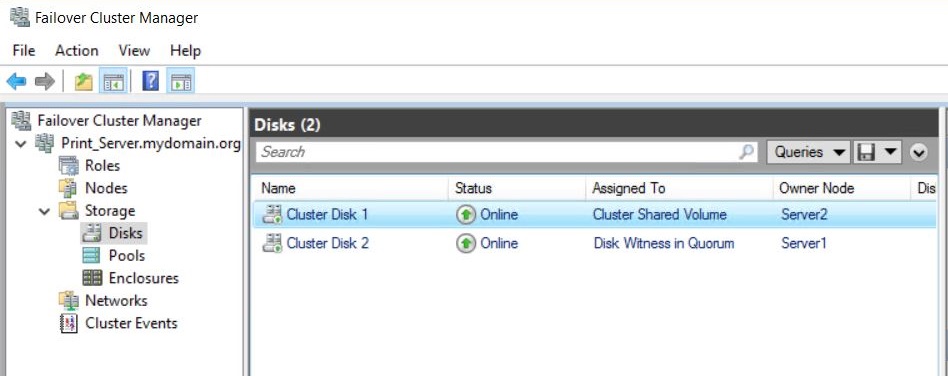
Step 4: Create a high availability virtual machine
-
In the Failover Cluster Manager, expand the cluster created in the previous steps.
-
Right-click Roles; then select Virtual Machines > New Virtual Machine.
The New Virtual Machine window is displayed.
-
Select the node you want to set the virtual machine up on. It doesn’t matter which node you choose, but we recommend you choose the node that you are currently working on.
-
Click OK.
The New Virtual Machine Wizard is displayed. This window explains the steps involved in setting up a virtual machine.
-
Click Next.
The Specify Name and Location window is displayed.
-
In Name, enter a name for your virtual machine.
-
In Location, enter the drive where the VM will be stored on the server.
For this VM to be able to move between the nodes, choose theClusterStorage\Volumedrive. This is usually located onC:\ClusterStorage\Volume1\or similar. -
Click Next.
The Specify Generation window is displayed.
-
Select the generation of virtual machine you want to use:
-
Generation 1—offers the best cross compatibility with versions. Generation 2 offers greater security, better performance, and supports the UEFI disk partitioning.
-
Generation 2—supported on the current releases, but not the older versions of Hyper-V. Also Generation 2 virtual machines are not supported by Azure.
-
-
Click Next.
The Assign Memory window is displayed.
-
In Startup memory, enter the relevant amount of memory that you want for this virtual machine.
-
If you want the memory to be dynamic, select the Use Dynamic Memory for this virtual machine check box.
-
Click Next.
The Configure Networking window is displayed.
-
In Connection, select the NIC you want to assign to this virtual machine.
-
Click Next.
The Connect Virtual Hard Disk window is displayed. -
In Name, enter a name for your virtual machine. This is the name that will be displayed in Hyper-V.
-
In Location, enter a location on the cluster drive for the hard drive. By default, this is usually created on your system under
C:\ClusterStorage\Volume1\. -
Set the hard drive size.
-
Click Next.
The Installation Options window is displayed.
-
Select the install location for your operating system. If you intend to perform this installation at a later time, select Install an Operating System Later.
-
Click Next.
The Completing the New Virtual Machine Wizard window is displayed. This window displays the options that you have selected for the configuration of this Hyper-V machine.
-
Review your selections and if you are happy with them, click Finish.
When the Hyper-V machine has been configured, the Summary window displays a Success message.
-
Click Finish.
-
If your two node machines are running different CPU models, enable processor compatibility:
-
With the virtual machine turned off, in Hyper-V Manager, highlight the machine.
-
From the Action pane select Settings > Processor.
-
Expand Processor then click Compatibility
-
Select the Migrate to a physical computer with a different processor check box.
-
Click OK.
-
-
Ensure that the new nodes are configured to accept the virtual machine in the event of a failover:
-
In the Failover Cluster Manager, select Roles.
-
Double-click your virtual machine.
-
On the General tab, under Preferred owners, select the nodes that you want to manage your virtual machine in the event of a failure.
-
Click OK.
-
Step 5: Set up your print server
-
From the Cluster Manager window start your VM and install Windows.
-
Configure the machine on your network.
-
For testing purposes, turn off Windows Firewall so you can RDP and Ping this machine.
-
Configure your print queues.
-
Test that printing works successfully:
-
Check printing on the server.
-
Map the print queue from a client machine on the network and test printing.
-
-
When printing is working successfully, test the failover.
-
In Failover Cluster Manager, right-click the VM you have created.
-
Click Move.
-
Select Quick Migration > Select Node.
-
Select a node that the VM is not currently residing on.
The VM will now start up on the other node.
-
-
When the virtual machine status shows that it is running, remote desktop into this machine to ensure it is still operational. Any windows you had open previously should still be running.
-
Install PaperCut NG/MF onto this machine.
-
Send several test print jobs to ensure that PaperCut NG/MF is operating correctly.
-
Install your shared print queues to a client machine.
-
Print a document.
-
Log in to the server node that the PaperCut NG/MF VM is running on; then restart the server.
-
While the server is restarting, from the client machine, send several test print documents to the shared printer.
-
The print jobs are processed and the VM fails over successfully to one of your other nodes.
HA achieved!
In this tutorial, we would learn how to install and setup Failover cluster in Windows Server 2019 step by step. In the previous tutorial, we configures an iSCSI storage server and created three virtual disk.
To install and configure a failover cluster, let’s look at our network setup, then we follow some steps
- Our Network Environment
- Determine the Cluster Disks
- Add Failover Clustering Role
- Create the Failover Cluster
- Add Disks to the Cluster
1. Our Network Environment
Our lab network is set up using VirtualBox and consists of 4 computers:.
How to set up a domain network is explained here.
DC (192.168.1.90) – This is our domain controller.
Node1 (192.168.1.91) – This is one of the failover cluster nodes and a iSCSI initiator.
Node2 (192.168.1.92) – This is the second failover cluster nodes and an iSCSI initiator.
Node3 (192.168.1.93) – This is out iSCSI target server. It hosts the virtual disks
2. Determine the Cluster Disks
Before you start creating the failover cluster, you need to determine the disk that hold the cluster data. This is so that if a member of the cluster fails, then the data would still be available. In our setup, we have decided to host the disks in another computer (Node3). This is configured as iSCSI target server and contain 3 virtual disk.
The figure below shows Node3 with the 3 iSCSI disks configured.
How to configure iSCSI target server and disks
Note: Ensure that the disks are iSCSI virtual disks are initialized on one of the failover nodes
3. Add the Failover Clustering Role
Now we have to install the Failover cluster role in Node1 and Node2. Follow the steps below to do that.
Step 1 – In Node1, click on Add Roles and Feature. This will launch the Add Roles and Features wizard. Follow the steps and select Failover Clustering as shown below. Then complete the installation.
Step 2 – Repeat the process for Node2
4. Create the Failover Cluster
We would now use the Failover cluster manager to create a cluster. Follow the steps below:
Step 1 – In Node1, click on Manager and select Failover Cluster Manager. The window is shown below
Step 2 – Click on Validate Configuration and follow the wizard steps to do the validation (this is done only in Node1). The wizard will ask you to specify the Servers you want to participate in the clustering. You will use AD to find Node1 and Node2 and select them.
At the end of the validation, you may have warning relating to unsigned drivers. Ignore these warnings because they come from VirtualBox Guest Additions.
Step 3 – Click on Create Cluster. You will have to select the Node1 and Node1. Then you need to specify the cluster name. The complete the cluster creation. The figure below shows the final screen indicating the cluster creation was successful.
5. Add Disks to the Cluster
Failover clusters require disks and in this case we would used virtual disks from the iSCSI target server.
Step 1– Add storage to the cluster. To do that open the Failover Cluster manager as shown below.
Step 2 – Click on Add Disk. The three iSCSI disks would be listed. Ensure that they are selected.
Click on OK.
At this point, the disks are added to the cluster and they are online as well. See the figure below
In subsequent tutorials, I discuss the concept of Witness in failover cluster and how to configure Quorum witness and Disk witness.
I also recommend you watch the video in my Youtube Channel.
In this blog, we’ll learn the skill to make a Microsoft Windows Failover Cluster with Windows Server 2019. The environment may be a two-node cluster with one shared disk.
Environment details:
SRV2019-DC
10.0.0.20
SRV2019-1
Primary – 10.0.0.30
Cluster – 192.168.0.10
SRV2019-2
Primary : 10.0.0.40
Cluster: 192.168.0.20
iSCSI Storage : 10.0.0.100
Cluster Name – XTCLUSTER
Cluster IP Address – 10.0.0.110
1- Before we start, make sure you meet the following prerequisites:
I have 2 Windows Server 2019 machines with the latest updates installed. The machines have at least two network interfaces, I rename them Primary and Cluster.
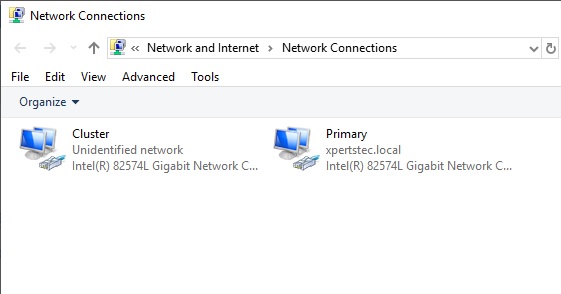
Join both servers to your Microsoft Active Directory domain and confirm that both servers see the shared memory device available in disk management. So, don’t bring the disk online yet.
2- User the Following PowerShell command to enable failover clustering and management Toole 1 Node (SRV2019-1)
Install-WindowsFeature -Name Failover-Clustering –IncludeManagementTools
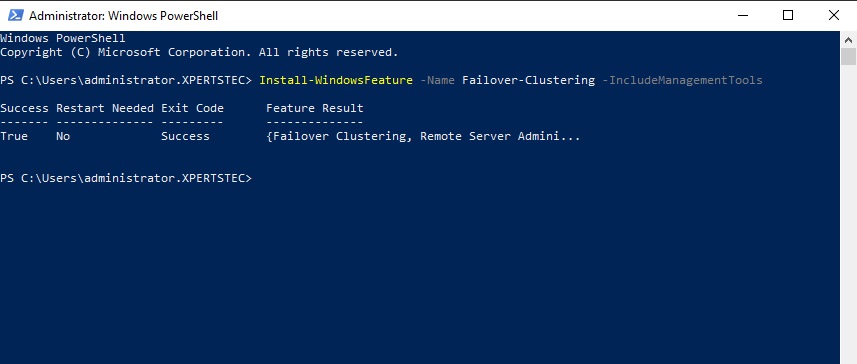
Failover Cluster Server 2019
Enabling Failover Manager Feature in 2 Node (SRV2019-2).
3- Open Server Manage select dashboard and then click on ADD Roles and Features.
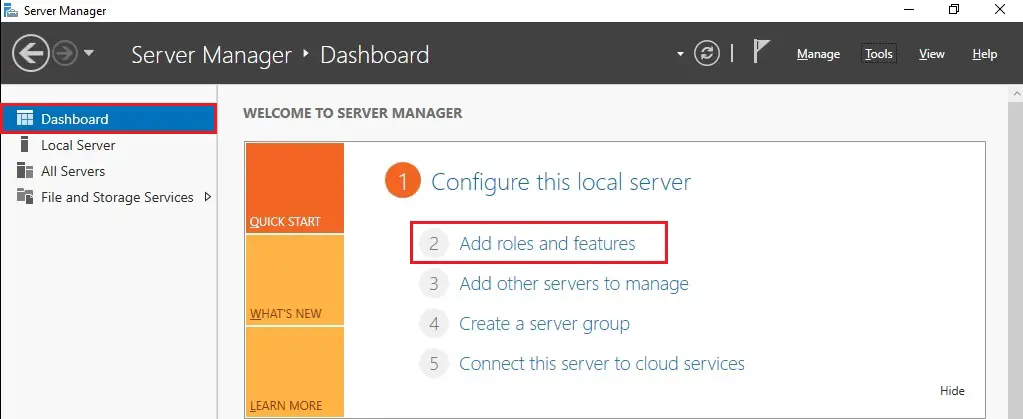
4- So, click Next.
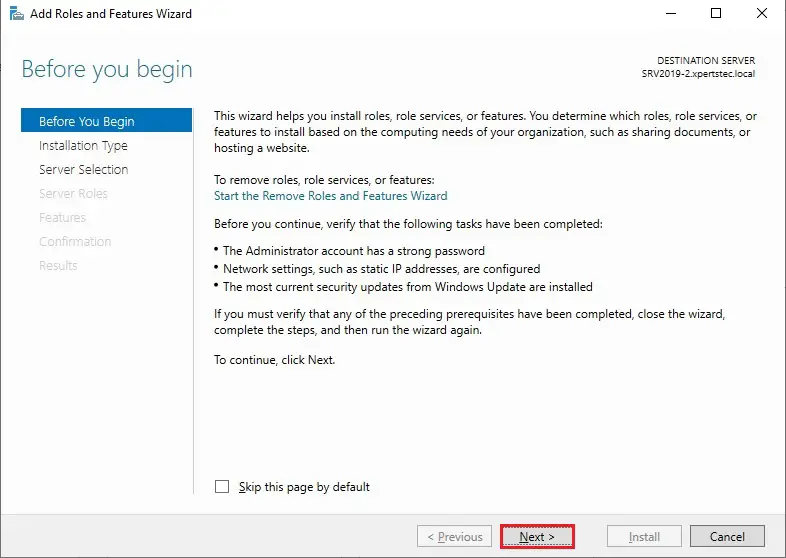
5- Click Role-based or feature-based installation and then click Next.
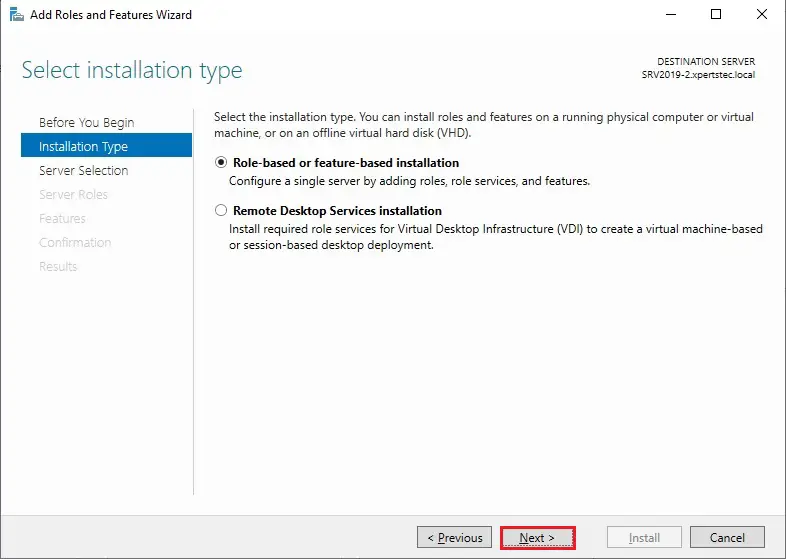
6- Select a server from the server pool and then click next.
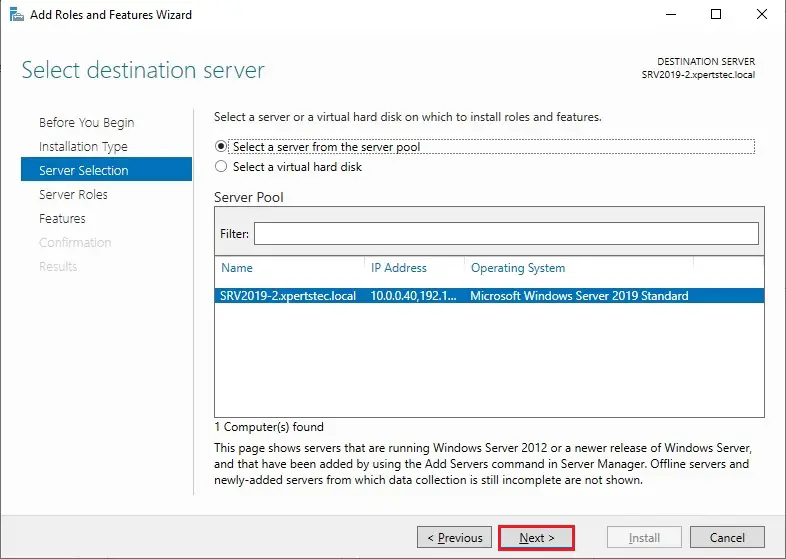
7- So, click Next.
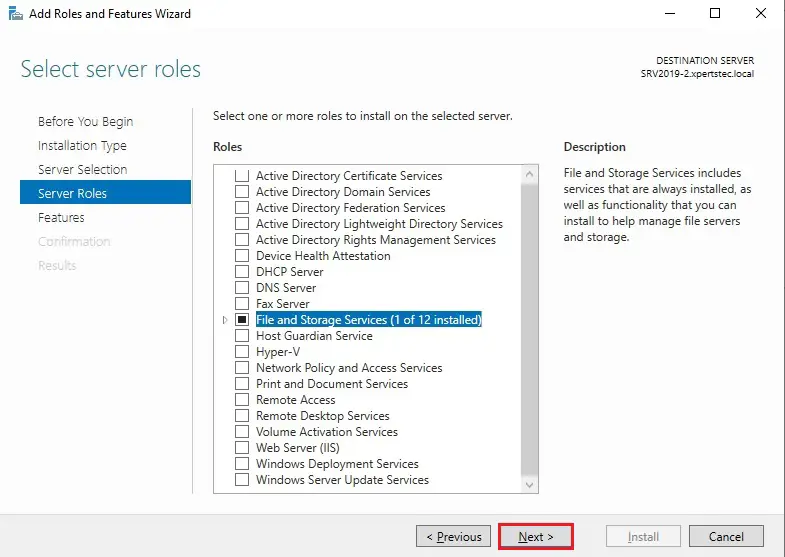
8- Select Failover clustering.
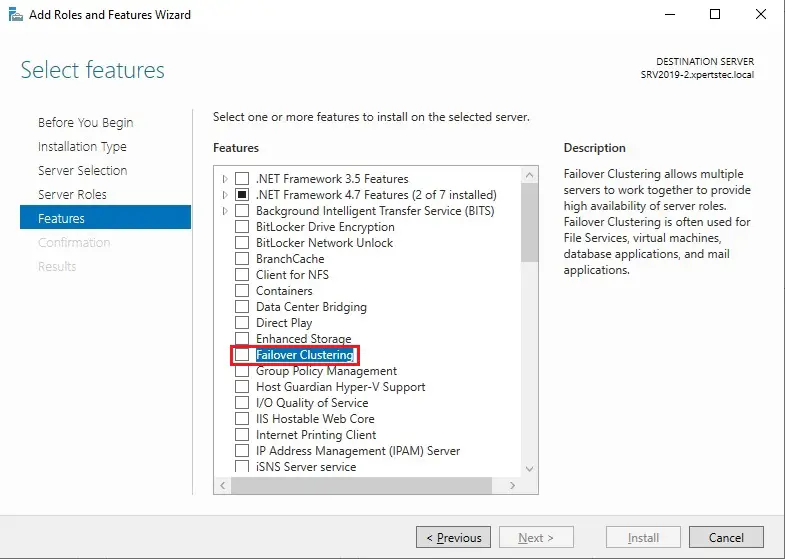
9- Click Add features.
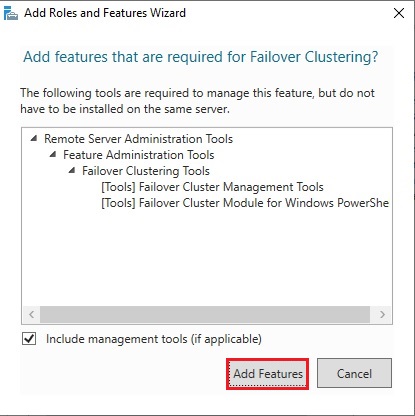
10- After enabling the failover clustering feature so, click next.
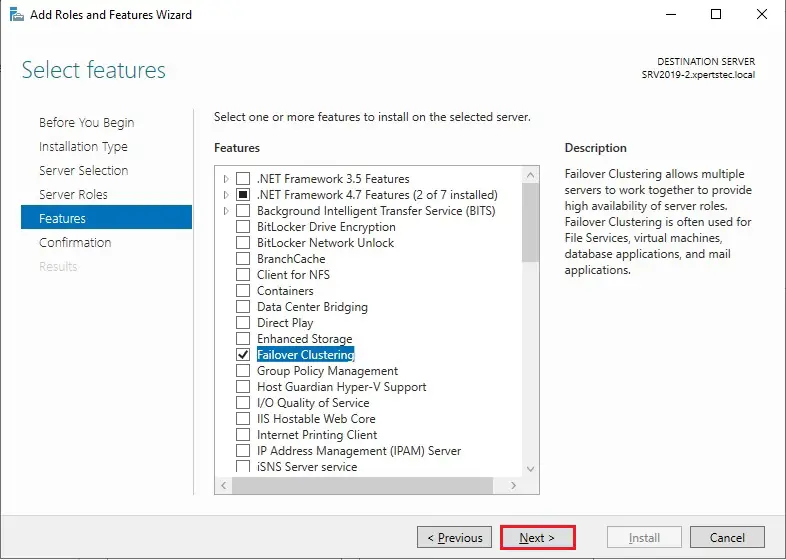
11- Then click Install.
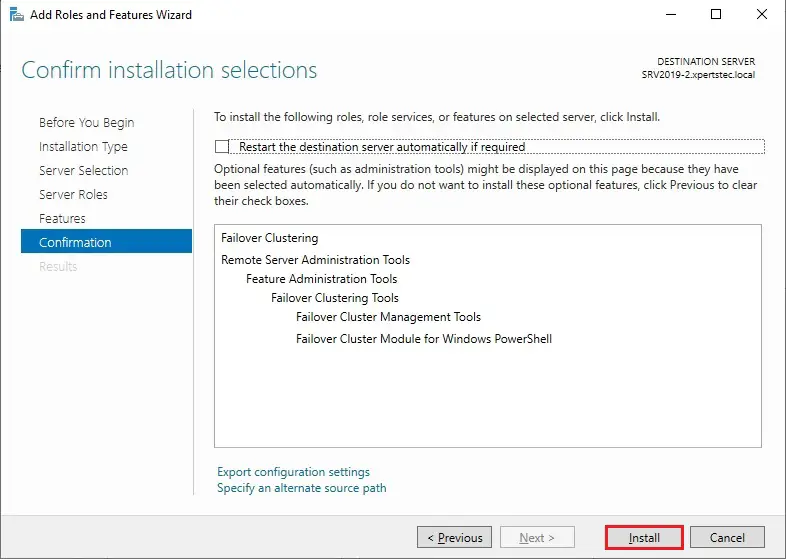
12- Successfully enable the Failover cluster feature so, click Close.
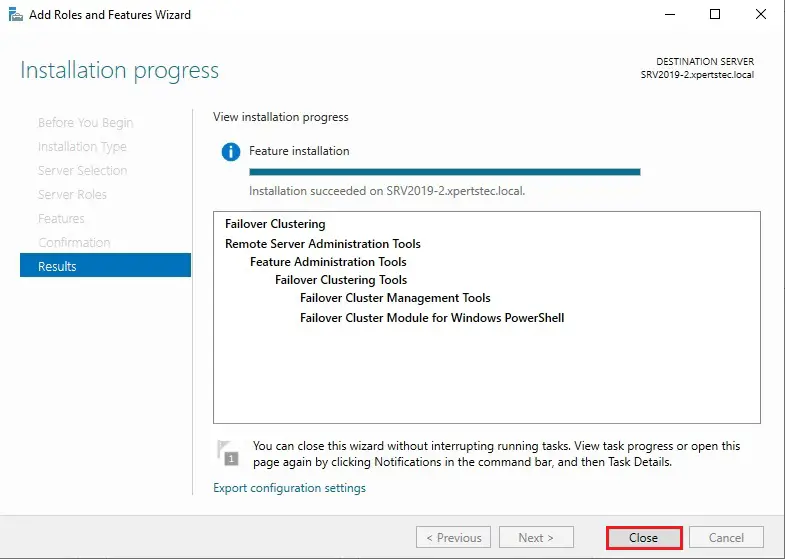
13- After a successful installation, it appears in the Server Manager, click Tools, and then Failover Cluster Manager.
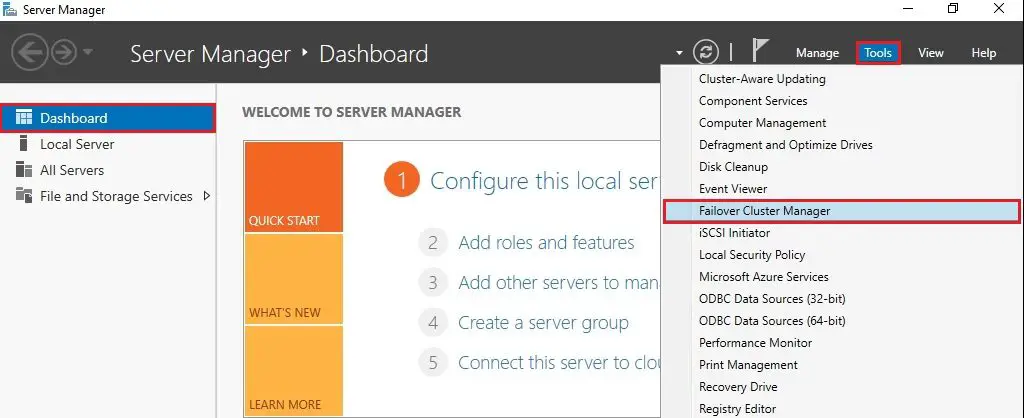
After you installed the Failover Clustering feature so, you can bring the shared disk online and format it on one of the servers 1 Node (SRV2019-1).
The following steps are performed on the 1 Node (SRV2019-1).
14- In Server Manager click Tools and then click Computer Management.
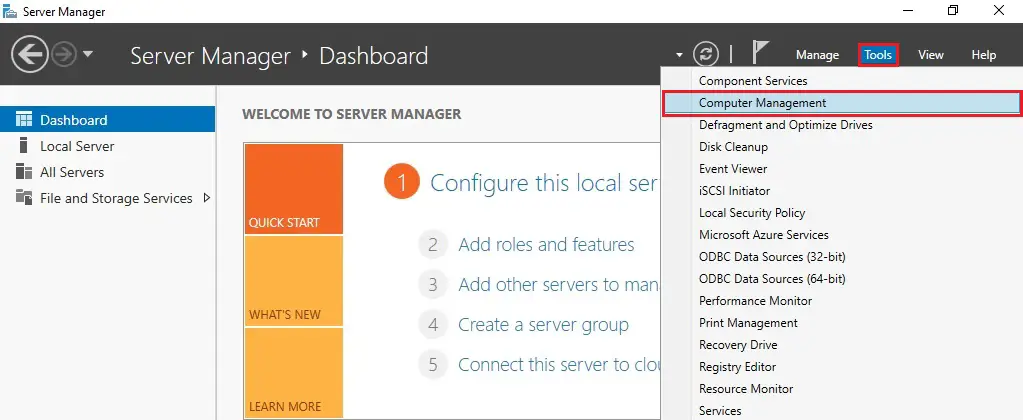
15- Click on Disk Management.
ou will see disk 1 which is in offline status right click on disk 1 and then select Online.
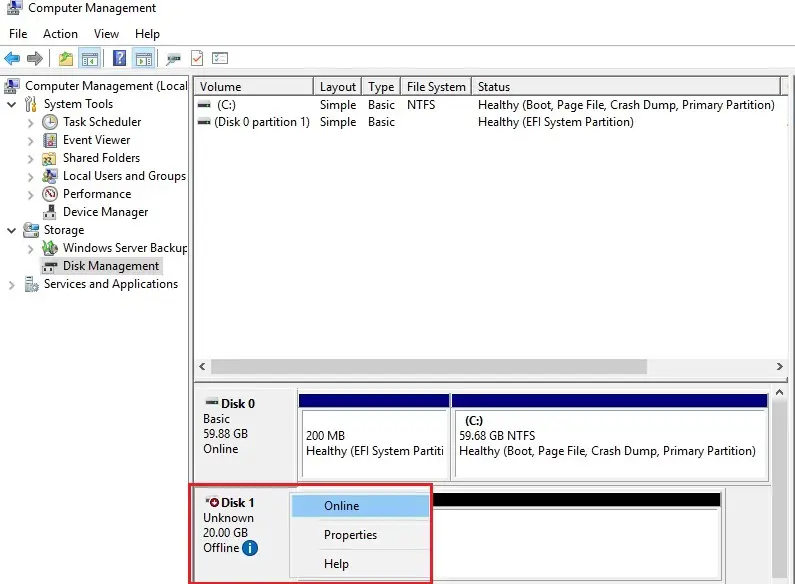
16- Right-click on disk 1 and click Initialize Disk.
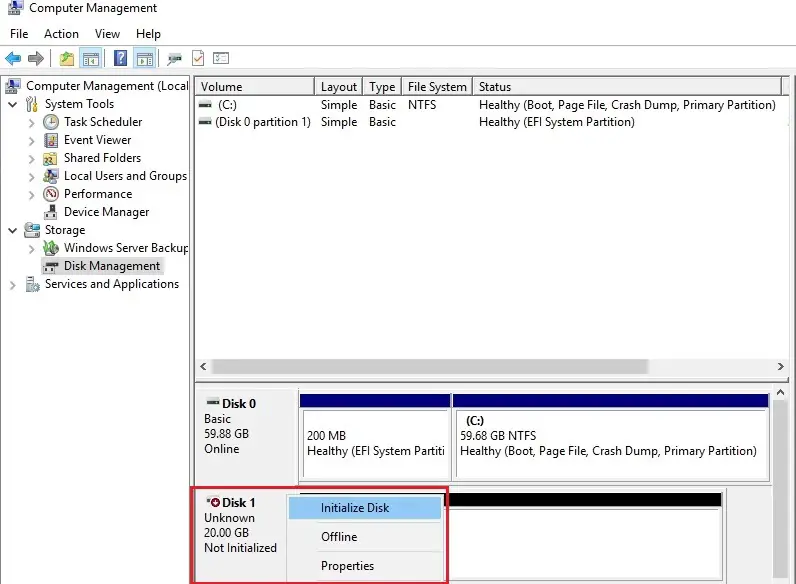
17- Click OK.
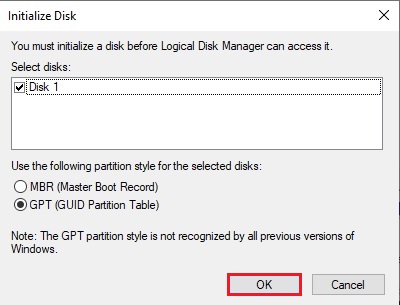
18- Right-click on unallocated disk 1 and select New Simple Volume.
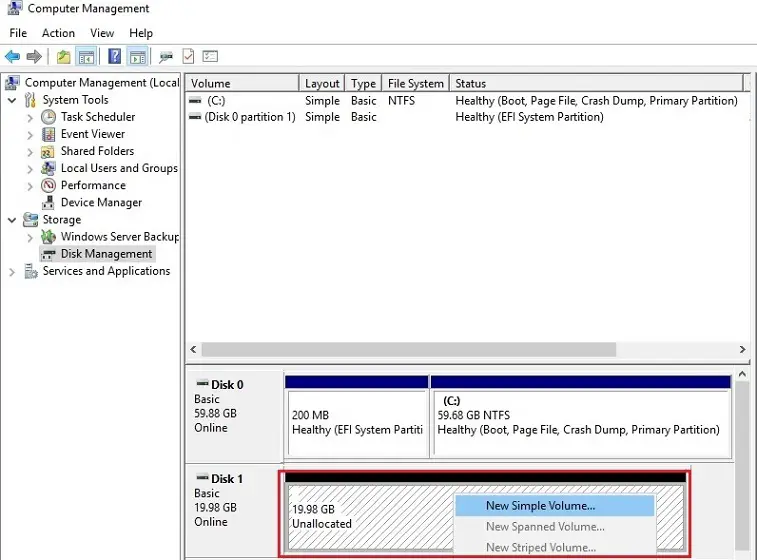
19- Click Next.
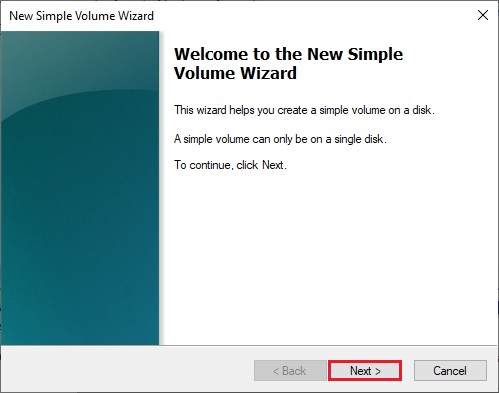
20- Click Next.
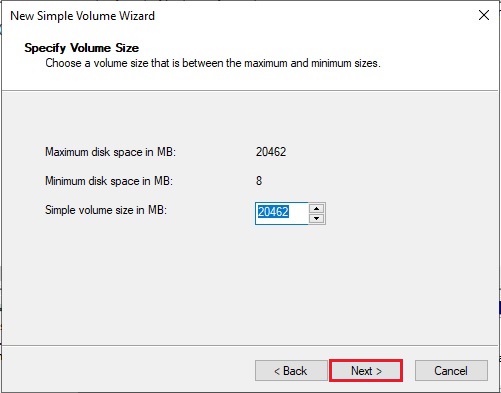
21- Assign a drive letter and click Next.
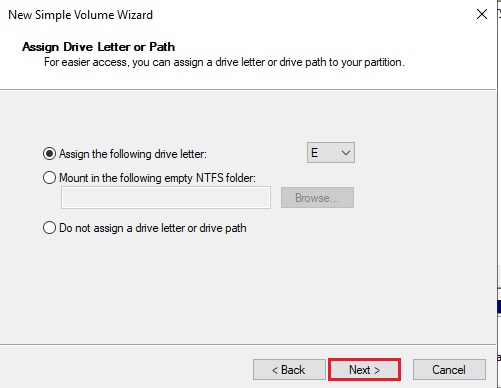
22- Type a volume label and click next.
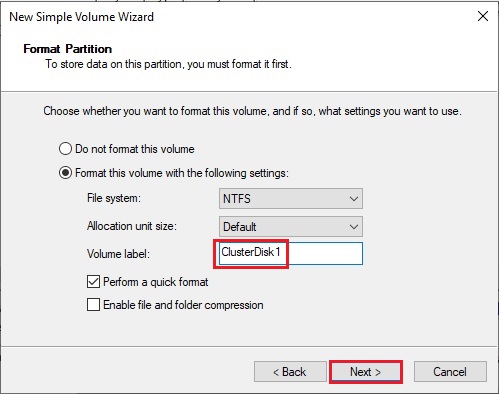
23- Click Finish.
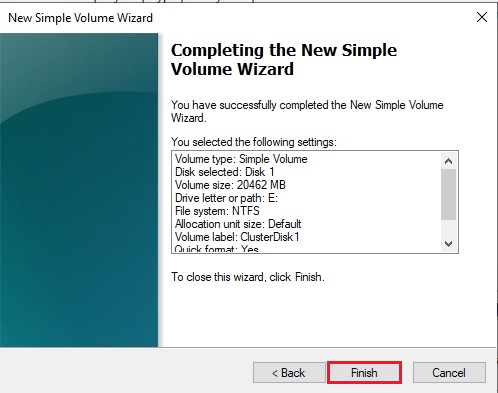
24- 1 Node (SRV2019-1) Disk Management (disk status online)
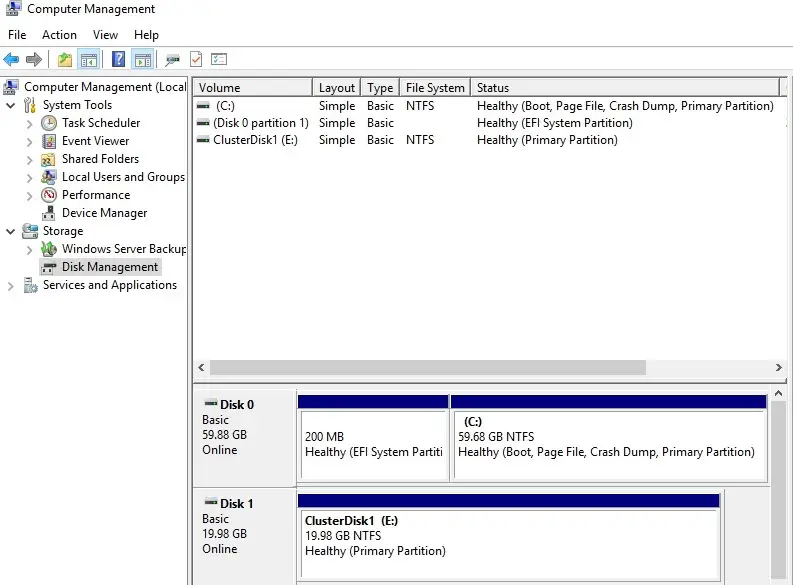
25- Please Don’t change anything on the 2nd Node (SRV2019-2), the disk stays offline. 2ND Node (SRV2019-2) Disk Management (disk status offline).
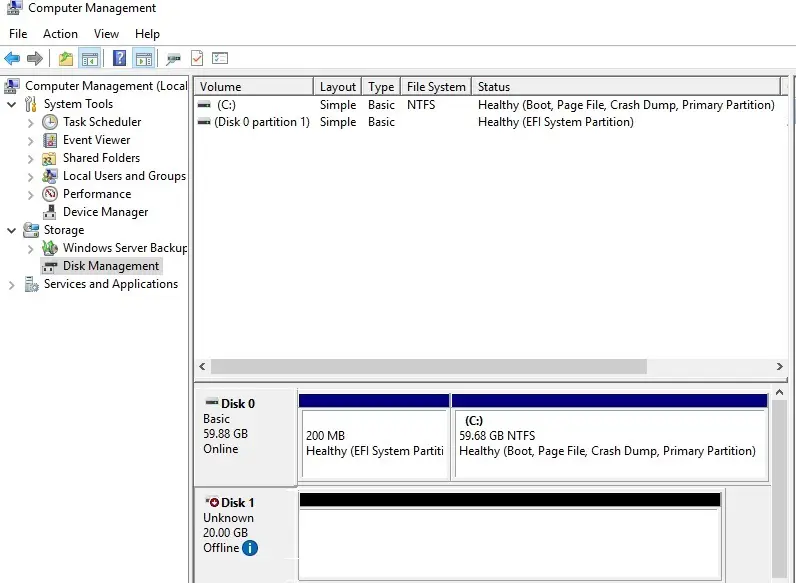
Failover Cluster readiness check-in 1 Node (SRV2019-1).
Before we create the cluster, we’d like to form sure that everything is about up properly.
26- In Server Manager click Tools and Click Failover Cluster Manager.
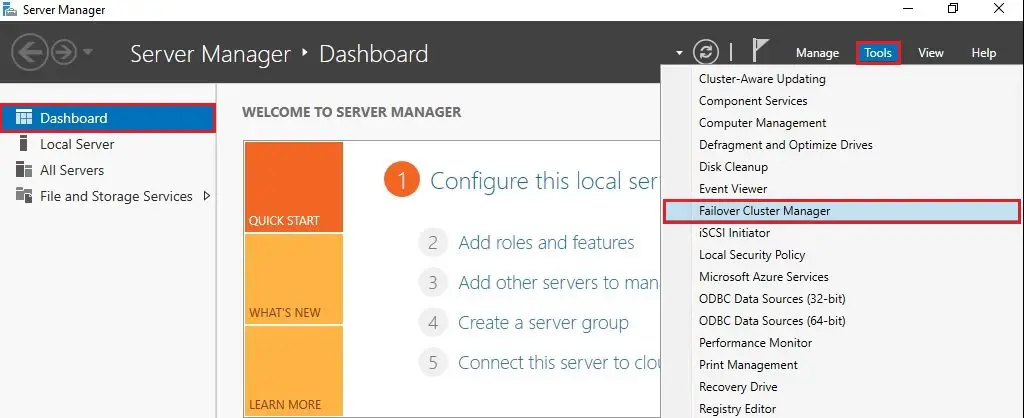
27- Under Action menu click Validate Configuration.
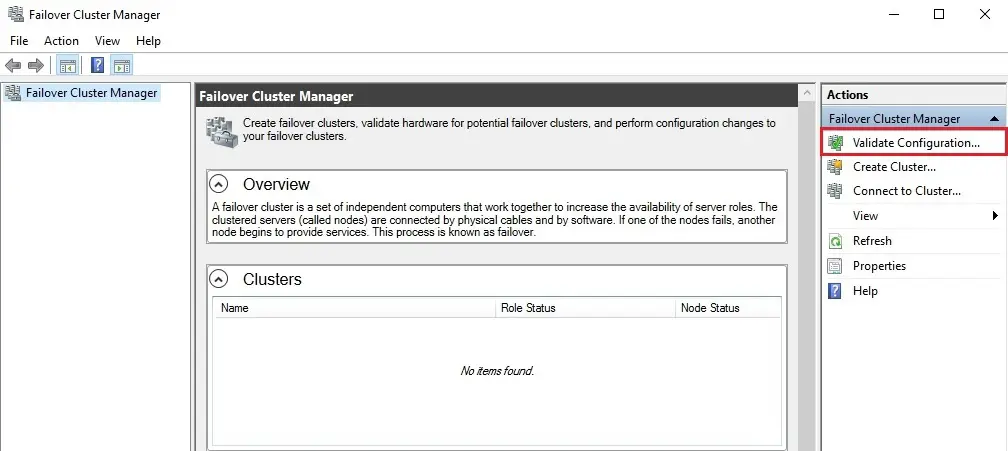
28- Click Next.
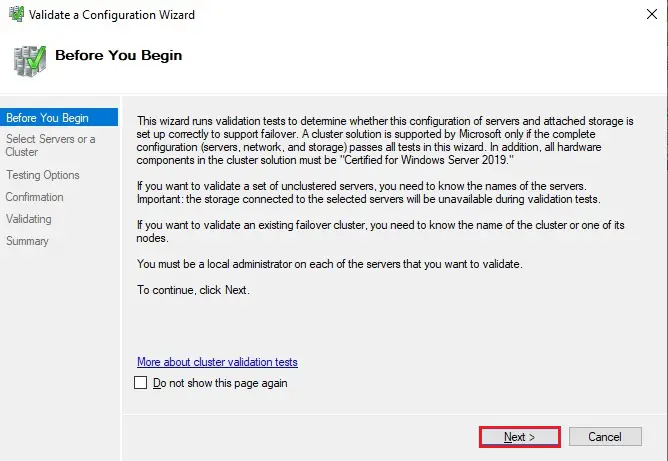
29- Select the browse button.
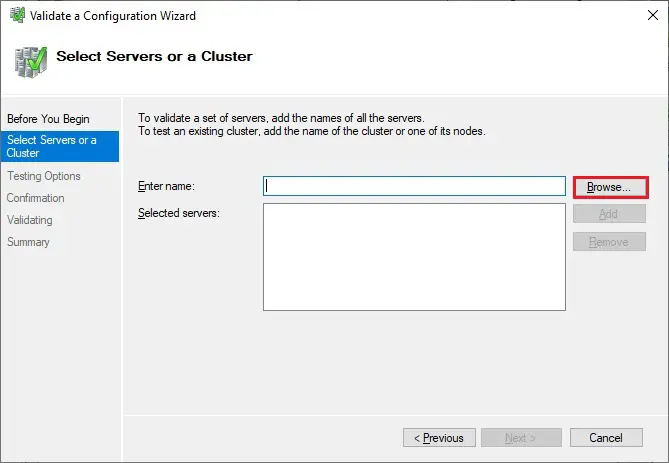
30- Type both the Nodes name, click check name and click ok.
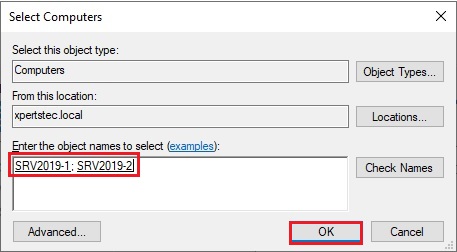
31- After Selecting the two-node servers for validation, click next.
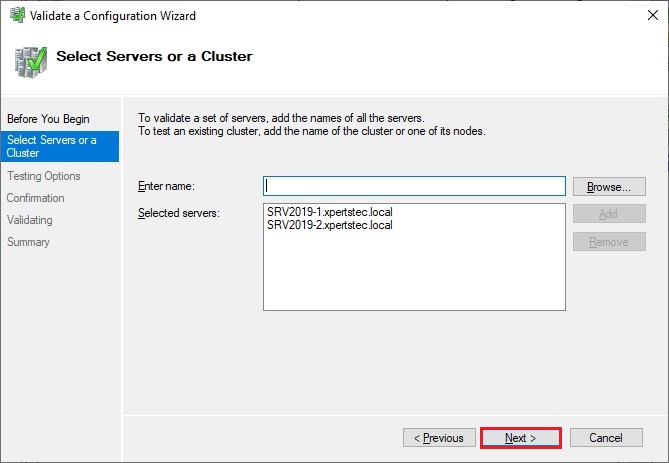
32- Select Run all tests (recommended) and click next.
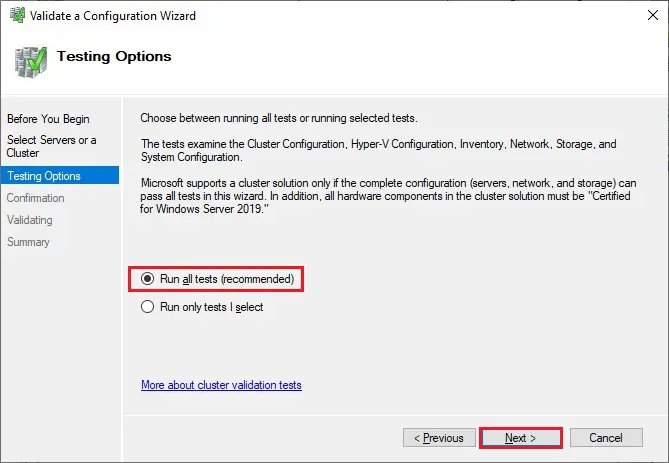
33- Review the validate configuration confirmation and click next.
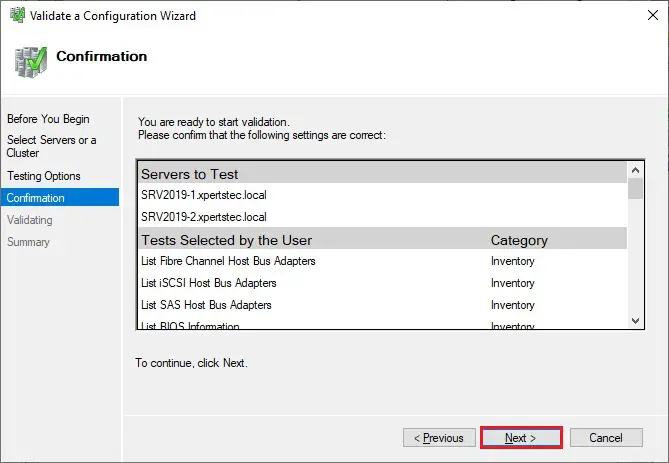
34- Cluster validation testing is in progress.
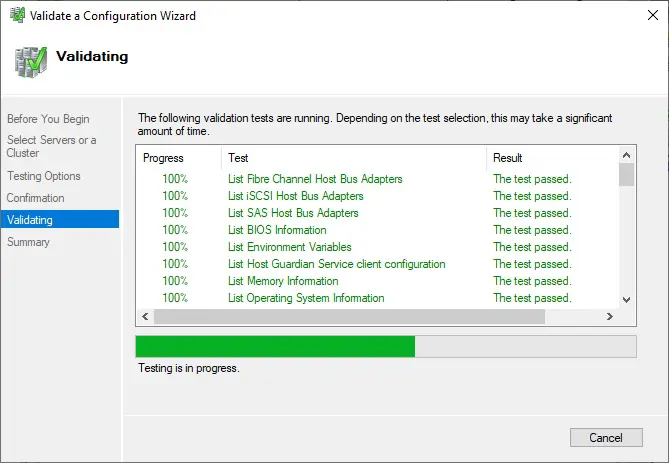
35- After you make sure that every applicable test passed with the status successful. If you have any errors or warnings, you can use the detailed report by clicking on View Report and click Finish.
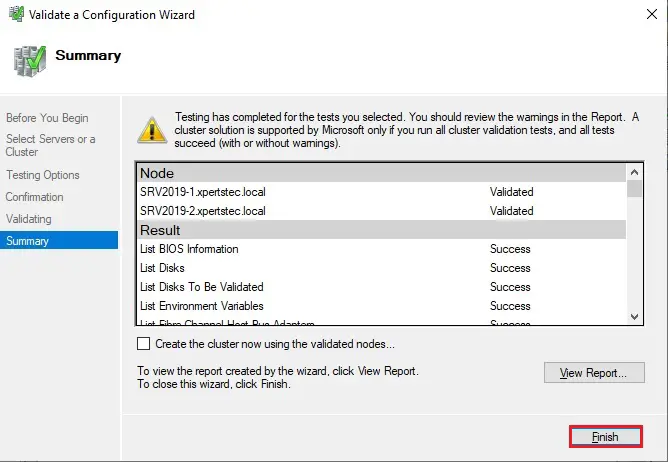
Create a Failover Cluster Server 2019
36- Under Action Menu so, select Create Cluster.
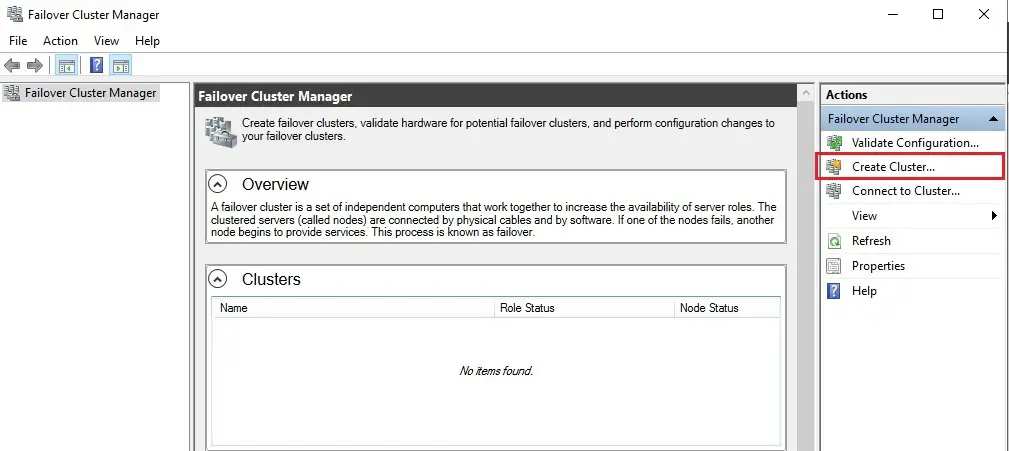
37- Click Next.
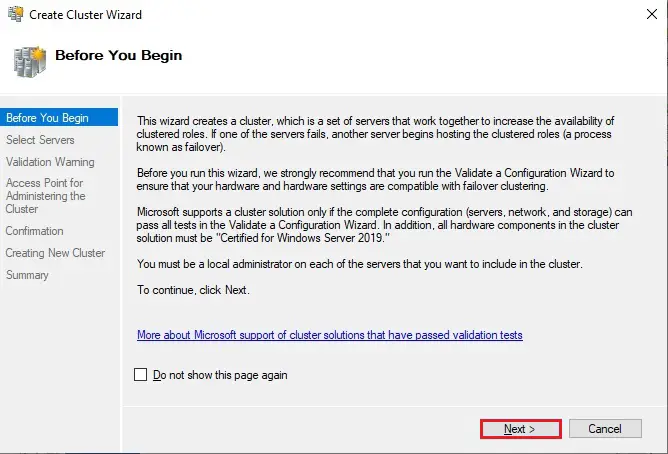
38- Click the browse button.
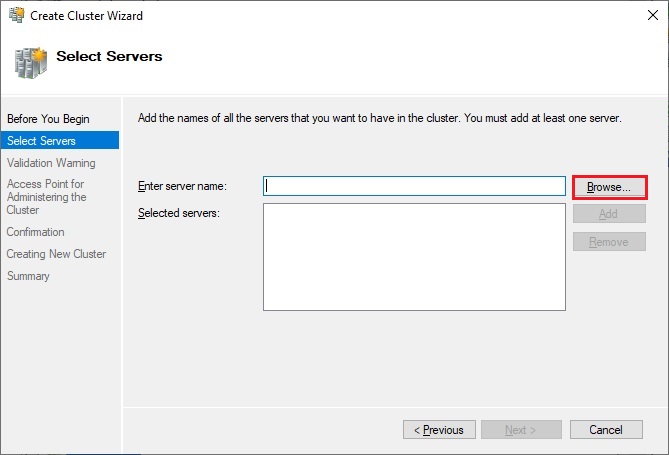
39- Type both the node names, click check names and click ok.
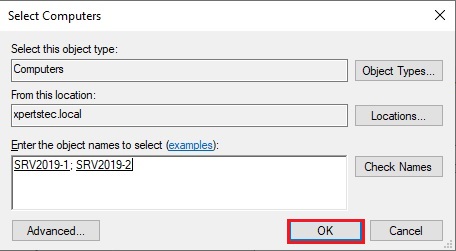
40- Both the servers nodes selected, click next.
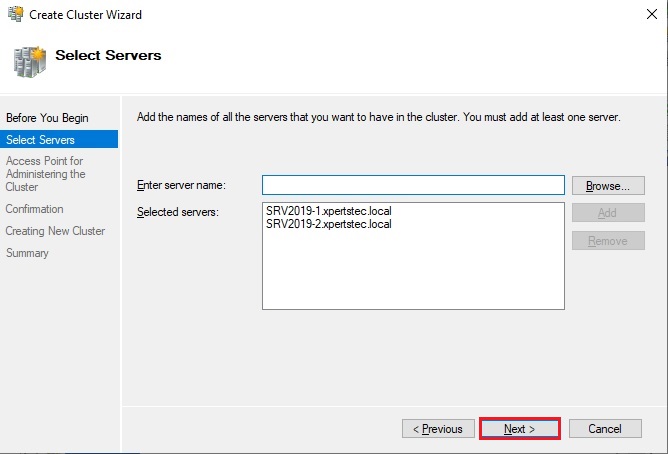
41- Type a Cluster name, select the IP address and click next.
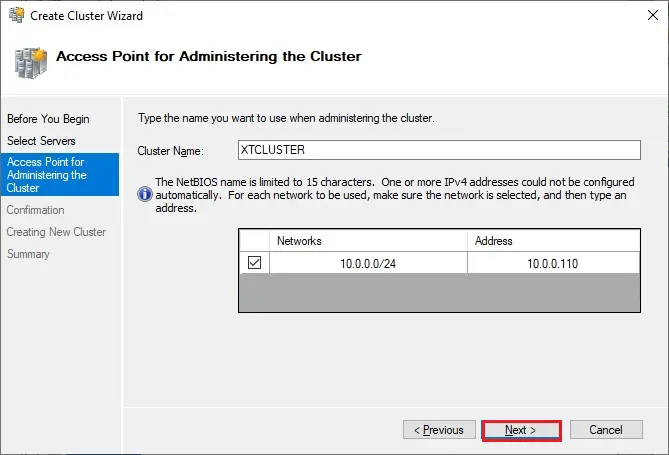
42- As a last step, confirm everything, click next and wait for the cluster to be created.
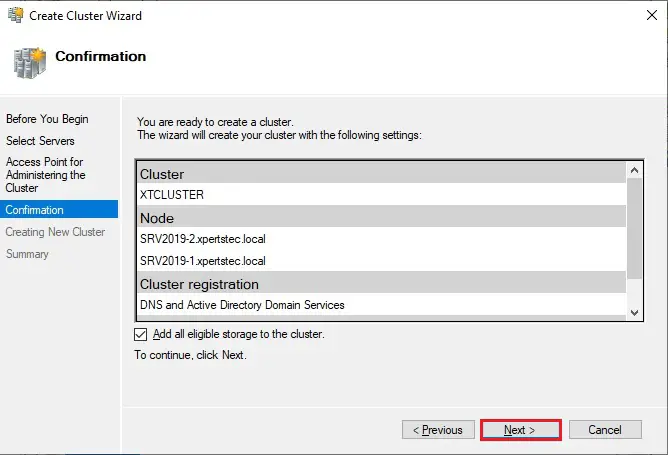
43- Cluster setup successfully completed and click Finish.
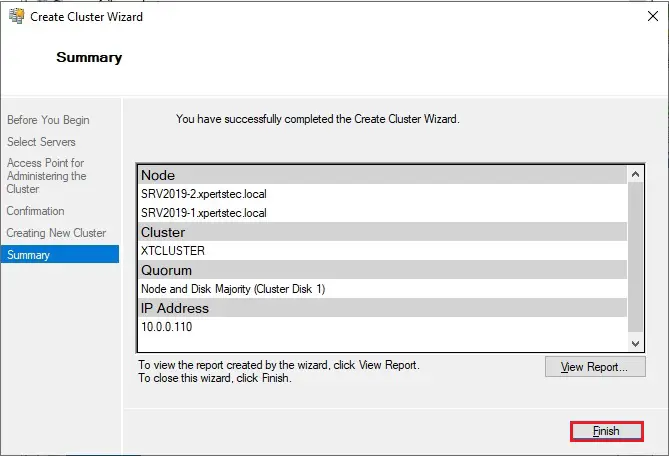
44- The wizard will add the shared disk automatically to the cluster per default. If you did not configure it yet, then it is also possible afterward. As a result, you can see a new Active Directory computer object named XTCLUSTER.
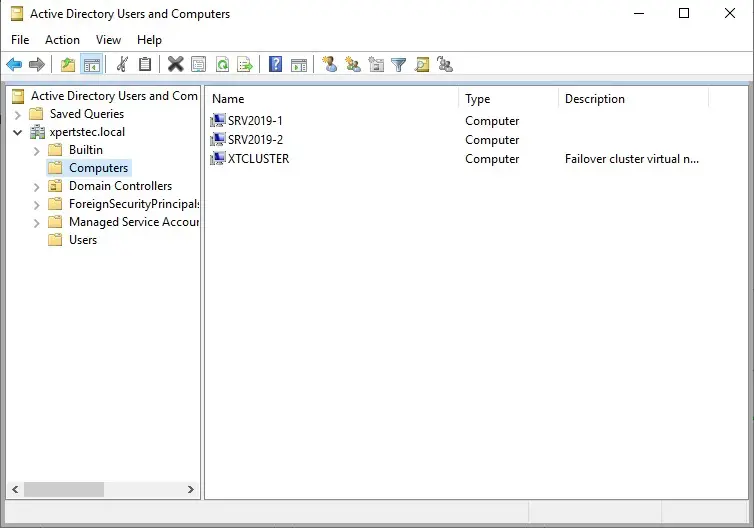
45- You can ping the new computer to check whether it is online (if you allow ping on the Windows firewall).

As an alternative, you’ll create the cluster also with PowerShell. the subsequent command also will add all eligible storage automatically:
New-Cluster -Name XTCLUSTER -Node SRV2019-1, SRV2019-2 -StaticAddress 10.0.0.110
46- Both the Nodes are up now.
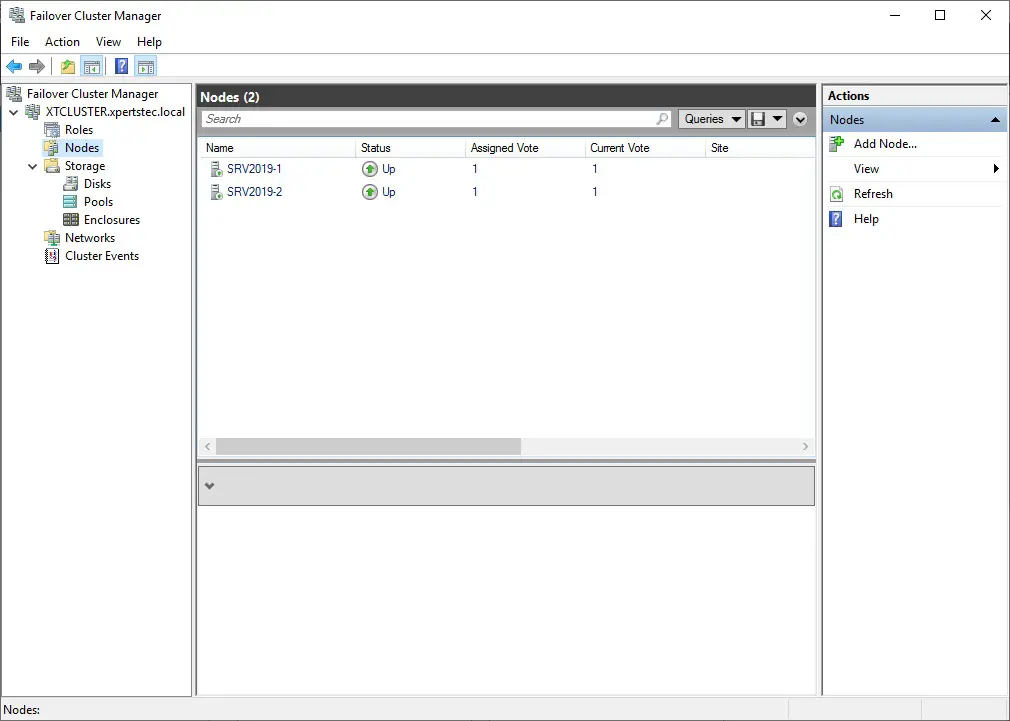
47- You can see the result in the Failover Cluster Manager in the Nodes and Storage under Disks sections.
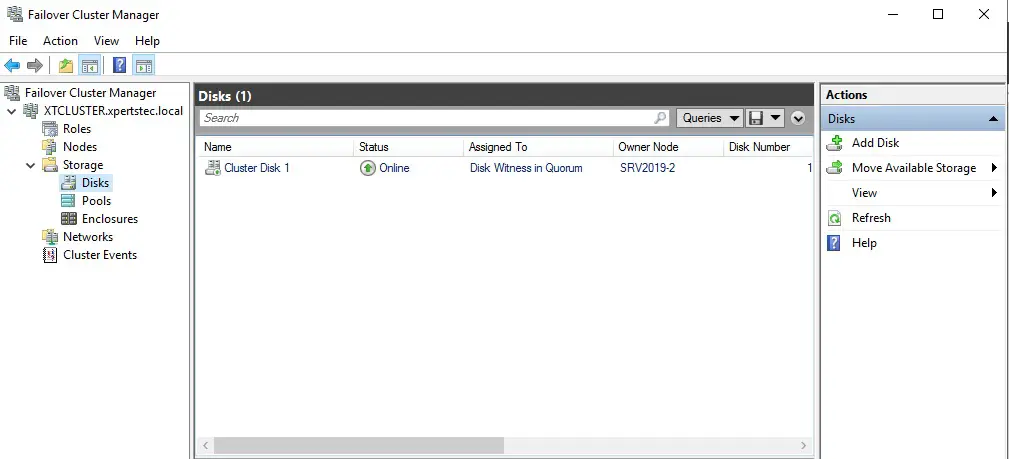
For more information click here
How to Configure Network Load Balancing In Windows Server 2019.
